|
|
Post by baz62 on Aug 27, 2014 12:42:20 GMT 12
Doh. Just realised AQK IS the aircraft Philip had at 7 Hangar! I recognised the colour scheme on the fuselage and the paint scheme on the prop blades! I actually had a look at this aircraft at Ashburton during the great Auster Club meet never realising my fingerprints were already on it!!  |
|
|
|
Post by denysjones on Aug 27, 2014 15:57:42 GMT 12
Phillip acquired AQK in September 1972 but he had to do something with it from then until late 1976 / early 1977 when we completed our first workshop at Ferrymead and it moved there.
I'd therefore suggest that the photo that Peter has put up taken of it in the front yard of a property would be from that period and again shrewd guessing would say it might be the front yard of his mother's property at Riley Cres Woolston.
Dave Duxbury, if you're following this thread, does that seem familiar ground to you? The style of houses in the shot certainly fit the bill to me.
|
|
|
|
Post by davidd on Aug 28, 2014 10:17:11 GMT 12
Denys,
When Philip Burns first acquired this Proctor (AQK) it was located just around the road from his own home in Woolston (where he was living with his mum at the time, 39 Riley Crescent from memory). The Proctor was located only a couple of streets away from Riley Crescent. Later it was re-located to R M (Ron) Fechney's airstrip on his farm (known as Omaha) and it was here that the famous "nose dive" occurred. Incidentally there is no qestion that the lack of installed elevator cables was the cause of the problem - AQK at this time was not fitted with any outer wings, nor any tail surfaces whatsoever, so the presence or otherwise of the intervening cables was irrelevant. The person who was running up the engine (a then-current RNZAF engine fitter I seem to recall; I do not recall his name, but I do recall his nickname. However, in fairness to his inexperience as a pilot, I will leave him in embarrassed anonymity) opened the engine up to full throttle, at which point the thrust was sufficient to rotate the aircraft on its (chocked) mainwheel axles, which is when the RNZAF type in cockpit seemed to freeze up. Philip apparently yelled at him to close the throttle, but either the engine noise was too great or the man in cockpit was just too slow to react, but the result was that the tail end just keept rising until the prop contacted the ground - one of the propller tips apparrently fractured at this point and was found some distance away. No doubt the engine was considerably shock loaded. Myself and another enthusiast type (I am pretty certain it was the young John Edward Macdonald, who was later killed in a microlight accident just outside Brisbane, Queensland about 1984) had just arrived on the scene, having driven out from Christchurch to witness this run up; we found AQK standing on its nose, the young RNZAF fellow in a state of shock, and poor Philip on the grass along side, asking repeatedly: "Why? Why?". I remember we assisted in getting the aircraft back on the ground again in its normal attitude with the assistance of some ropes. It took some effort with a spade to free the prop blade from the earth, as the metal blades had bent considerably, biting as they did into the sod. Cannot recall how we managed to lassoo the rear fuselage, but we did return it to earth without breaking anything else.
David D
|
|
|
|
Post by baz62 on Aug 28, 2014 12:41:24 GMT 12
I seem to recall that Philip swapped the engine out for another one? I seem to recall seeing traces of the spray on crack test (the white and pink combo) on a prop shaft but whether that was in the aircraft or sitting beside it i can't remember. I seem to recall there was a crack there? Philip would know, isnt he in Blenheim now?
|
|
|
|
Post by Peter Lewis on Aug 28, 2014 22:17:05 GMT 12
The next Proctor 5 to arrive was c/n Ae143, which became ZK-AQZ with Ernle Clark on 27Oct1948, and carried out its first flight on that same day. This aircraft had been issued with its UK CofA #10298 on 6Oct1948. It is interesting to note that this airframe was the last Proctor to be built, as those allotted c/ns Ae.144 to Ae.149 were not completed. (Note that the oft-quoted previous identity of G-AHGN for this aircraft is incorrect. G-AHGN was Proctor 5 c/n Ae44 which went to the USA in March 1950 as N558E.) Clark retained ZK-AQZ and flew it as a demonstrator, used it to operate an aerial photography business out Christchurch and, in later years, as his own personal transport. As such, it was seen throughout most of the country. He retired from active flying in 1961 and bought a farm at Kirwee, not far from Christchurch, but lived for only another three years. He died at Kirwee on 27Dec1964 aged 58, survived by his wife, three sons and a daughter. The Proctor was sold to Airwork (NZ) Ltd. of Christchurch in September 1961 who then onsold ZK-AQZ to B R R Cragg of Blenheim on 30Oct1961, replacing Bevan’s previous Proctor ZK-AQK. No doubt ZK-AQZ had seen less use and was in better condition. Alister J M Robinson of Nelson took possession on 17Jan1963, and then Scotts Engineering Limited of Christchurch bought the aircraft on 22Feb1966 (Nathan Scott having previously operated Proctor ZK-APH). Peter Dyer also of Christchurch and later a prolific sport aircraft home-builder took over ZK-AQZ on 24Apr1967 and kept the aircraft flying for the next few years until he passed the Proctor on permanent loan to the Golden Age Flying Society based at Blenheim. ZK-AQZ was still airworthy at that stage, and was flown to Omaka by Jack Moon on 10Apr1971. Also delivered to the Society was a spare zero-time engine, and the intention was to keep the aircraft flying to promote the Society. However, things did not work out as planned, and although ZK-AQZ was registered in the Golden Age Flying Society’s name on 8Sep1971, it was grounded from 9Apr1972. The Society also became involved with the proposed rebuild of Simmonds Spartan ZK-ABZ, but financial problems became too great and the Society was wound up in the mid-1970s. Fortunately in 1976 ZK-AQZ was passed on to the Sport and Vintage Aviation Society, a Masterton-based group that had similar aims. Transported to Hood airfield, Masterton, the Proctor was reassembled and was displayed there for some years as a ground-bound artifact, being registered to the SVAS on 27Mar1986. The society was then successful in obtaining Lottery Board funding that allowed their engineer Ted Ashwell to restore ZK-AQZ to airworthy condition, a major project that took three years of work and cost in excess of $60,000. Christened ‘Spirit of Wairarapa’ the Proctor first flew again after the restoration on 10Oct1993 piloted by John Lanham. At that time the airframe had flown a little over 1200hrs. ZK-AQZ was then active both at Hood and at other aviation events around the country, but proved a difficult aircraft to operate. Ryan Southam reports “I used to fly AQZ a bit a few years back. The old girl is very original to the point of sometimes being downright scary. Its not a particularly nice aeroplane to fly, is quite slow, can bite given half a chance, is expensive to operate (probably no more, except for fuel used, than a Piper Arrow however) but having said all that I still enjoyed flying it and given the opportunity again would jump at the chance.” I last saw ZK-AQZ out in the sunshine in 2002, and it seems to have been grounded again at Masterton since around that time. It was advertised for sale in 2011, but is unsold still stored in the SVAS hangar together with their other aircraft. ZK-AQZ brand new at Mangere 19Mar1949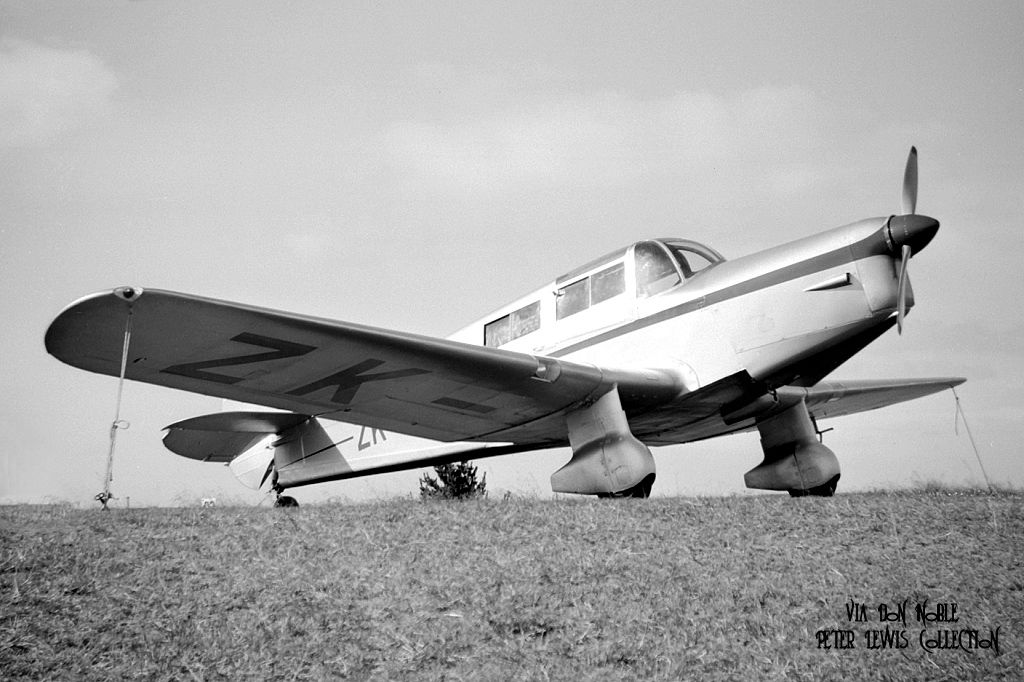 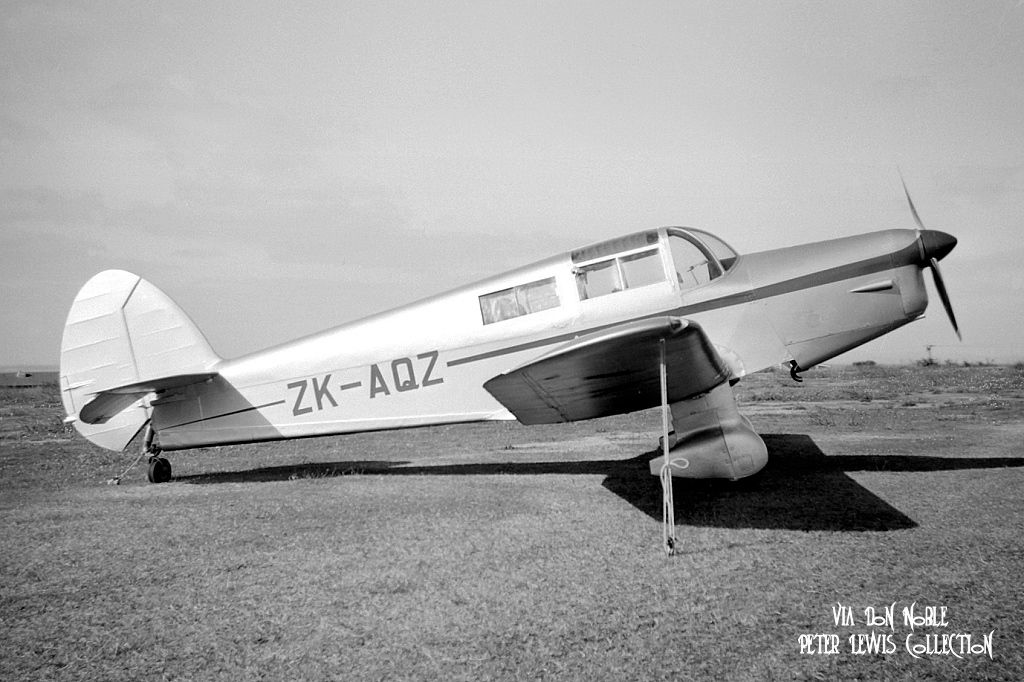 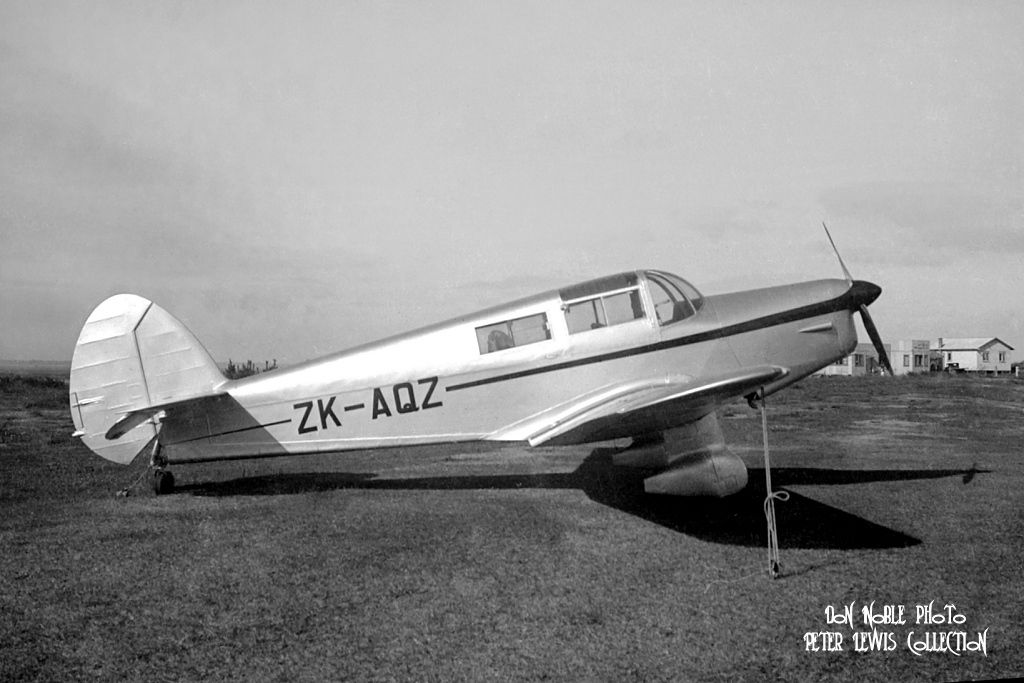 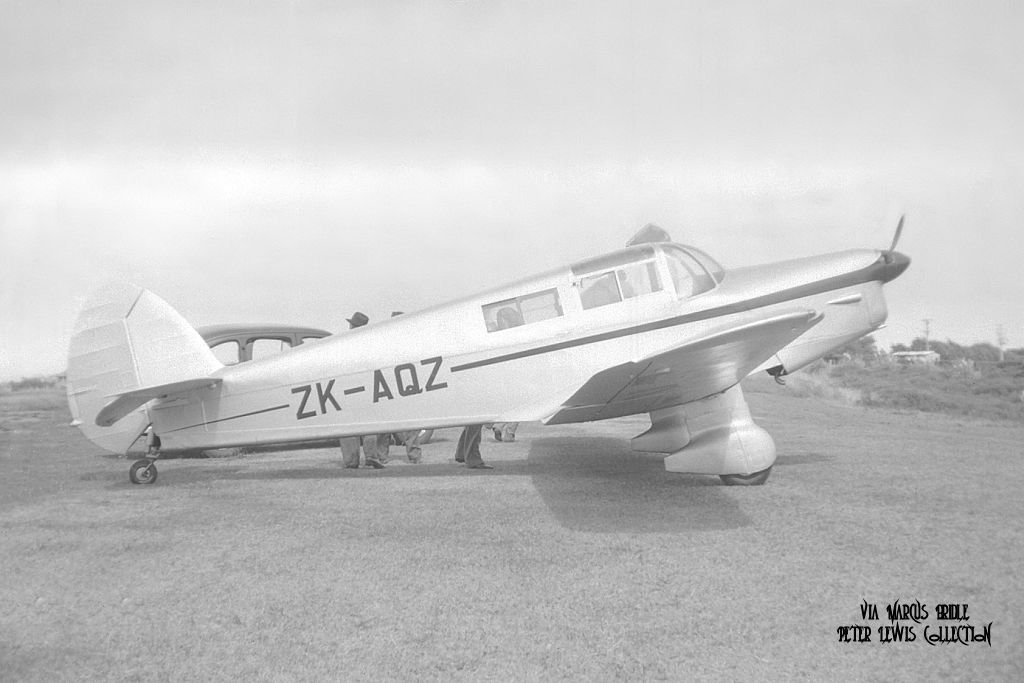 Visiting Rongotai 13Dec1949 Visiting Rongotai 13Dec1949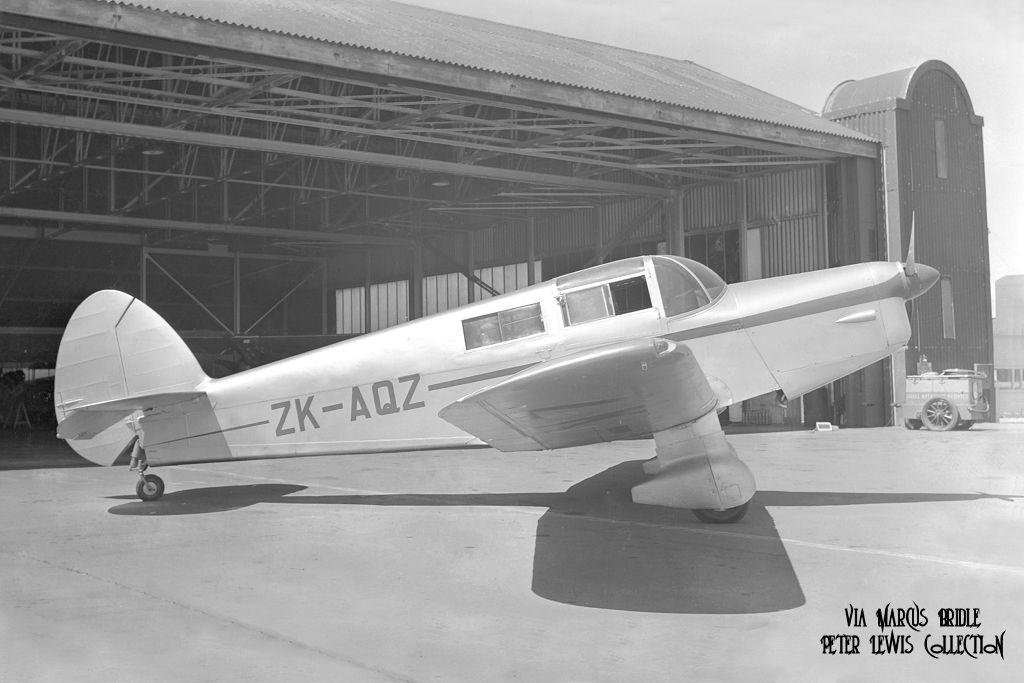 Outside its home hangar at Harewood, Christchurch, 17Mar1954 Outside its home hangar at Harewood, Christchurch, 17Mar1954. Second livery.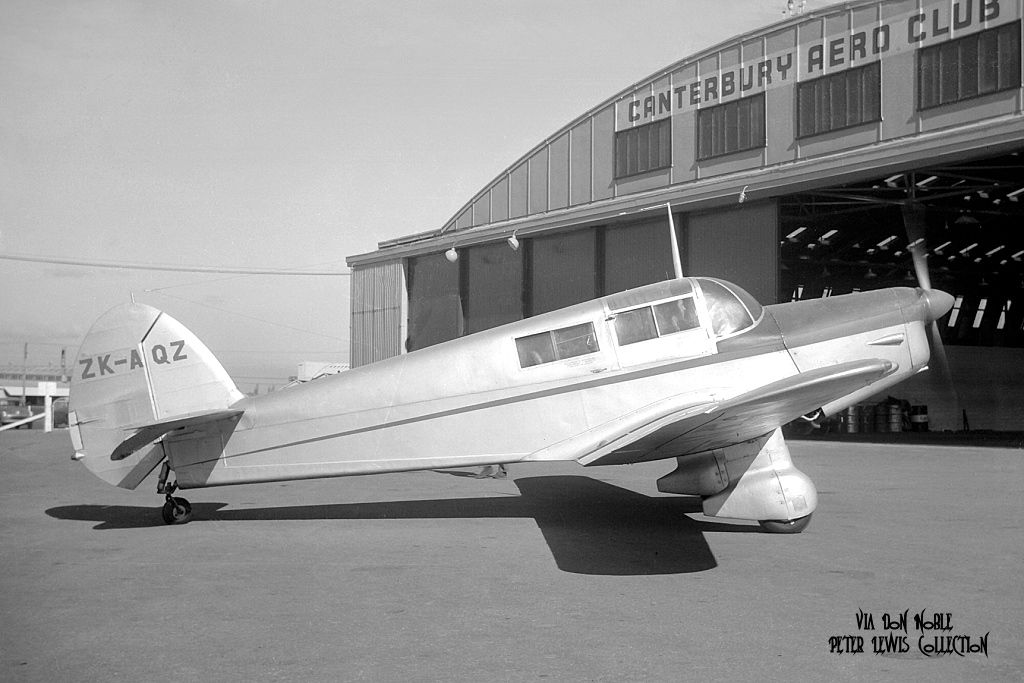 ZK-AQZ repainted into more attractive colours. Fenton Street airfield, Rotorua ZK-AQZ repainted into more attractive colours. Fenton Street airfield, Rotorua, 9Mar1963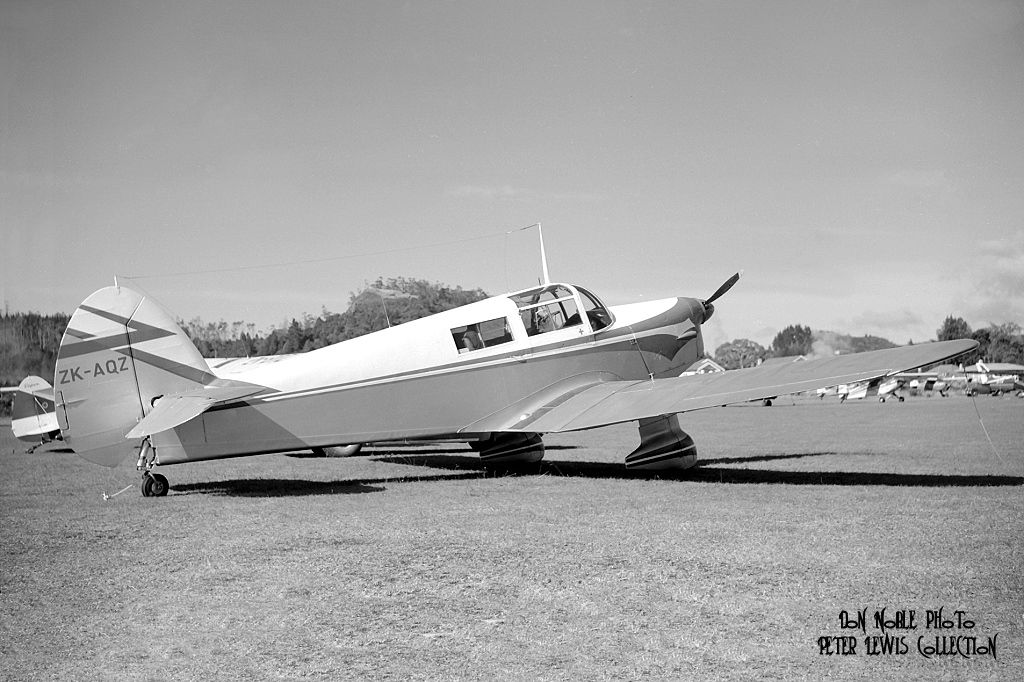 . . .and back at home base in Christchurch. The presence of Cherookee 235 ZK-CEH in the background dates this to 1964-73. . . .and back at home base in Christchurch. The presence of Cherookee 235 ZK-CEH in the background dates this to 1964-73. Taken while on a visit to Ardmore. Taken while on a visit to Ardmore. 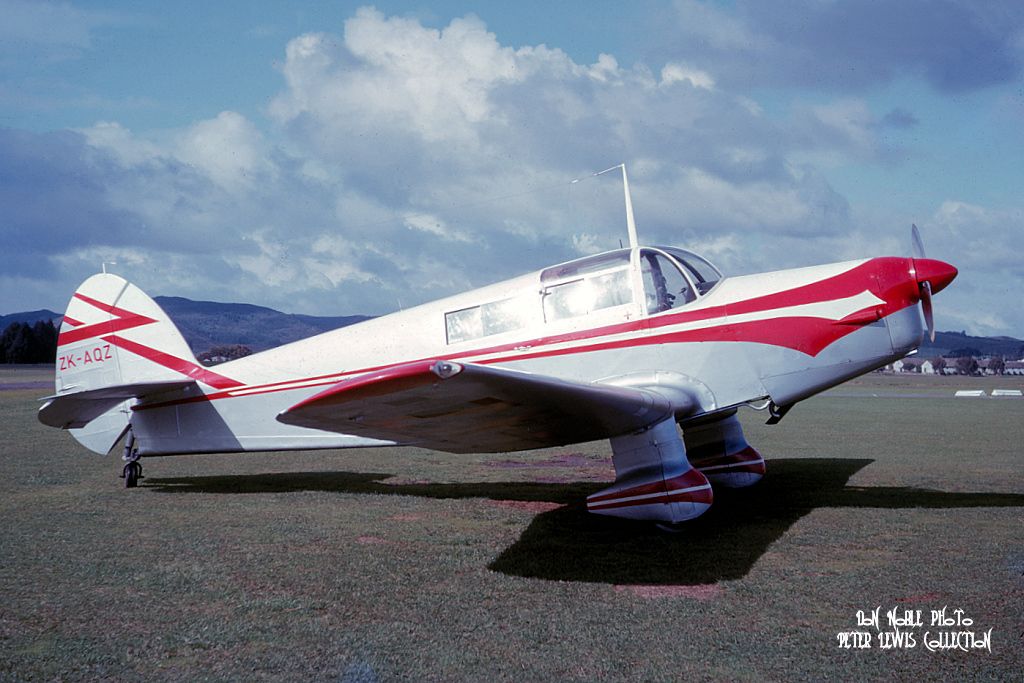 ZK-AQZ at Harewood while owned by Bevan Cragg, early 1960s ZK-AQZ at Harewood while owned by Bevan Cragg, early 1960s Mixing it with the big boys at Harewood Mixing it with the big boys at Harewood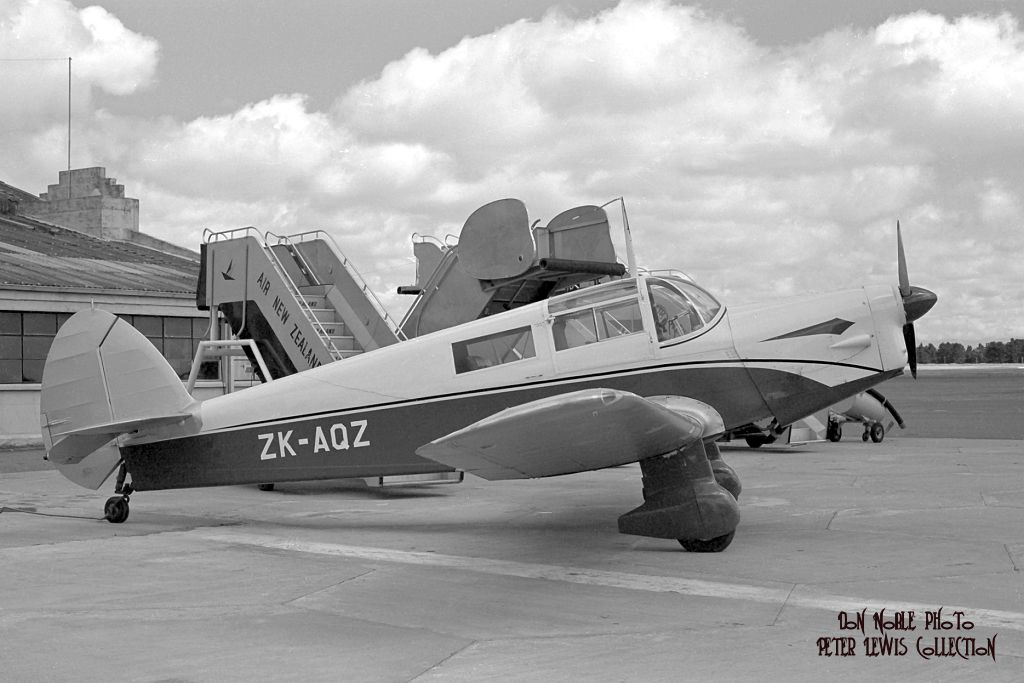 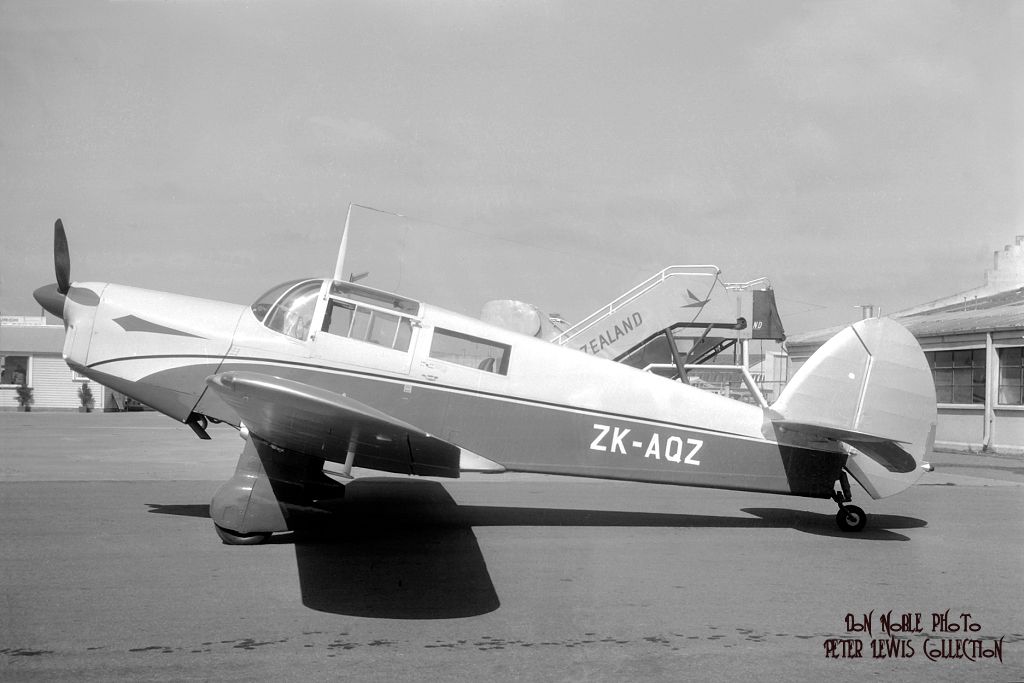 At Timaru, while with Scotts Engineering At Timaru, while with Scotts Engineering 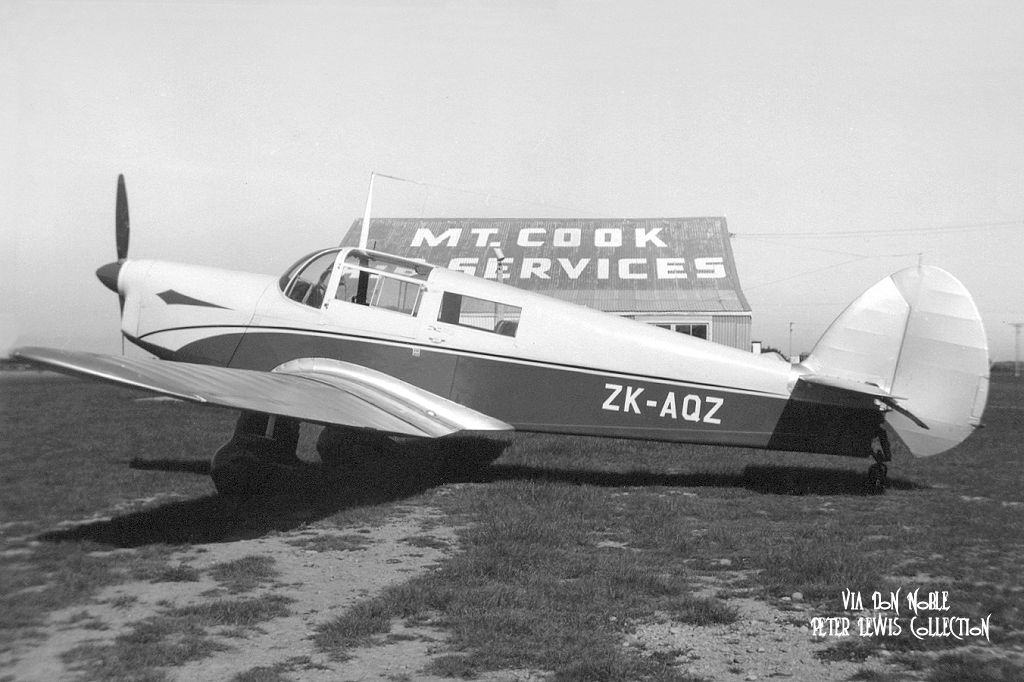 While with Peter Dyer it carried his 'Speedway Safety Products' company logo. Ardmore 30Oct1969. While with Peter Dyer it carried his 'Speedway Safety Products' company logo. Ardmore 30Oct1969.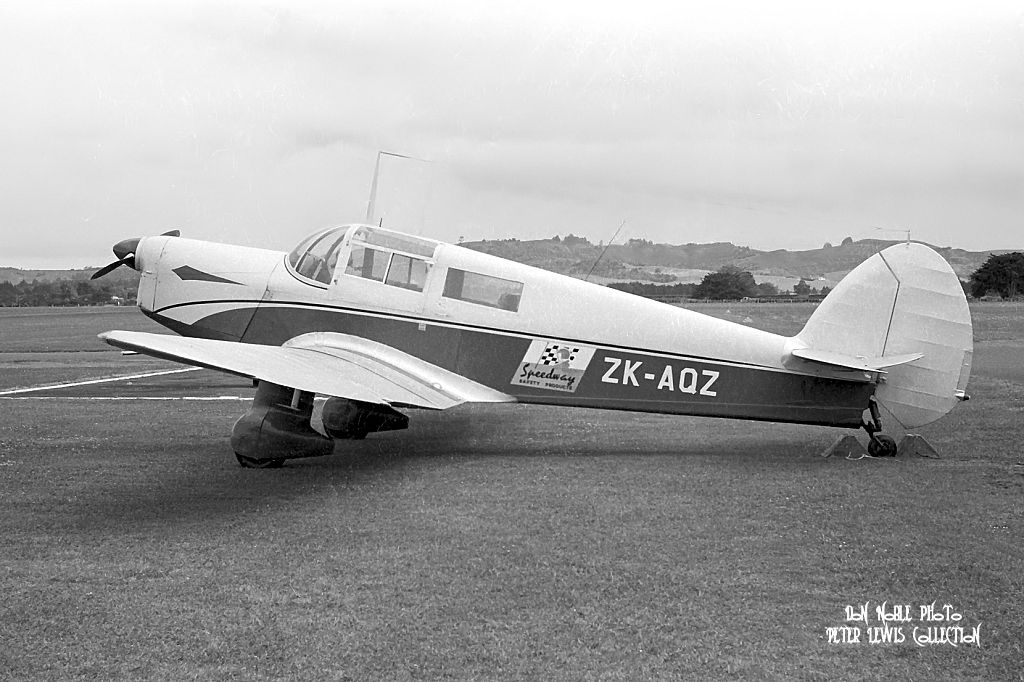 ZK-AQZ at Ardmore, December 1969 ZK-AQZ at Ardmore, December 1969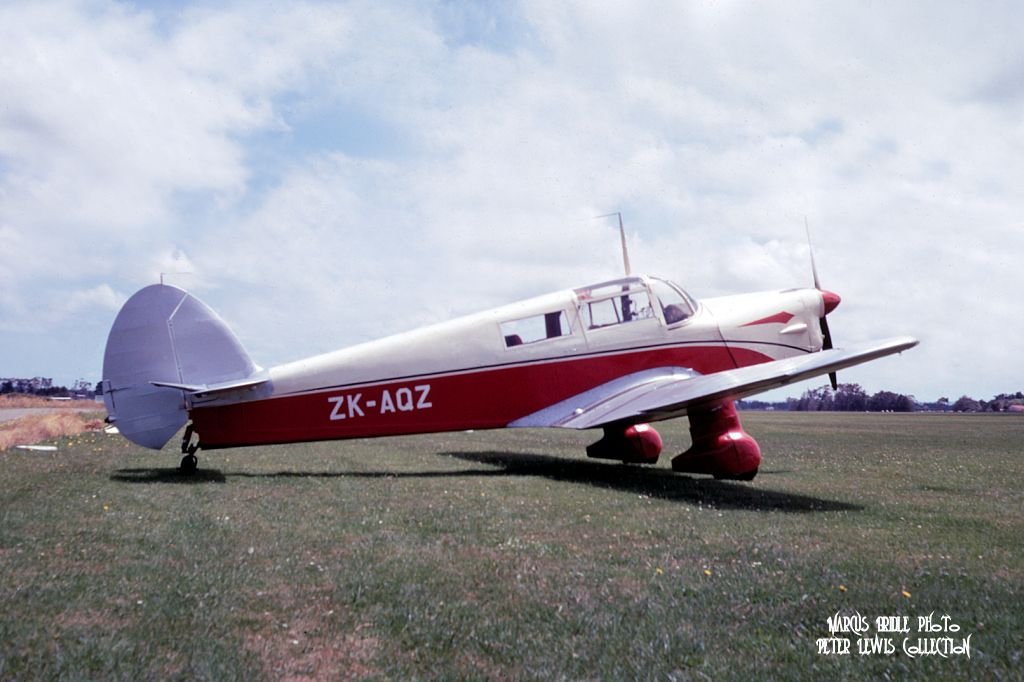  At Hastings 15Jan1972 representing Golden Age Flying Society At Hastings 15Jan1972 representing Golden Age Flying Society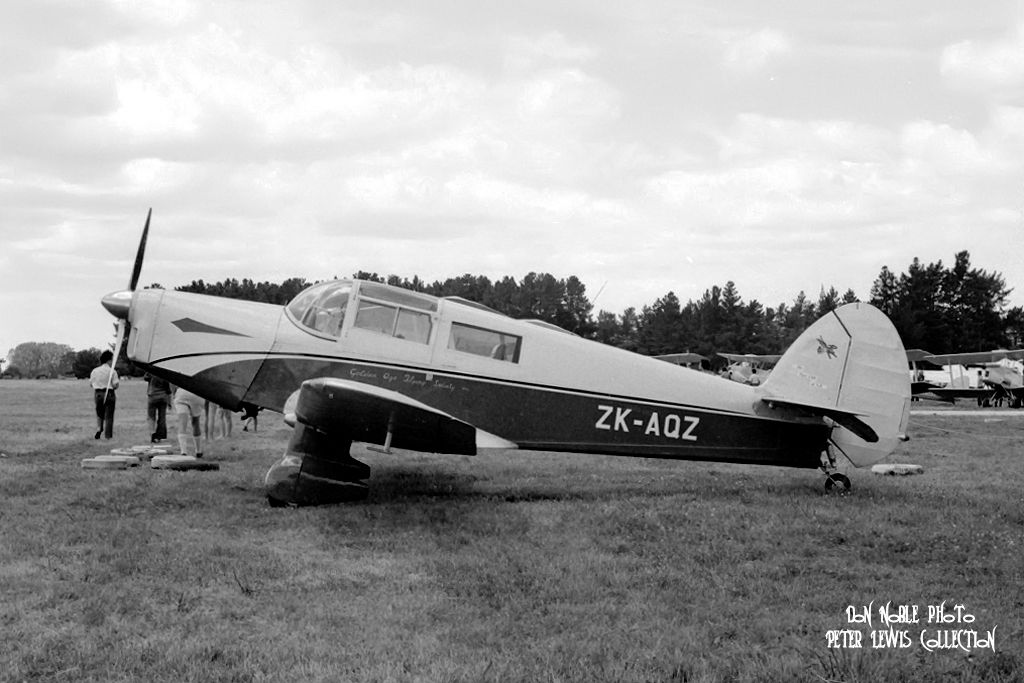 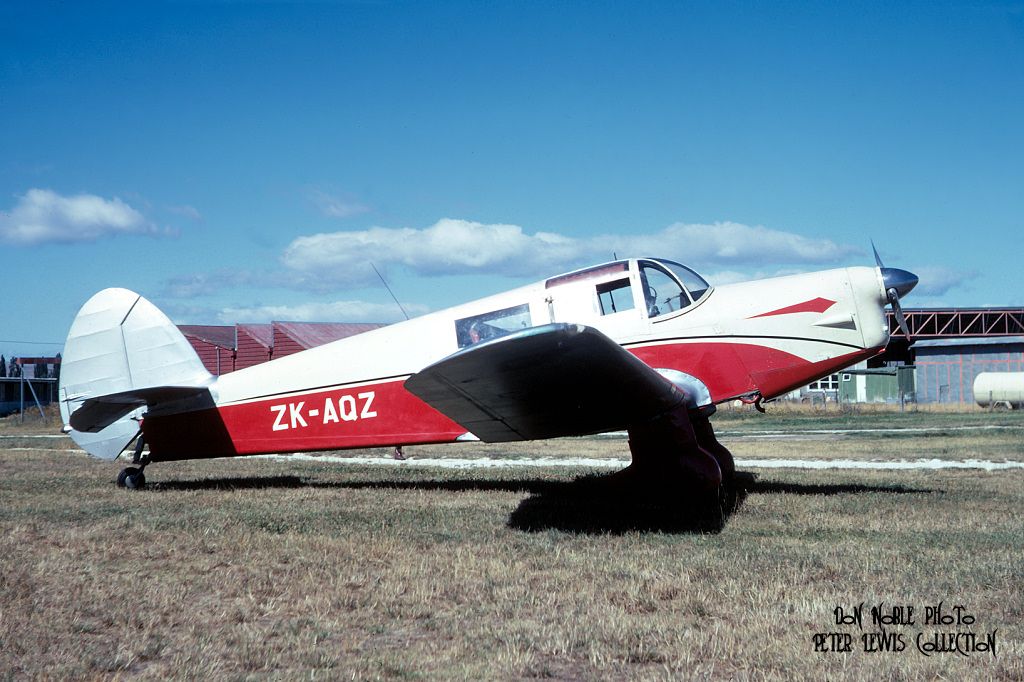 Masterton 22Jan1977, grounded Masterton 22Jan1977, grounded 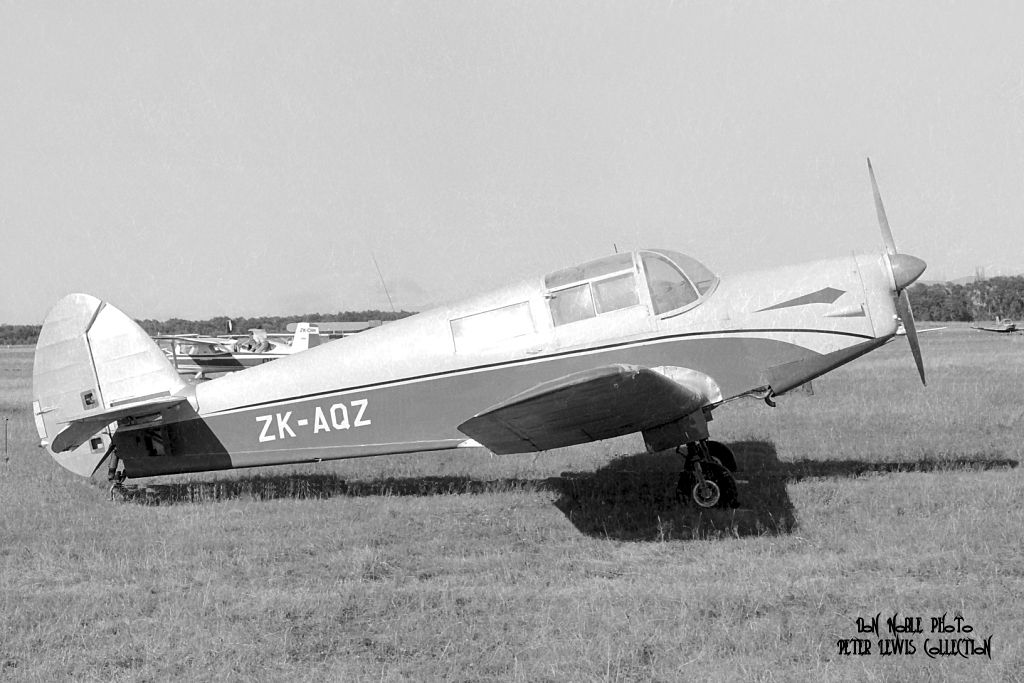 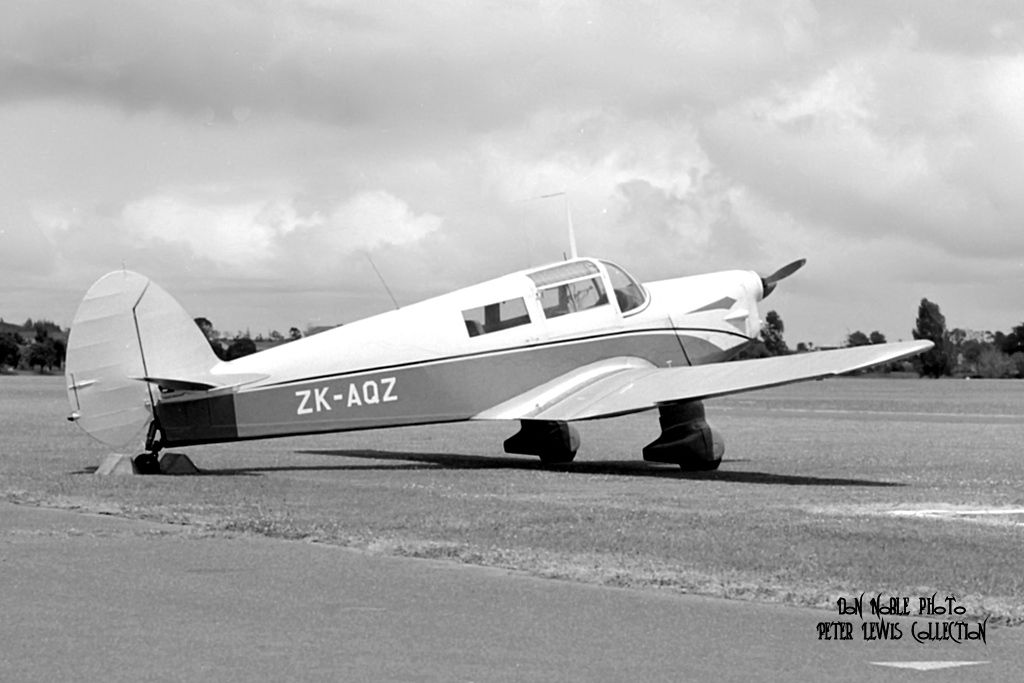  Static at Fielding while with SVAS Static at Fielding while with SVAS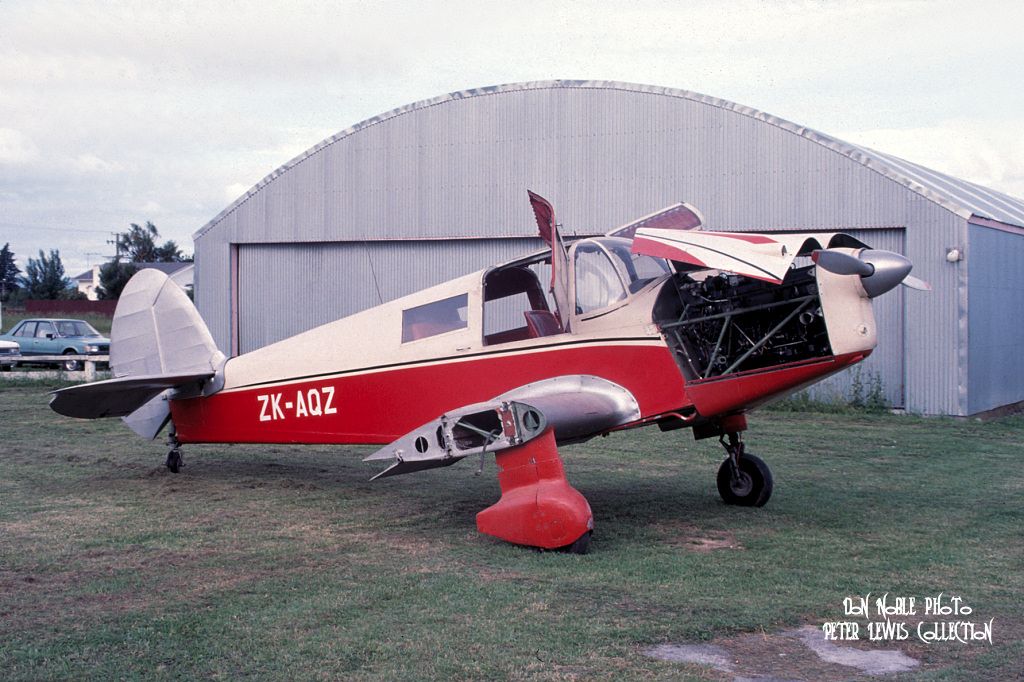 Nicely restored to airworthy by Ted Ashwell, ZK-AQZ at Wanaka April 1994 Nicely restored to airworthy by Ted Ashwell, ZK-AQZ at Wanaka April 1994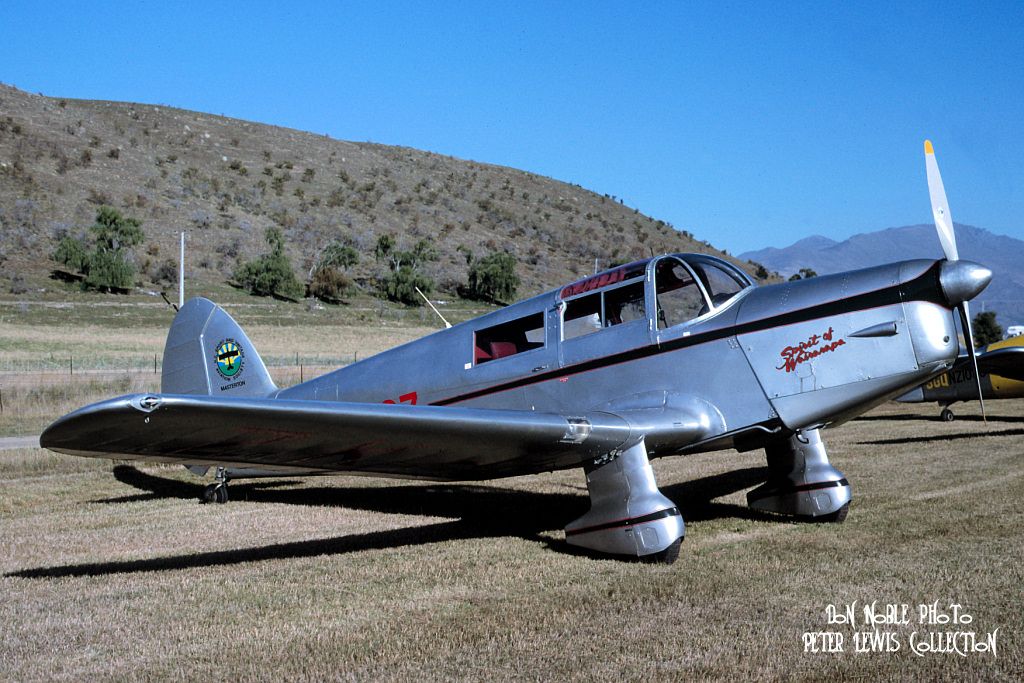  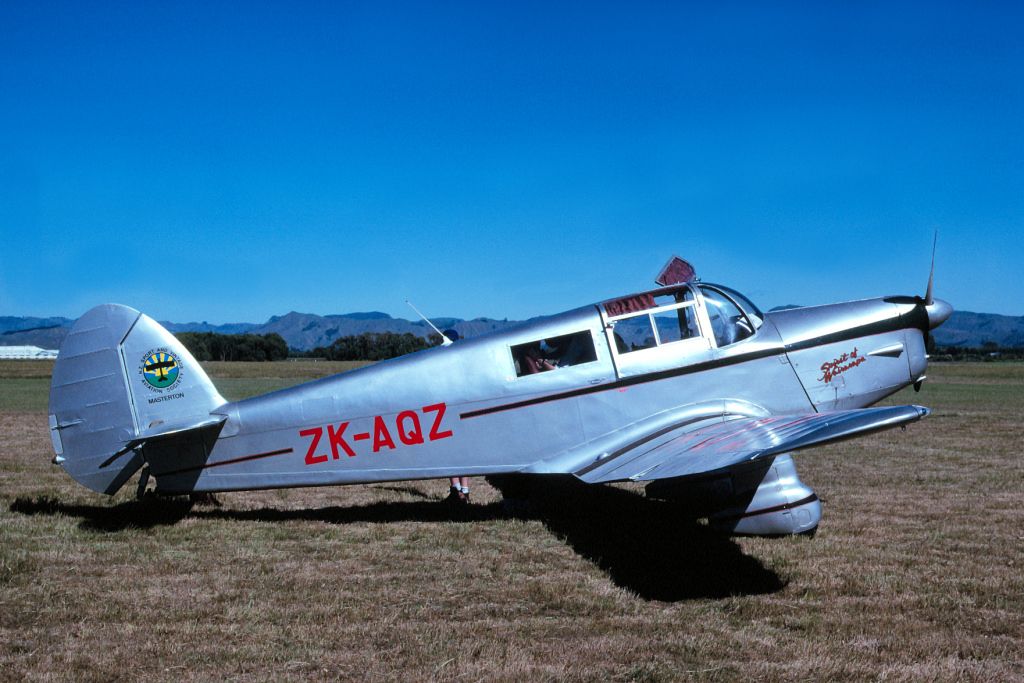 At Hokitika December 1994 At Hokitika December 1994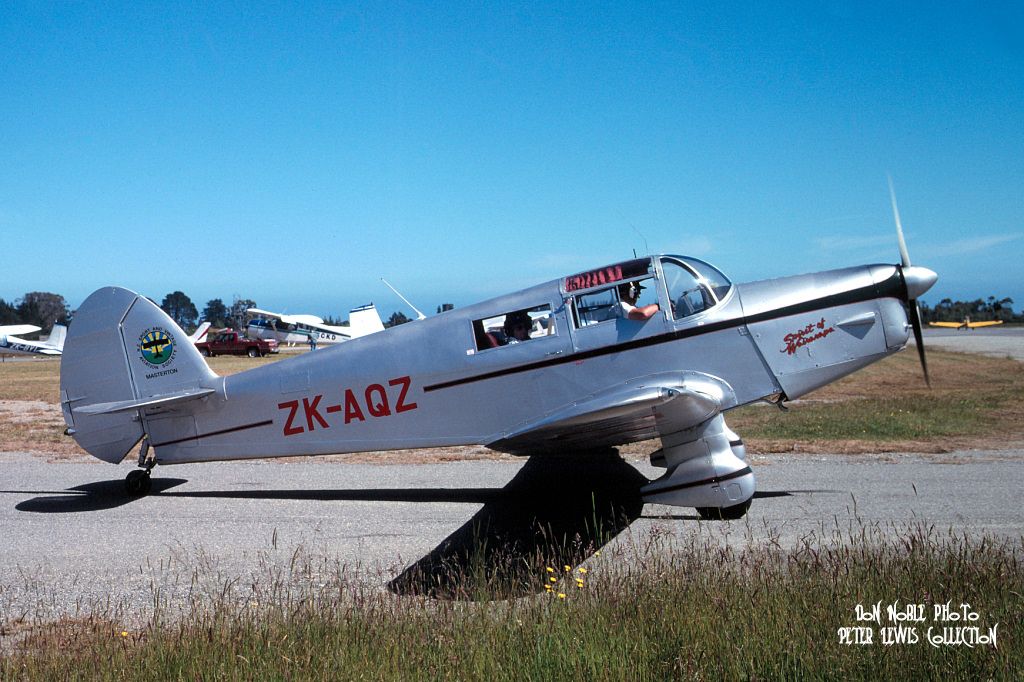 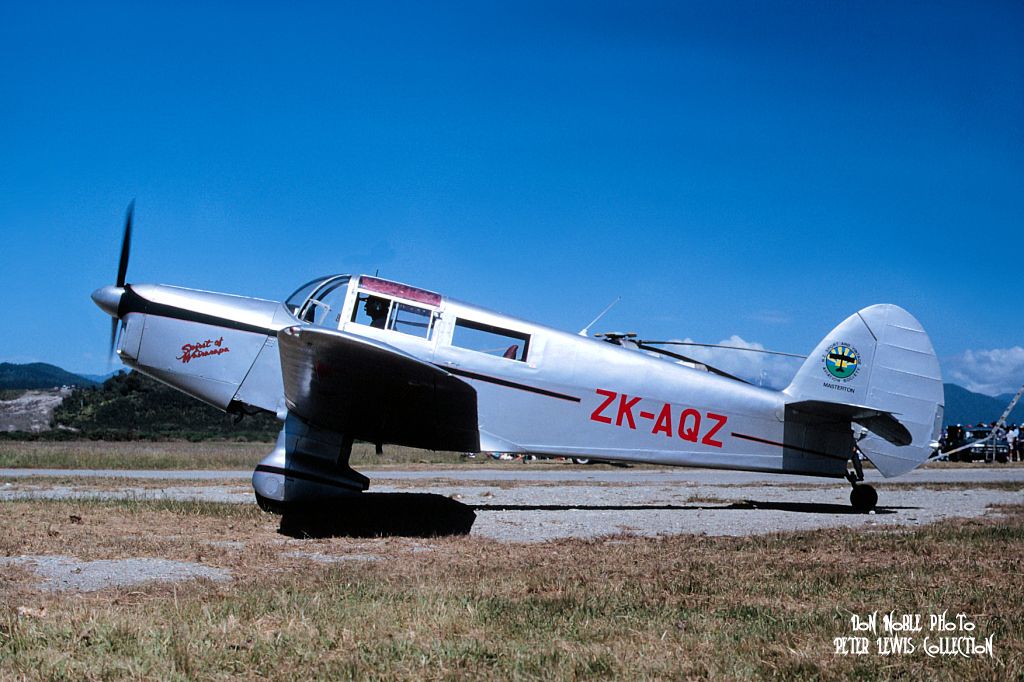 SVAS outing saw ZK-AQZ at Gisborne 15Mar1997 SVAS outing saw ZK-AQZ at Gisborne 15Mar1997 The last time I saw Proctor 5 ZK-AQZ out in the sunshine - Hood airfield, Masterton, 2002 The last time I saw Proctor 5 ZK-AQZ out in the sunshine - Hood airfield, Masterton, 2002 |
|
|
|
Post by Peter Lewis on Aug 31, 2014 18:02:58 GMT 12
Proctor 5 c/n Ae23 was built in 1946 and was registered as G-AHGO to Hunting Air Travel Ltd. on 9Jun1948. During this time it carried the name ‘Duiker’. Ownership passed to Field Aircraft Services at Croydon on 22May1947. The British registration was cancelled on 3Jun1948. Arriving in New Zealand, it became ZK-ARA with L E Clark on 9Sep1948, but ownership passed to E J Bland of Rakaia on 26Oct1948. I do not know any details about Bland, or to what use he put the Proctor, but only that he named ZK-ARA “The Wendy Rose’, a name that it carried for the rest of its existence. The next owner of ZK-ARA was E G Bland, presumably a family relative of E J. Meanwhile the Middle Districts Aero Club based at Milson, Palmerston North, had invested in two Austers Autocrats, ZK-AUG and ZK-AWH, to allow their members to progress up from Tiger Moths. Unfortunately ZK-AUG was destroyed in a crash near Hanmer Springs in November 1950. Less than a year later, in October 1952, the club lost Tiger Moth ZK-BBH in a crash at the Wanganui airfield. With the resultant insurance money the MDAC bought Proctor 5 ZK-ARA from the Blands for £800. The aircraft was registered into MDAC ownership on 18Oct1952, and was said to be a popular aircraft within the club. Five years later, on 25Jul1957, Aviation Sales and Service Ltd., based at nearby Feilding, became the owners for almost exactly a year before passing it on to Rolvin Airways back at Milson on 22Jul1958. Rolvin already operated Proctor 5 ZK-APH. ZK-ARA was withdrawn from use at Milson around 1963, and the fuselage sat outside the Palmerston North Flying School premises for some years. No doubt part from this aircraft went into keeping ZK-APH flying, and when Frank Brittain was rebuilding Proctor 5 ZK-ARP at Milson a few years later he also utilized parts from ZK-ARA. The registration was cancelled on 1Jul1969 and the remnants were eventually burnt by the airport fire service. ZK-ARA at Paraparaumu in 1950. The titling 'The Wendy Rose - Ashburton' can clearly be seen.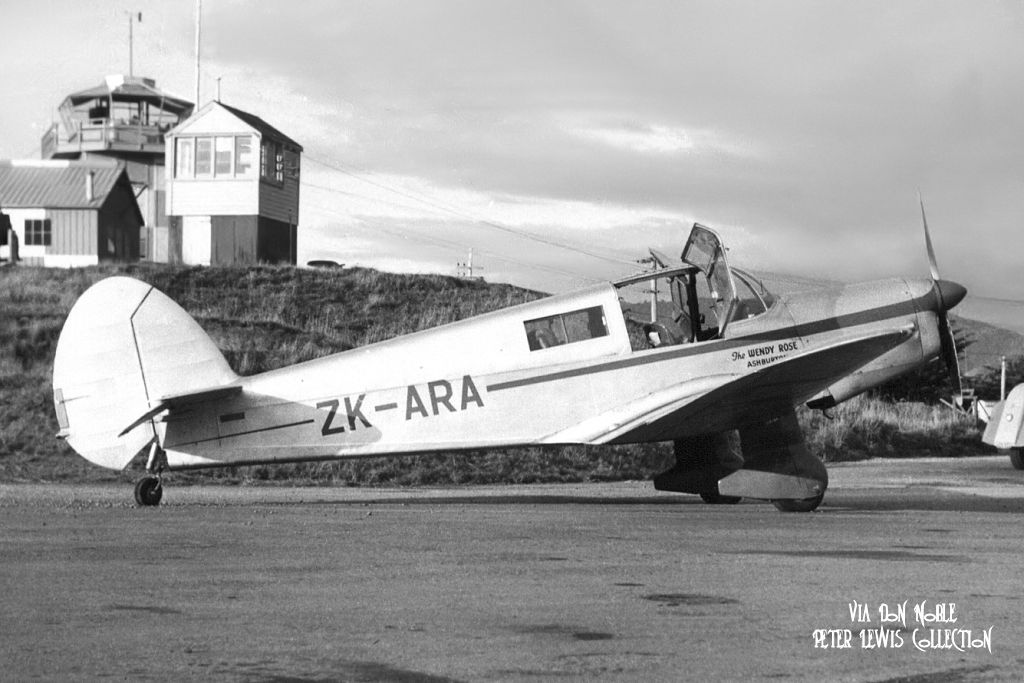 ZK-ARA in the company of a couple of happy fellows ZK-ARA in the company of a couple of happy fellows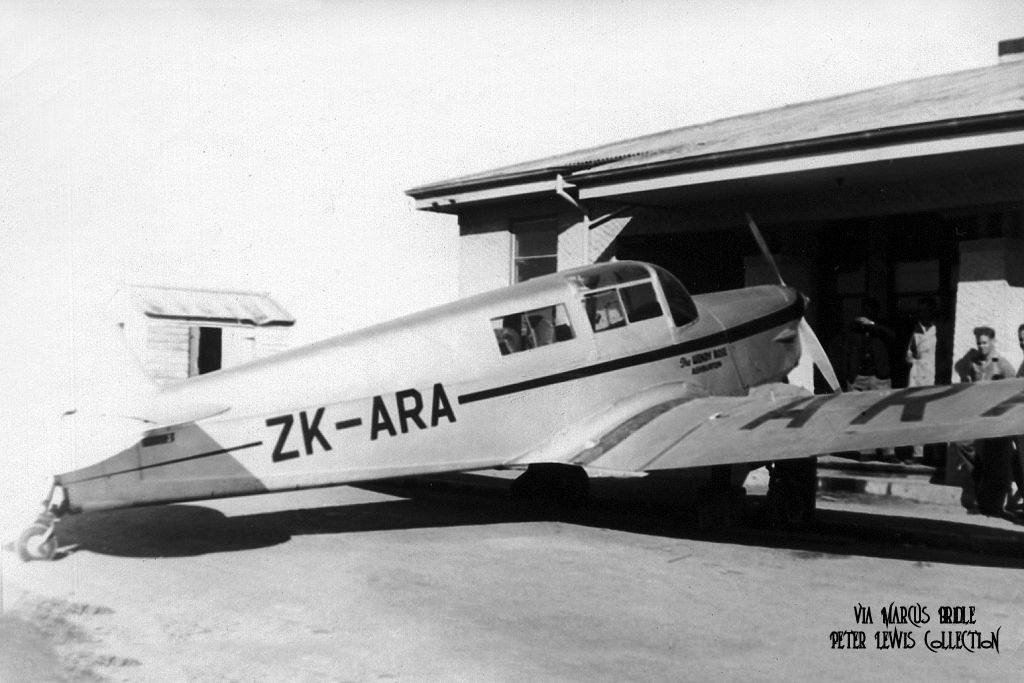 Proctor 5 ZK-ARA in MDAC colours at Milson 14Aug1954. 'The Wendy Rose' is now subtitled 'Palmerston North' Proctor 5 ZK-ARA in MDAC colours at Milson 14Aug1954. 'The Wendy Rose' is now subtitled 'Palmerston North' The name was carried on both sides of the aircraft. The name was carried on both sides of the aircraft. Part of a club lineup Part of a club lineup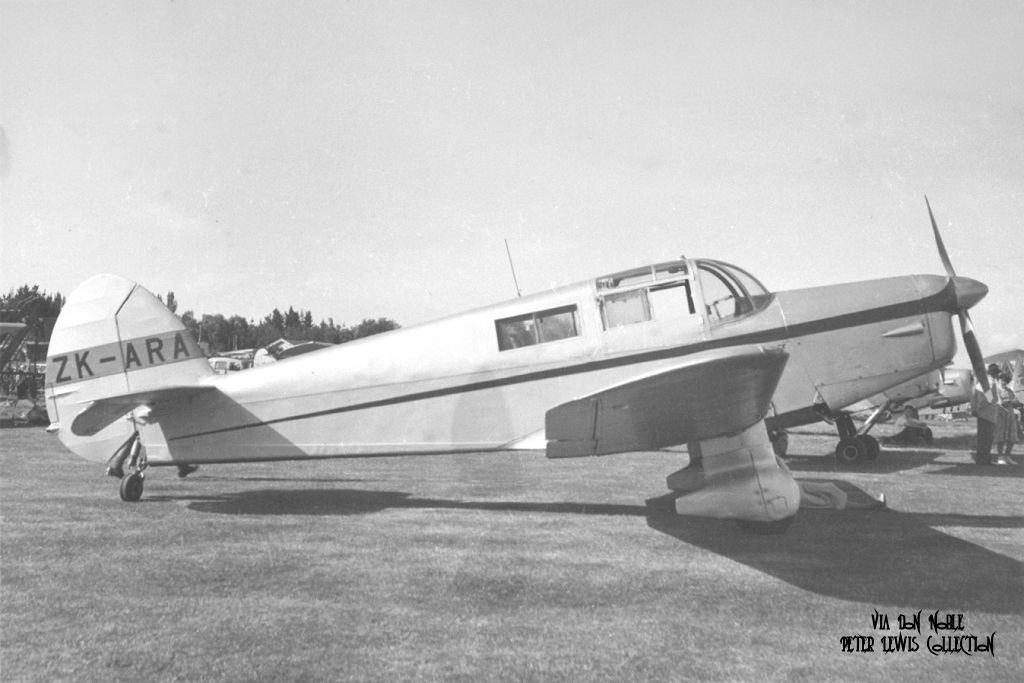
ZK-ARA now out of the air and derelict at Milson 28Aug1966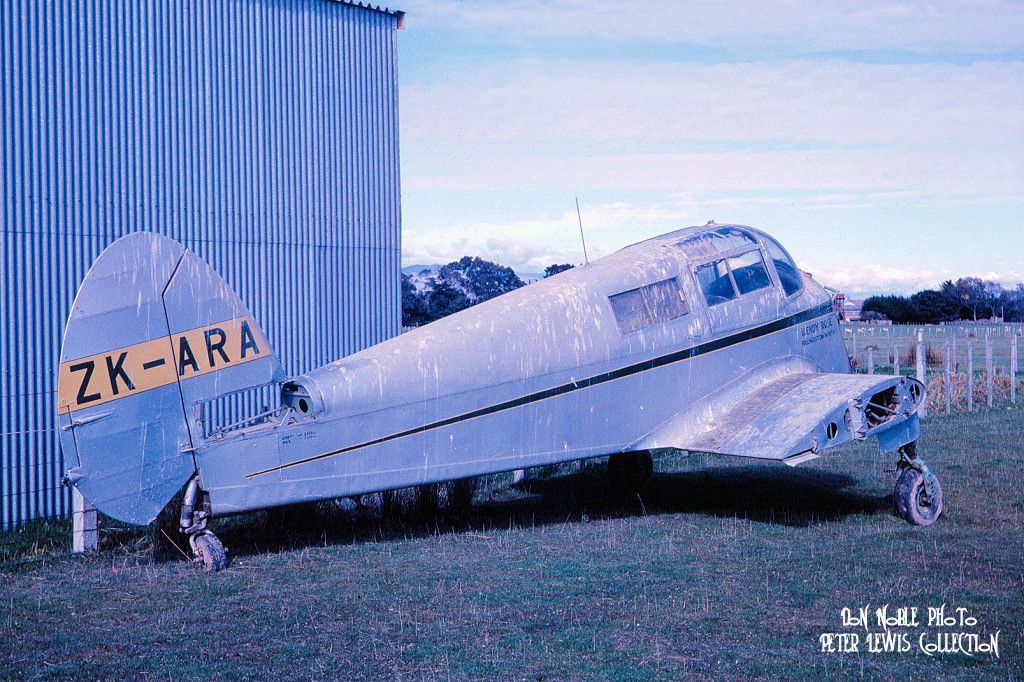 Obviously she'd had a bit of a washdown by 26Mar1967 Obviously she'd had a bit of a washdown by 26Mar1967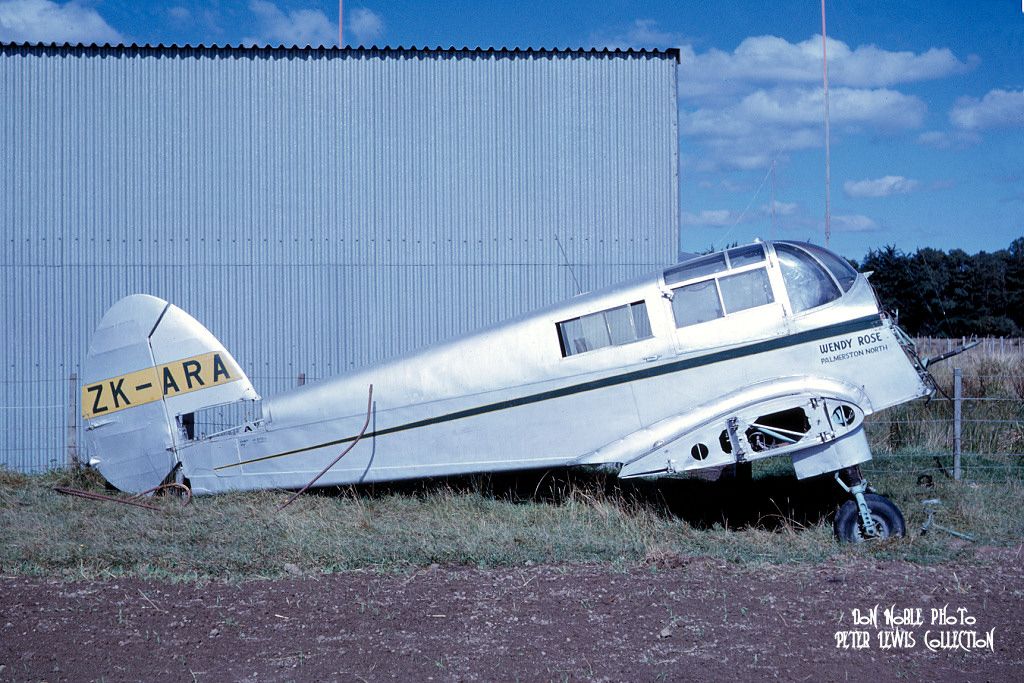 |
|
|
|
Post by errolmartyn on Aug 31, 2014 18:50:56 GMT 12
Found this little item about E J Bland:
Private Airfield
An airfield now ready for general use has been established at Highbank, Ashburton County, by Mr E. J. Bland at his own expense. The property, which has an area of 90 acres, will be principally for his own use, but the Canterbury Aero Club and the Mid-Canterbury branch will also have the use of it, and it will also be a centre for the training of ATC personnel and others wishing to fly. There are four runways up to 2800ft in length, and it is hoped to erect two hangars, one for Mr Bland's private aircraft and another for visitors.
(New Zealand Flying, February 1949)
|
|
|
|
Post by Peter Lewis on Aug 31, 2014 20:52:55 GMT 12
Thanks for that Errol.
I wonder how long that airfield lasted?
Doesn't appear to be listed under Ashburton, Rakaia or Highbank in my 1964 issue of Whites Air Directory.
E J Bland replaced the Proctor in 1951 with a new Auster Autocar ZK-AYQ, which he later sold to James Aviation. I cannot find any further aircraft registered in his name.
|
|
|
|
Post by Peter Lewis on Sept 2, 2014 19:34:01 GMT 12
Ernle Clark planned to import two more Proctor 5 aircraft.
Registrations were allotted, ZK-ARG for c/n Ae.115 and ZK-ARH for c/n Ae.118.
However, the market for new Proctors in New Zealand had dried up. The increased availablity of Austers, which combined lower running costs and better short strip performance, had driven the Proctor out.
Neither of these two aircraft were imported.
Proctor 5 c/n Ae.115 was registered as G-AMED to Field Aircraft Services on 16Nov1950 and title was transferred to the aircraft sales firm of R K Dundas Ltd., London, on 2Oct1952. The aircraft departed the UK for Dakar where it became F-OAMF and the UK registration was cancelled on 4Oct1952.
Proctor 5 c/n Ae.118 is listed as 'not sold' and its construction is believed to have been not completed.
|
|
|
|
Post by Peter Lewis on Sept 4, 2014 22:35:52 GMT 12
Proctor 5 c/n Ae.97 was built in 1946 and became G-AIEO with R K Dundas Ltd. on 26Sep1946 with its UK CofA being issued on 24Oct1946. Having clocked up just 50mins on test flying, it was shipped out on the Shaw Savill freighter ‘Pakeha’ to arrive in New Zealand on 28Aug1948. The Wairarapa and Ruahine Aero Club, based at Hood airfield Masterton, had bought the aircraft and the Proctor was registered to them on 13Aug1948 as ZK-ARP. The British registration G-AIEO was not cancelled until 24Nov1948. From some time in late 1950 the Wellington Aero Club had hired the Proctor, and on 29Jun1951 they bought ZK-ARP as a replacement for their now-sold Vega Gull ZK-AKV. Prior to the commencement of the NZNAC Heron operations, the WAC found good business in running an air-taxi service between Rongotai and Omaka. At busy times the Proctor and their other cabin aircraft could complete up to seven return trips per day on this route. By 1958 the club had bought a Cessna 180 for their charter work and the Proctor was sold to private owner G M Newcombe, also based at Wellington. The transfer took place on 28Mar1958, and Gordon Newcombe apparently used ZK-ARP to commute in his business Soil and Pasture Services Ltd. In 1959 the Proctor was retired and stored at Paraparaumu. Ex-Wellington aero club instructor Frank Brittain bought ZK-ARP on 17Jun1960 and flew it to Palmerston North. Unhappy with the state of the aircraft, he then dismantled and rebuilt the Proctor to flyable condition and had it back in the air by 1964. Frank had moved from Wellington to Palmerston North in November 1957 and had established an aviation business ‘Airspares’ at Milson airport. He retired ZK-ARP back into the hangar there in 1969. After a second round of rebuilding work, which included parts from locally retired Proctor 5 ZK-ARA, the newly airworthy aircraft was ready to fly again on 9Dec1977, but a last-minute radio fault delayed the test flight until the following day. Frank called ZK-ARP ‘Gertie’, but I have seen no evidence that this was actually painted on the airframe. Hangared at Milson, Frank Brittain then occasionally flew the Proctor up until his death in February 1992. The Proctor was later put up for sale. Bought by a syndicate which included Stan Smith, ZK-ARP was moved to Stan’s North Shore airfield premises, made airworthy once again, and has ever since been operated from that base. The ownership transfer to the ARP Syndicate was dated 14May1997. Proctor 5 ZK-ARP of the Wairarapa & Ruahine Aero Club visiting Bridge Pa, Hastings, 5Nov1949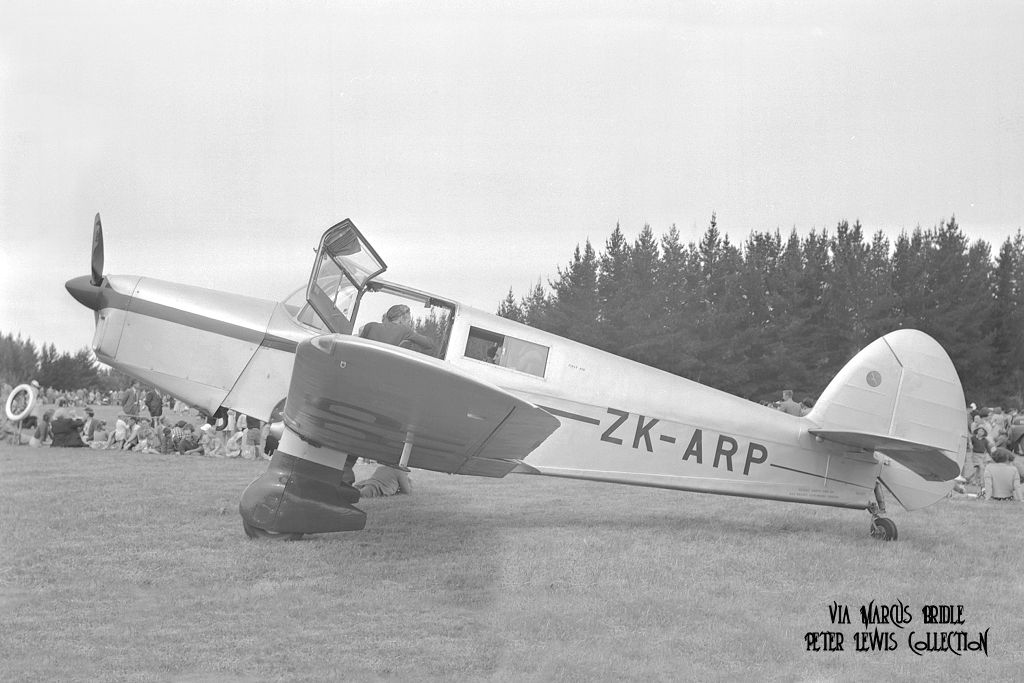
Overhead the crowd at Bridge Pa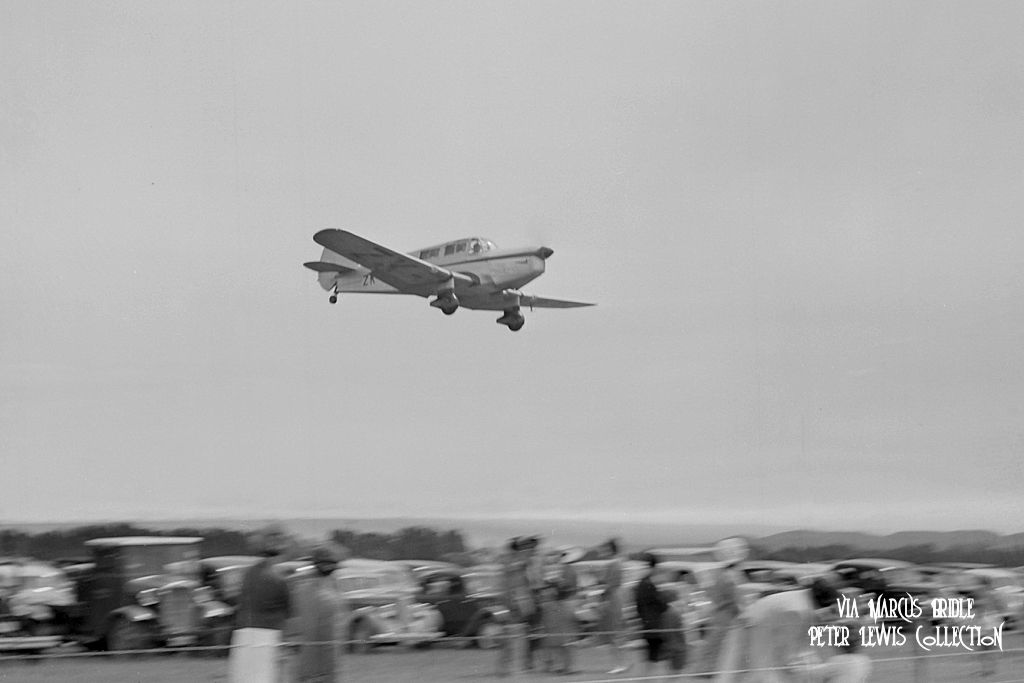 Visiting Mangere, while with WRAC Visiting Mangere, while with WRAC 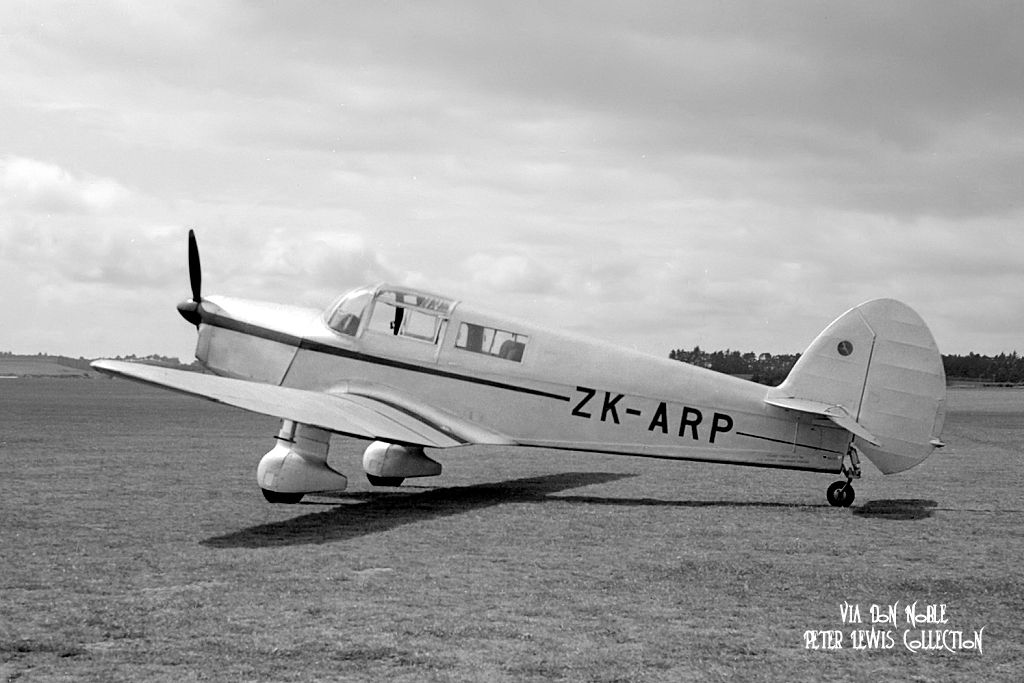 Now at Rongotai under Wellington Aero Club ownership, April 1952 Now at Rongotai under Wellington Aero Club ownership, April 1952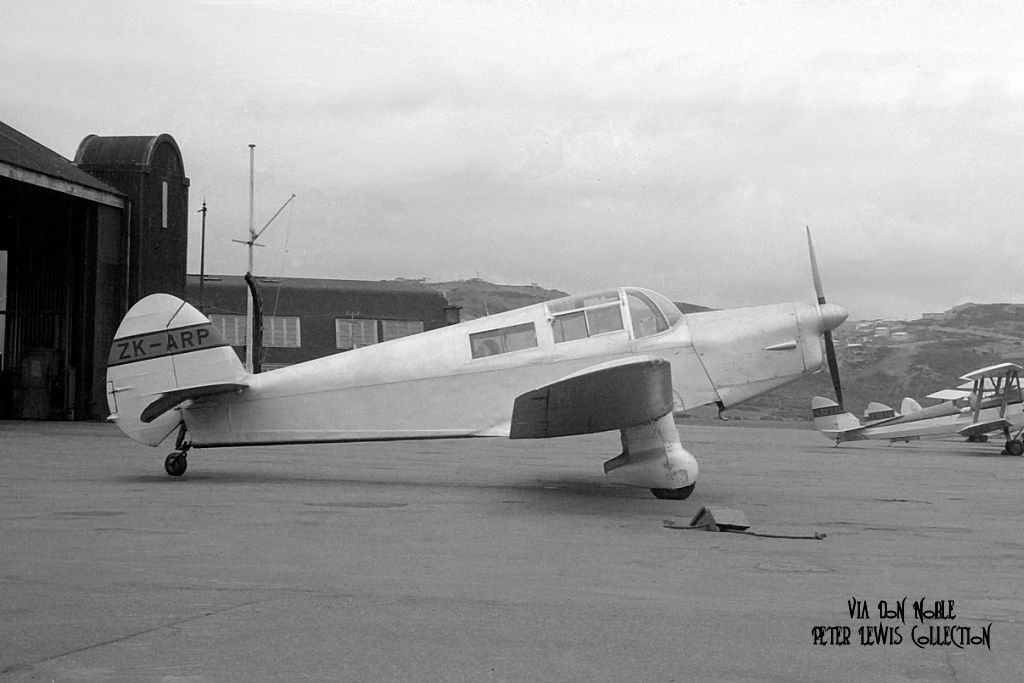 A Wellngton-based visitor to Mangere A Wellngton-based visitor to Mangere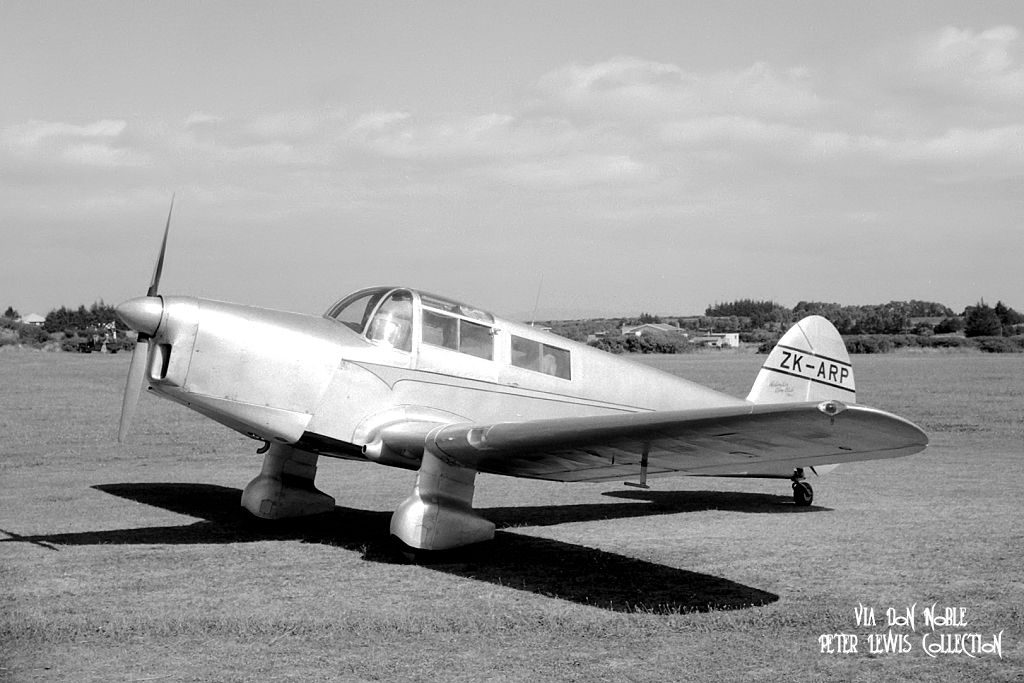 Gordon Newcombe's business taxi, Paraparaumu February 1958 Gordon Newcombe's business taxi, Paraparaumu February 1958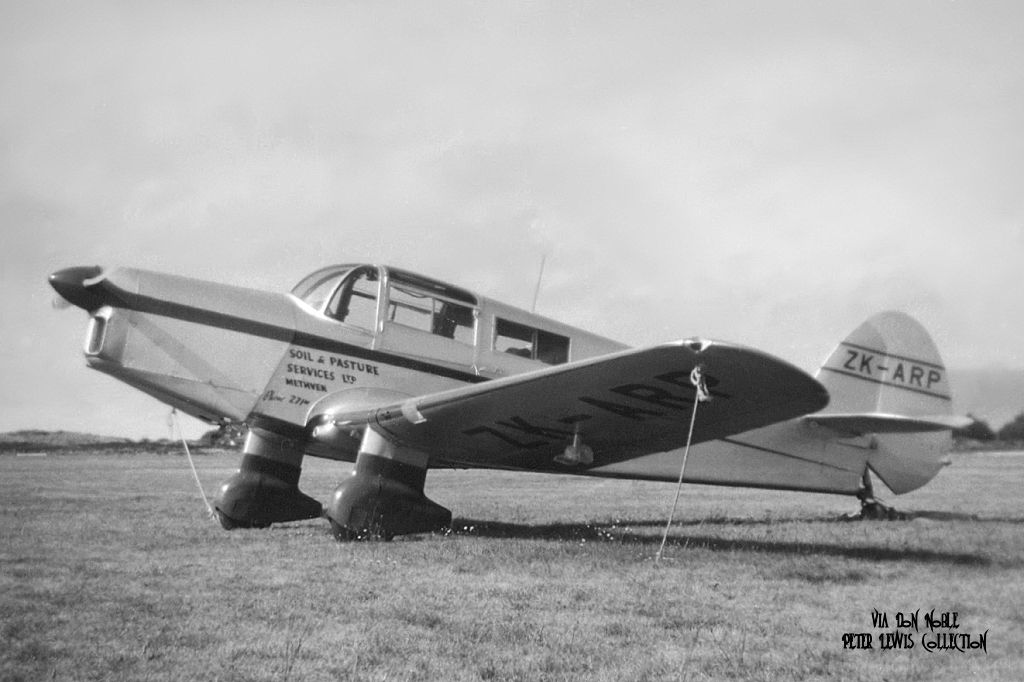 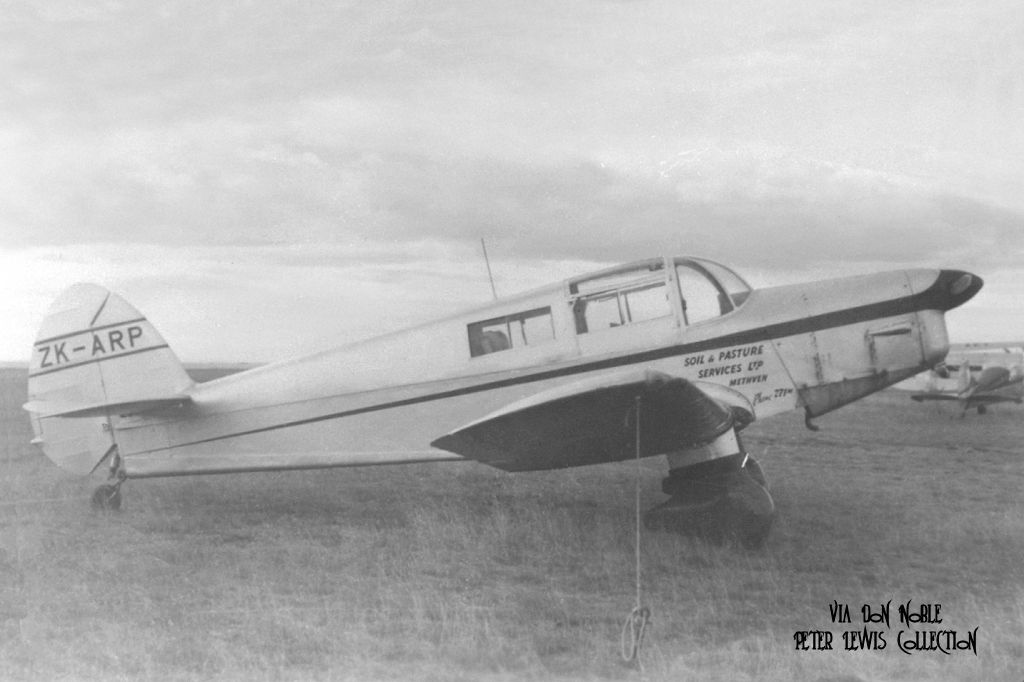 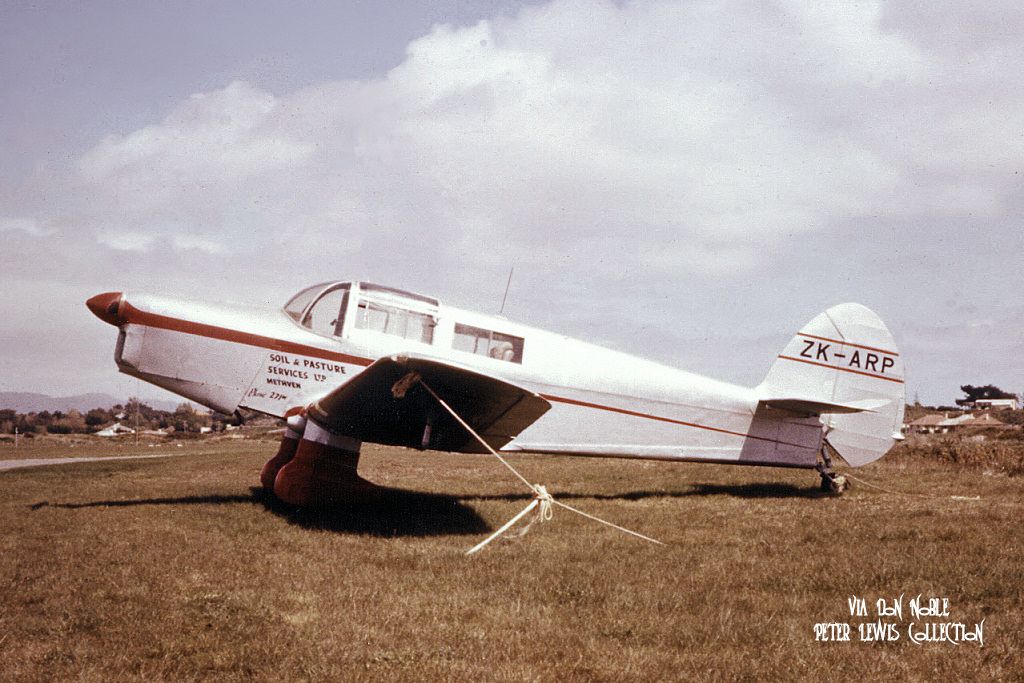 After Frank Brittains first rebuild, ZK-ARP out in the sun at Milson 11Oct1964 After Frank Brittains first rebuild, ZK-ARP out in the sun at Milson 11Oct1964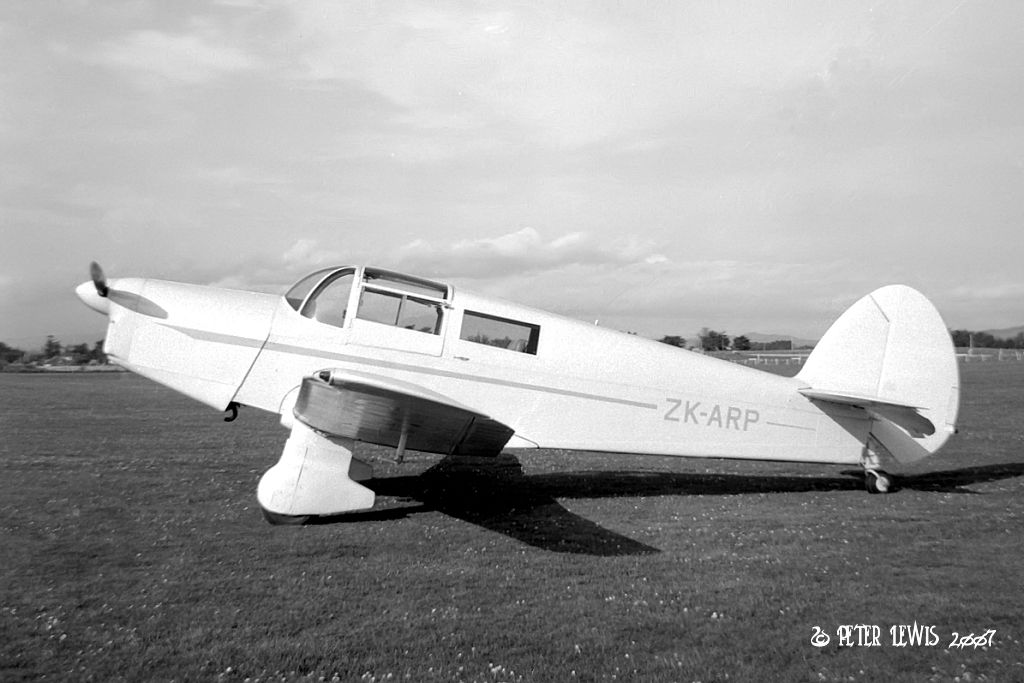 ZK-ARP visiting Ardmore 13Mar1965 ZK-ARP visiting Ardmore 13Mar1965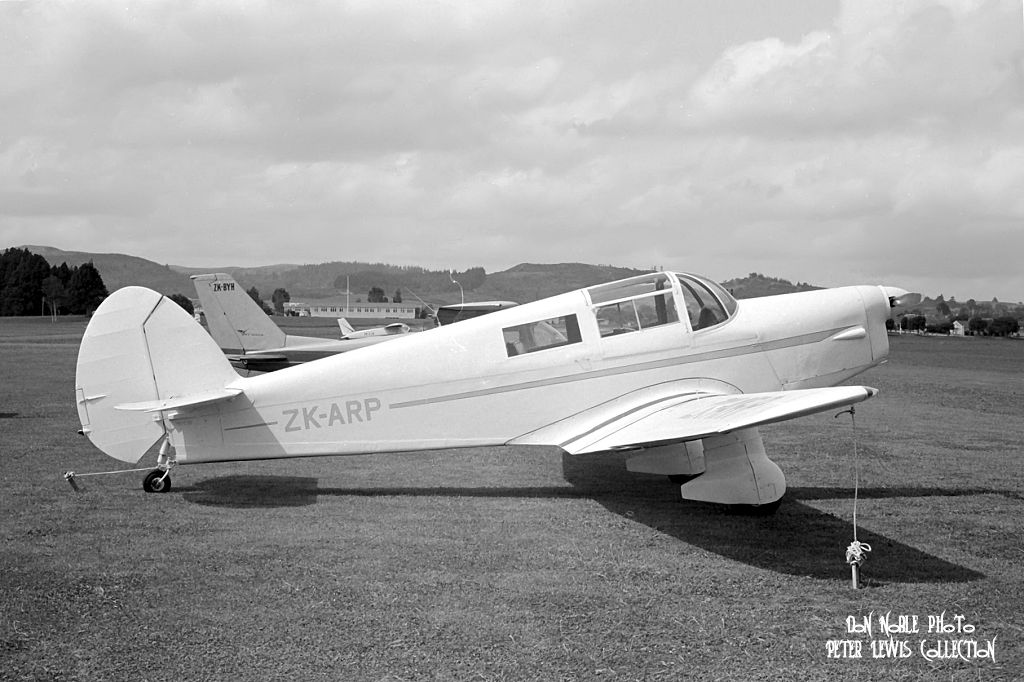 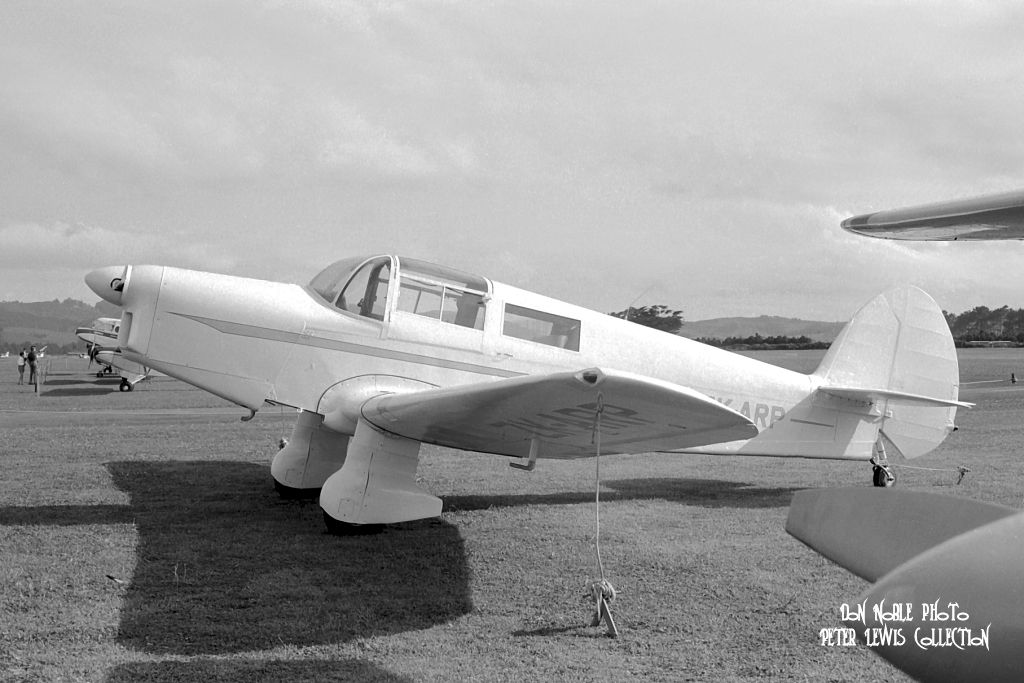
Back in the air after the second rebuild, ZK-ARP at Nelson 29Jan1978 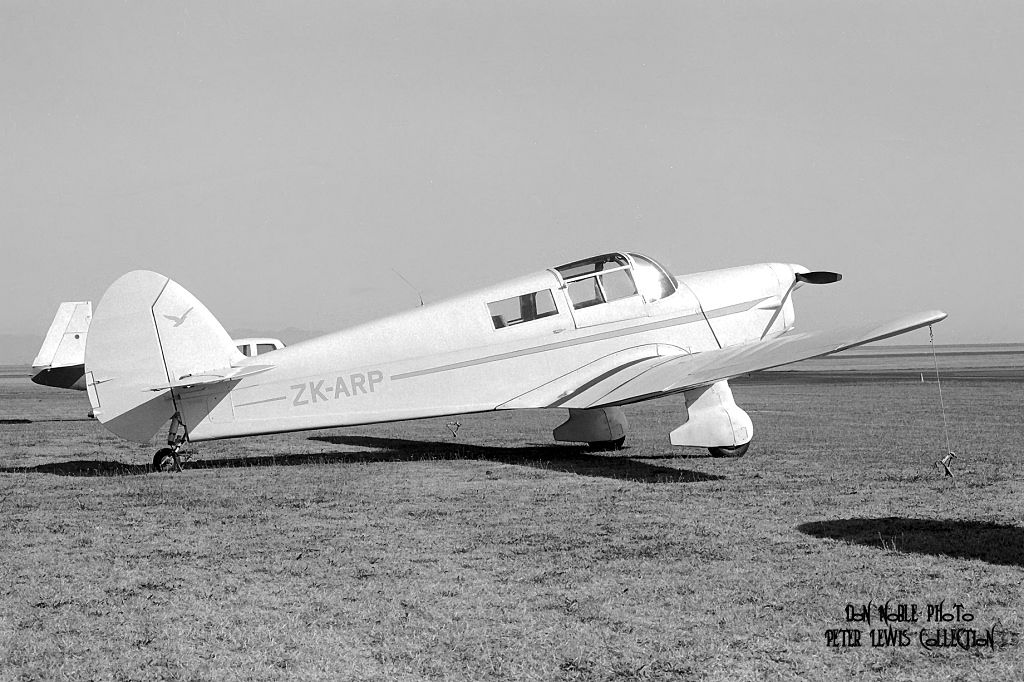 Active once more after moving north. At Pauanui 2000. Active once more after moving north. At Pauanui 2000.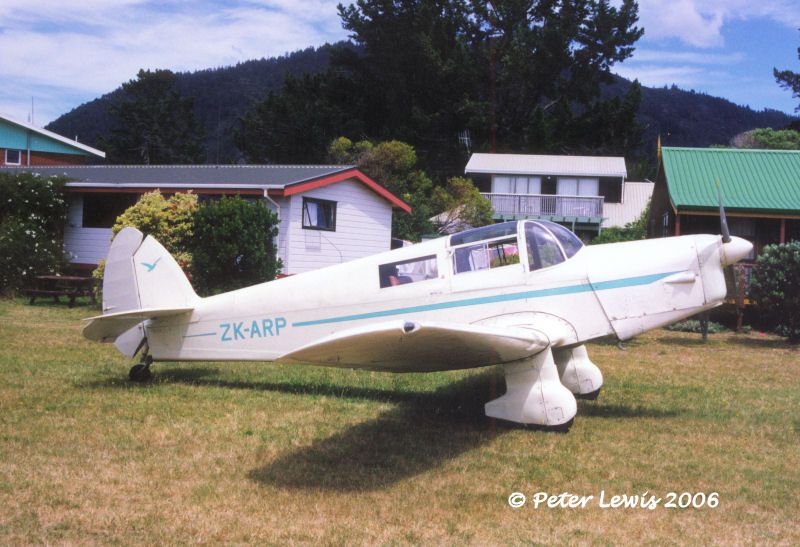 ZK-ARP at Kaipara Flats field 2001 ZK-ARP at Kaipara Flats field 2001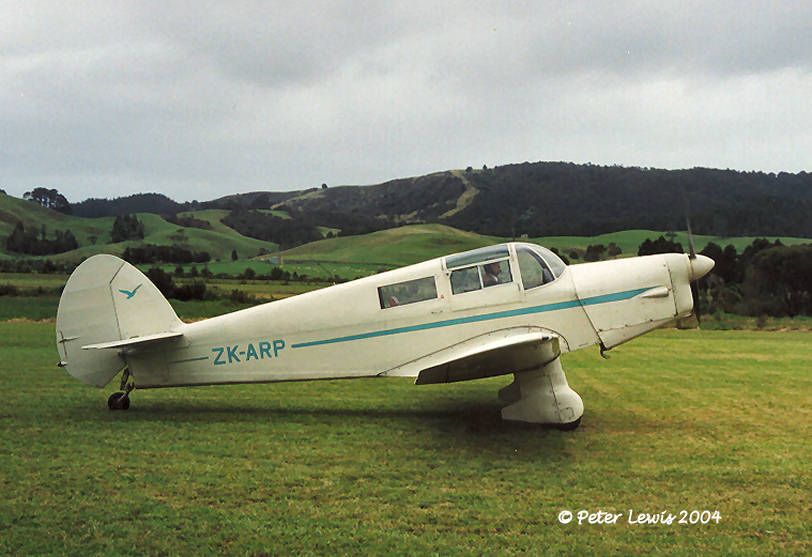 ZK-ARP posing for the camera at Ardmore September 2008 ZK-ARP posing for the camera at Ardmore September 2008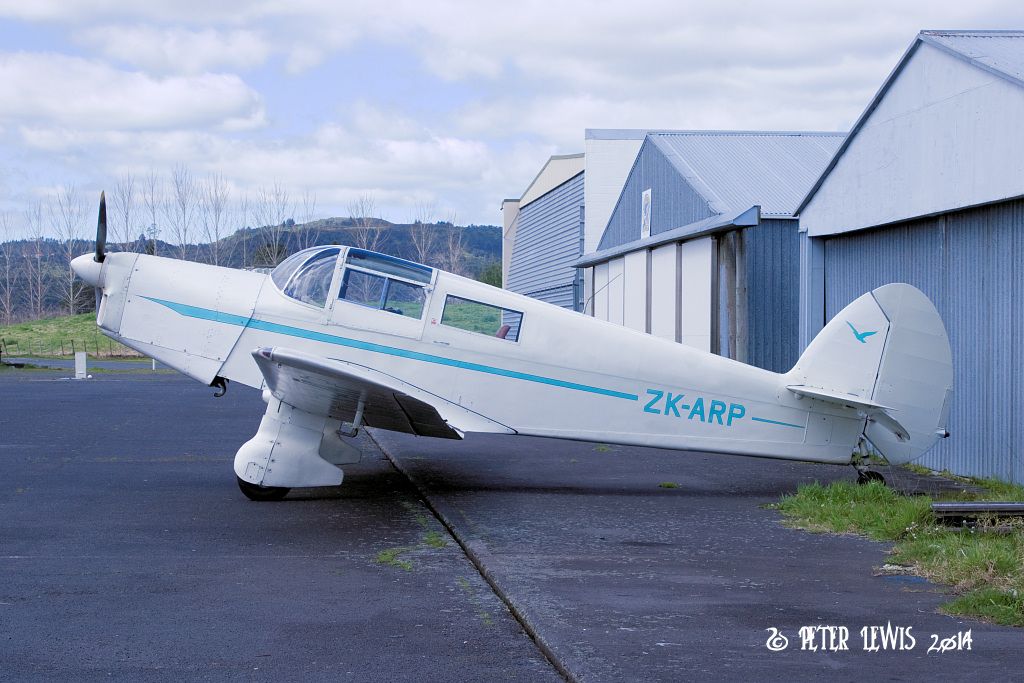  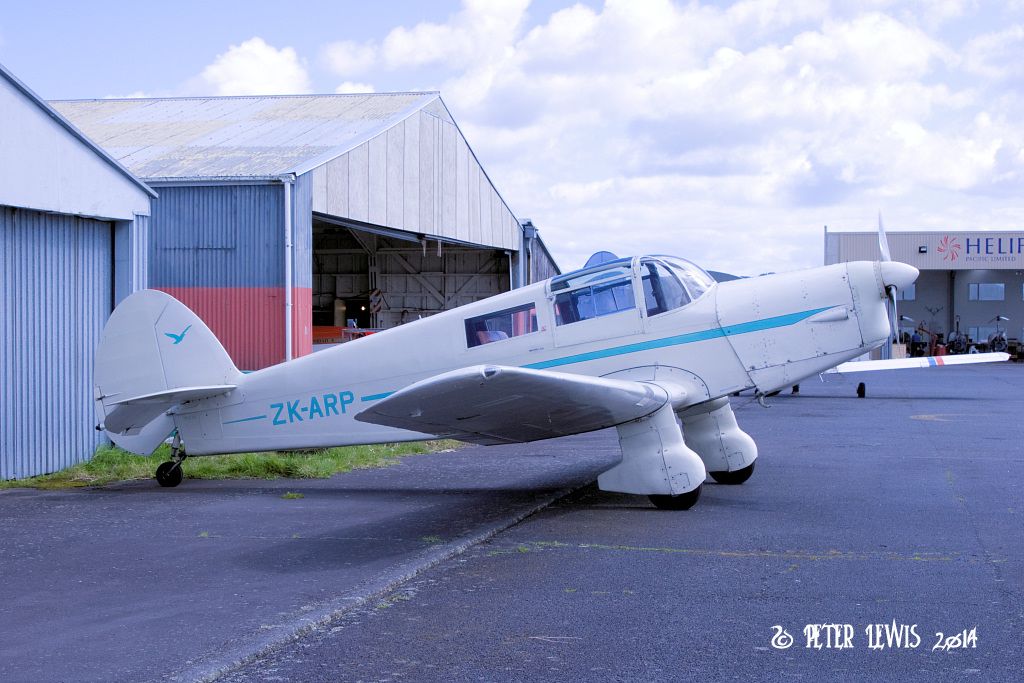 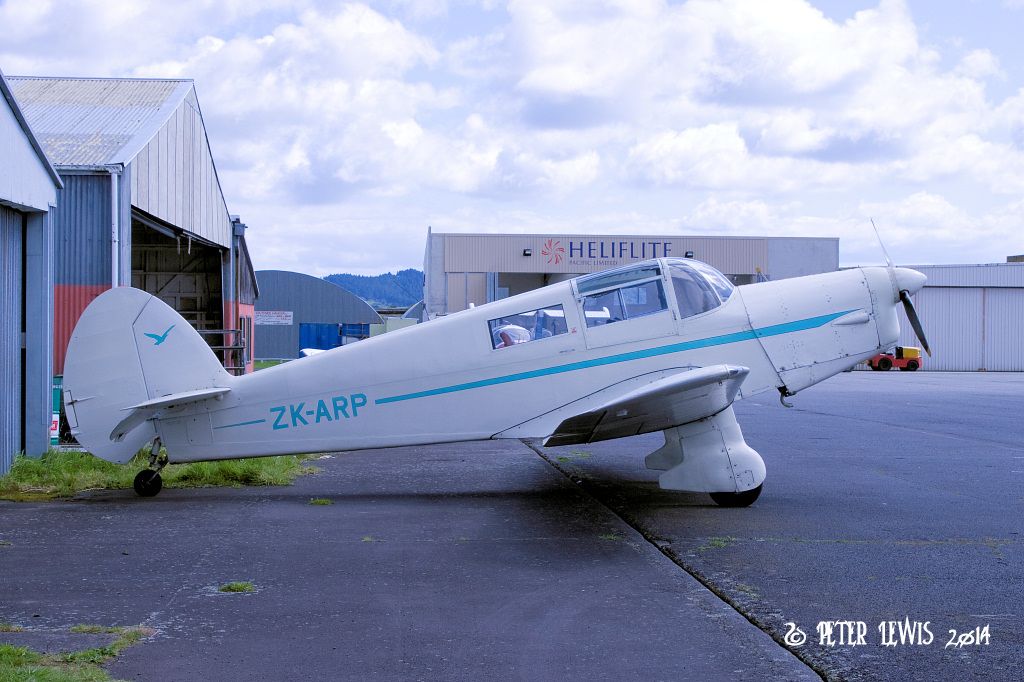 The folding wings are a useful storage feature The folding wings are a useful storage feature 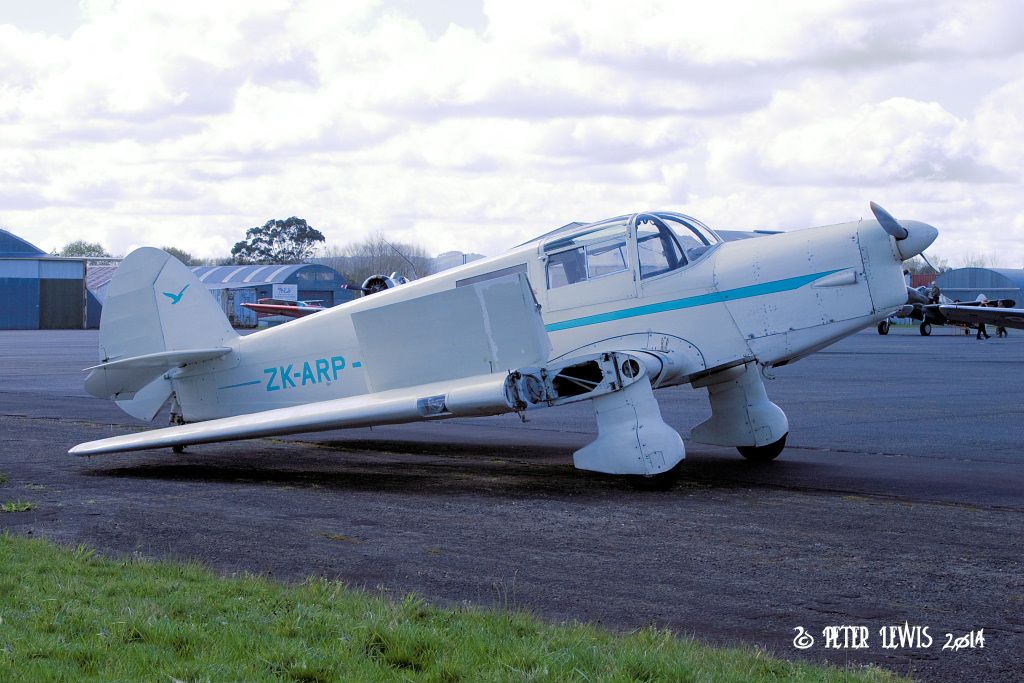 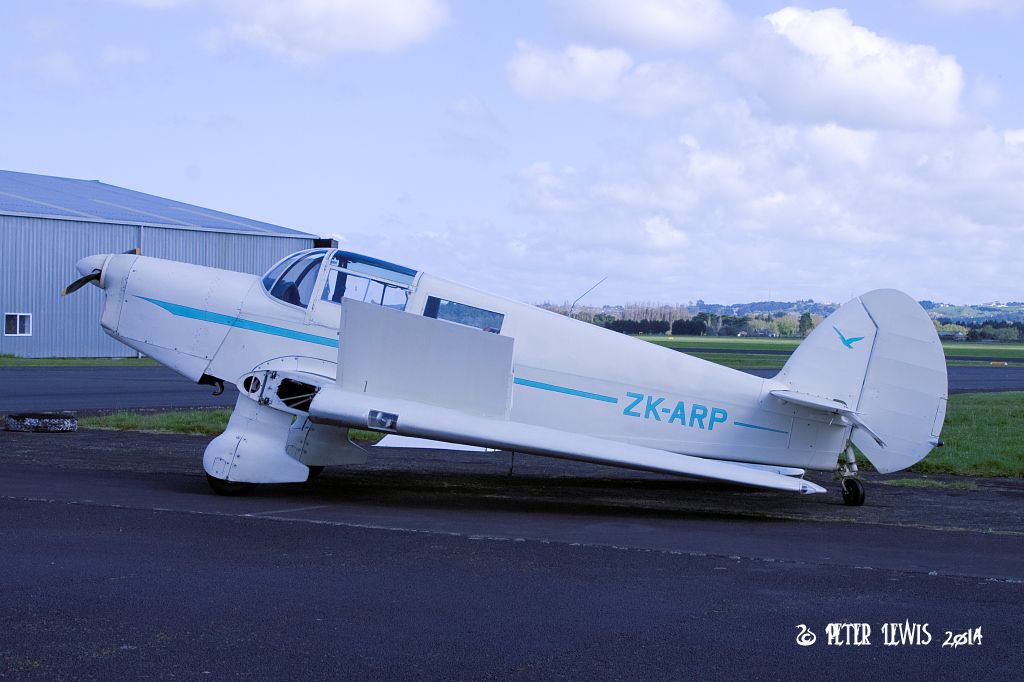 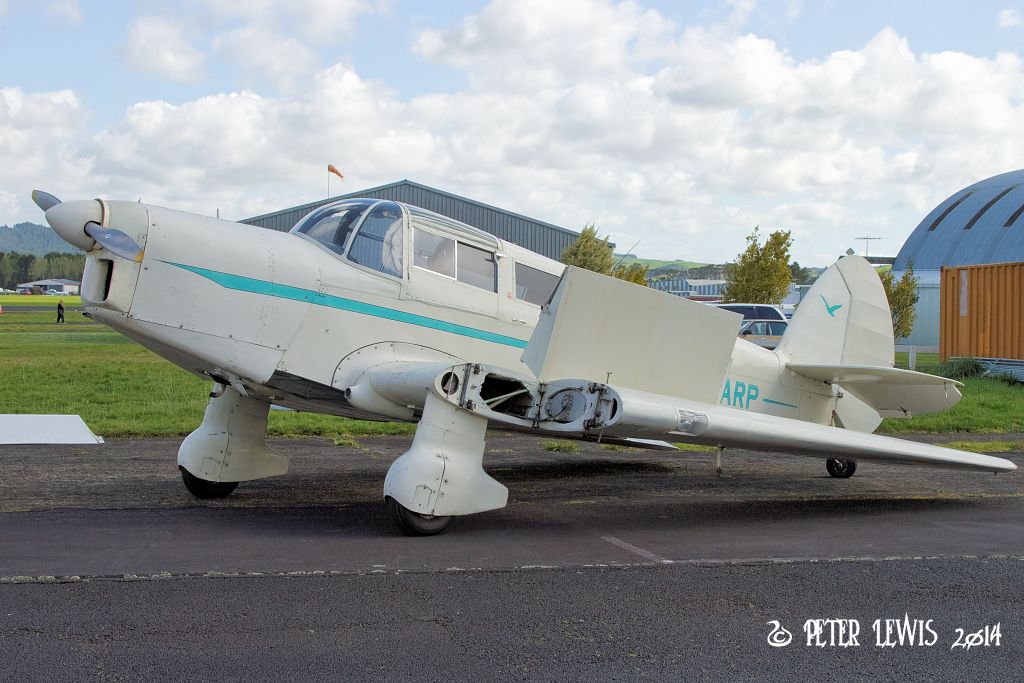 |
|
|
|
Post by Peter Lewis on Sept 10, 2014 22:34:45 GMT 12
Additional information now available on ZK-ARP thanks to Stan Smith: This week I was able to visit North Shore airfield, see Proctor ZK-ARP in its hangar, and peruse the aircraft log books. The aircraft took its first ever flight, as G-AIEO, on 4Oct1956 at Luton. This flight lasted 30 minutes, and allowed the aircraft to be signed off as airworthy by A P Hunt on 11Oct1946. As the Percival works were becoming fully occupied with Prince and Prentice production, the last few unsold Proctor 5s were moved as a batch lot to aircraft dealers R K Dundas Ltd., G-AIEO being one of these. The next flight for G-AIEO was not until 3Jun1948, when it flew another 20 minutes for the renewal of its CofA. Thus with only 50 minutes air time, it was then packed for shipment to New Zealand. The Proctor was assembled at Rongotai, and as ZK-ARP DHNZ staff pilot Lance Gatehouse carried out a 30 minute test flight there on 2Sep1948, results noted as satisfactory. Further flights, totalling 3hrs, were made at Rongotai the same day. The aircraft was then delivered to its new owners at Masterton on 3rd September. Over the following months the log book records flights to Wanganui, Palmerston North, Christchurch, Waipukerau, Paraparaumu and New Plymouth. The first incident of note took place on 4Dec1948 at Wanganui. While taxiing, strong winds lifted the tail and the nose of the aircraft came in contact with the ground. ‘Airframe inspected at Wanganui and found serviceable’ – no mention of any damage to the propeller! By 31Dec1949 ZK-ARP had flown 309 hours. The first logbook ends on 27Oct1953 with the aircraft having flown 1419hrs. ZK-ARP continued to be used regularly until 7Apr1957, when it was flown to Harewood. The next entry shows a 20 minute test flight on 25Jul1957 after several instruments had been removed, calibrated and replaced by Airwork (NZ) Ltd., the work signed out by Charles Savage. Later the same day ZK-ARP was flown Harewood to Nelson in 1hr 10mins. The Proctor was then apparently stored at Nelson from that date, as the Nelson Aero Club’s engineer Ivan East noted in the logbook “Aircraft removed from storage at Nelson and given 50 hr inspection as per Maker’s handbook” on 13May1959. On the same day a 30 minute test flight was carried out at Nelson and ZK-ARP was then flown to Paraparaumu in 40 minutes. Following sale to Frank Brittain, ZK-ARP next flew Paraparaumu-Palmerston North in 30 minutes on 27May1959. No further flights are then logged until 19May1964 when a 40 minute test flight at Palmerston North was carried out following Frank’s first rebuild. The Proctor was then flown reasonably regularly over the next few years on local and cross-country flights with no apparent mishaps until a final 45 minute flight on 17Sep1968, which gave a total of 54hrs 25 mins since that completion of that rebuild. Back into the workshop again, the next entry is a local 1hr 25 min test flight at Palmerston North on 13Dec1977. Frank obviously enjoyed having ‘Gertie’ back in the air again, and over the summer of January 1978 he took ZK-ARP on a trip from Palmerston North to Taupo, Matamata, Nelson and Paraparaumu staying some days in each place. Over the following few years the Proctor averaged 15 to 20 flying hours per year until Frank’s last flight in the Proctor, Fielding – Waipukerau – Dannevirke – Fielding – Palmerston North, 1hr 55min on 16Feb1986. Following the sale of the Proctor from the Brittain estate, ground runs were carried out at Milson on 23May1997. A ferry permit was approved by CAA and following 45 minutes of circuits on 22Jun1997 ZK-ARP was flown to North Shore airfield in 2hrs 25 mins later that day. The Proctor is currently housed, wings folded, in a hangar at North Shore alongside a seldom-flown Wilga. Apparently ZK-ARP last flew about two years ago, and needs fabric replacement before it can fly again. Intial logbook signoff as airworthy for G-AIEO, 11Oct1946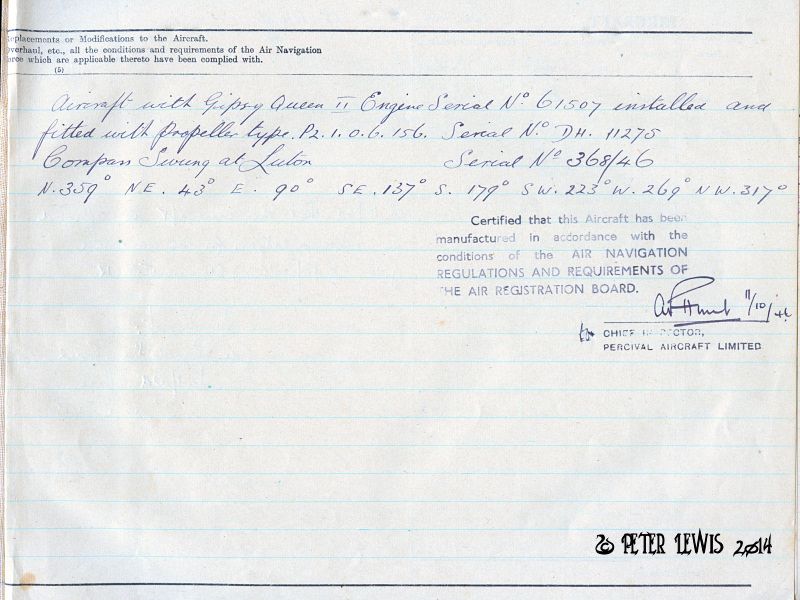 After the first 30 minute test flight at Rongotai, the Proctor was kept busy over the next few weeks After the first 30 minute test flight at Rongotai, the Proctor was kept busy over the next few weeks Logbook certificate for ZK-ARP Logbook certificate for ZK-ARP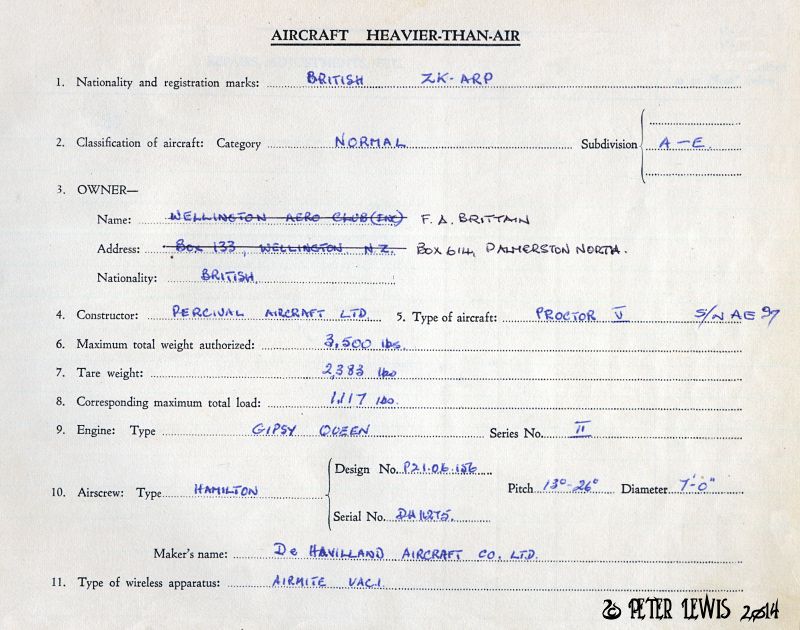 Ivan East's release note as ZK-ARP comes out of storage in Nelson Ivan East's release note as ZK-ARP comes out of storage in Nelson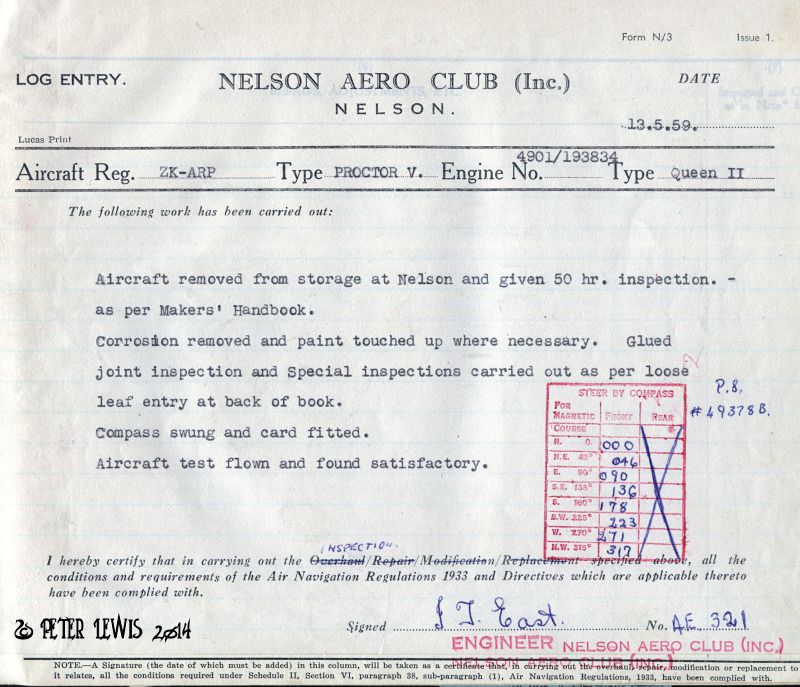 ZK-ARP in the hangar at North Shore airfield 8Sep2014 ZK-ARP in the hangar at North Shore airfield 8Sep2014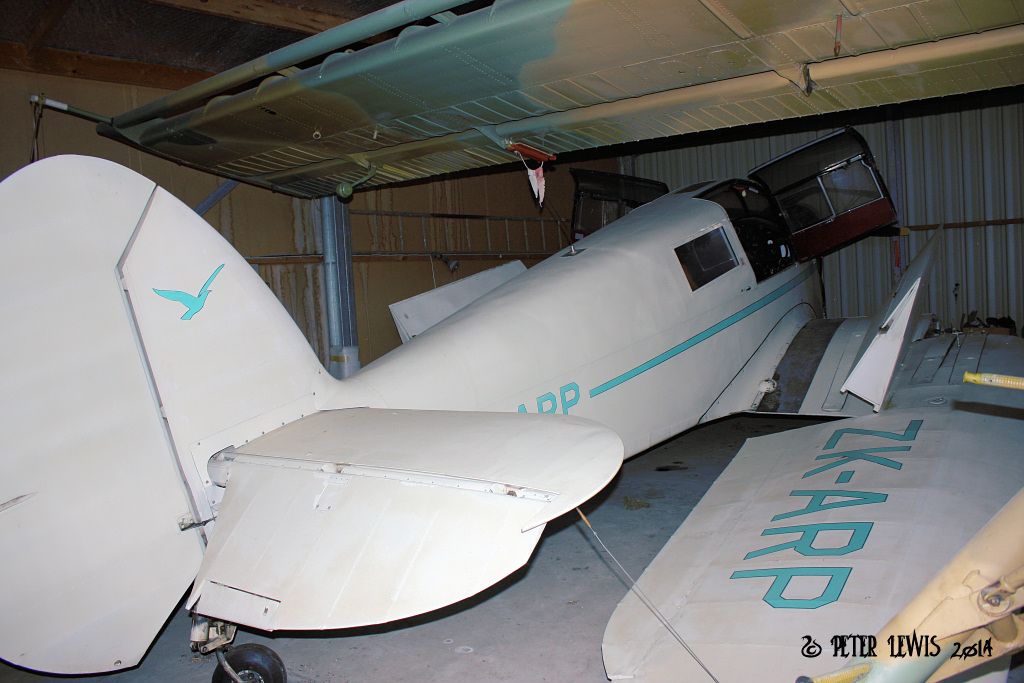 The Gull logo on the fin is quite non-original The Gull logo on the fin is quite non-original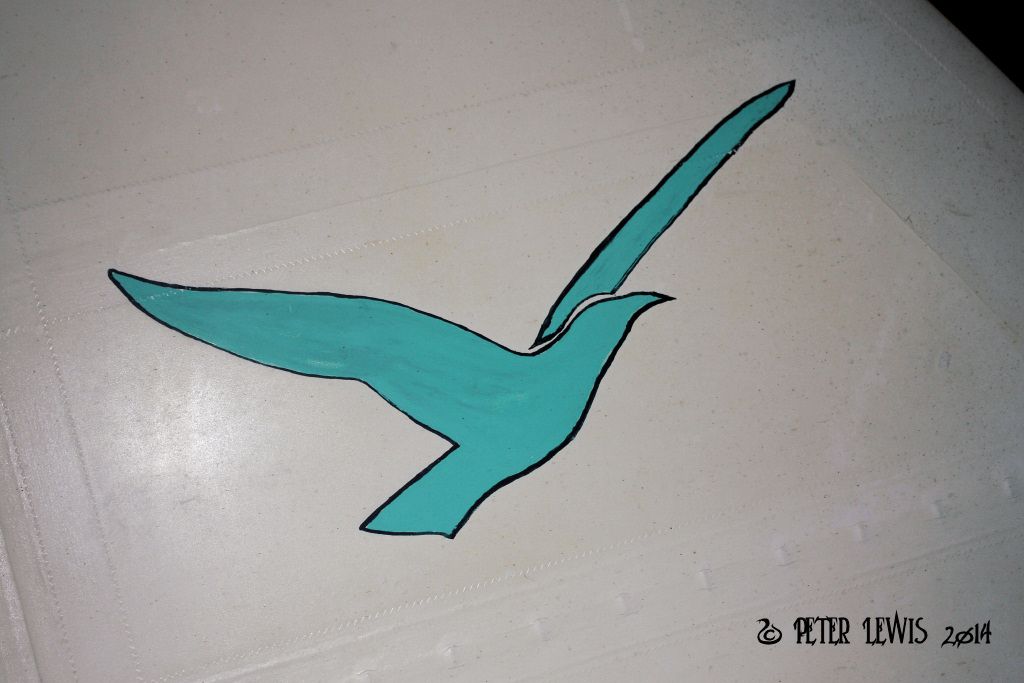 1940s control deck 1940s control deck 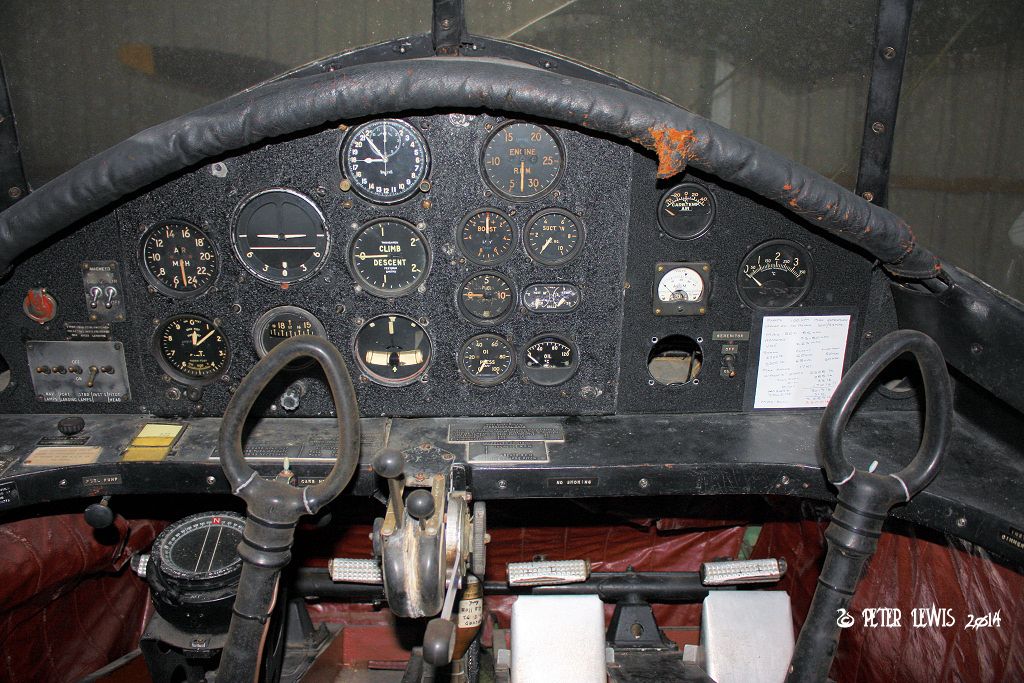 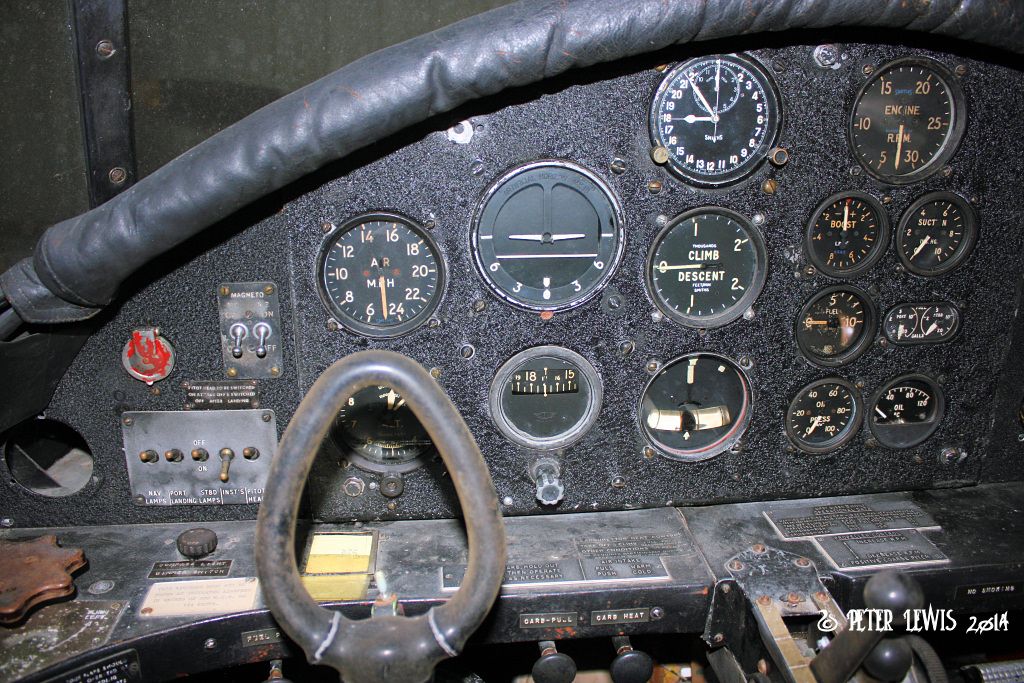 Looking down the back, inside ZK-ARP. Looking down the back, inside ZK-ARP.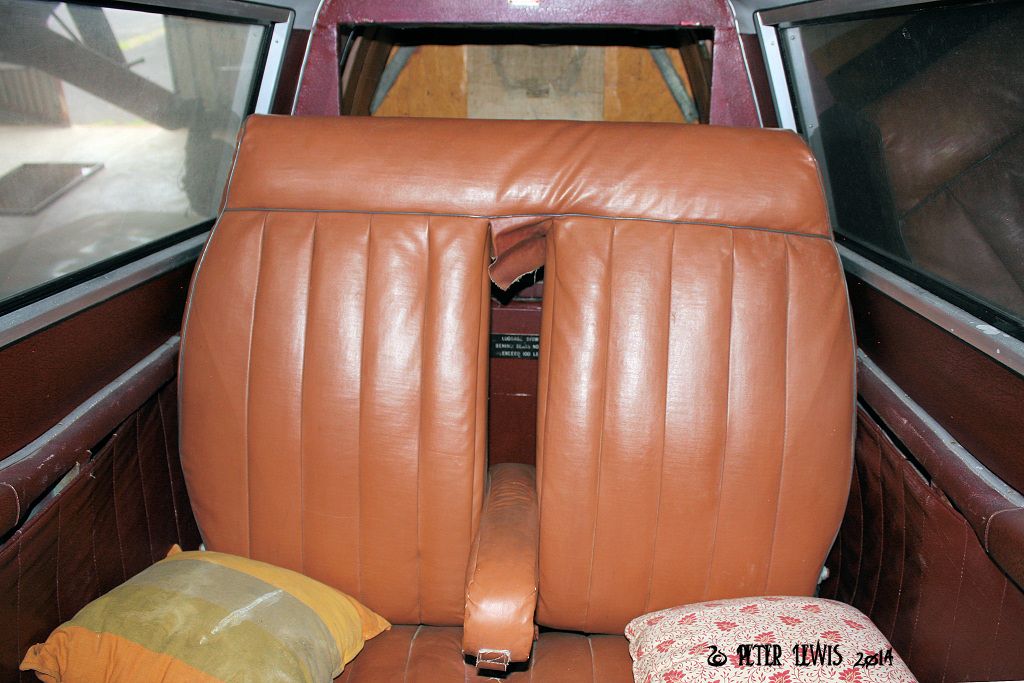 The noise-maker, Gipsy Queen 210hp The noise-maker, Gipsy Queen 210hp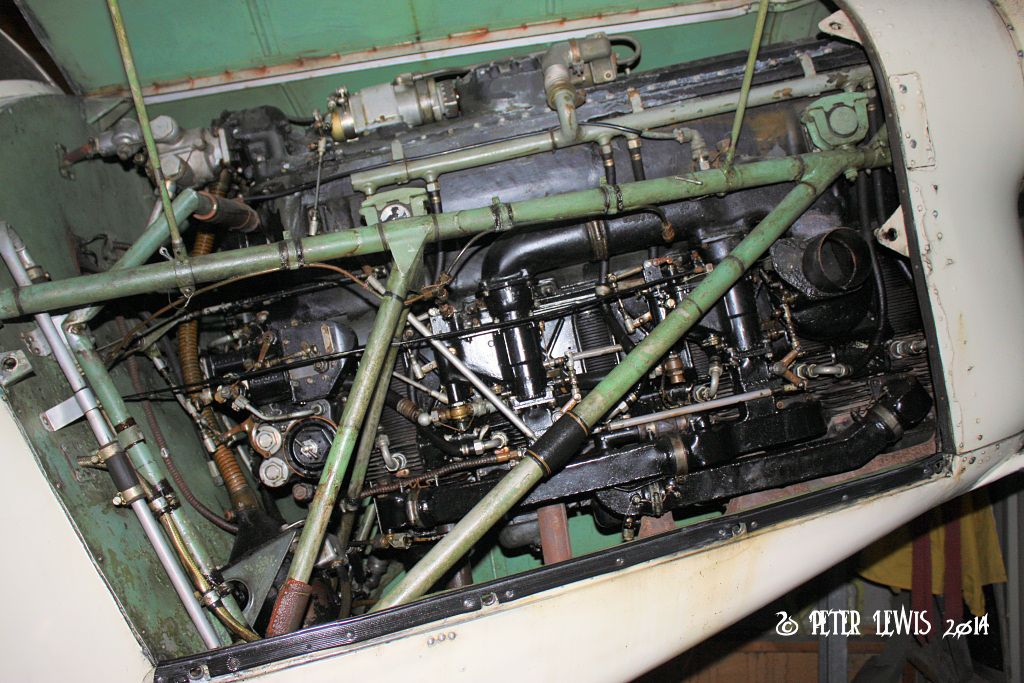 |
|
|
|
Post by Peter Lewis on Sept 13, 2014 16:15:17 GMT 12
Proctor c/n H.32 was built by F Hills and Sons as a Mk.II and was converted to Mk.III standard while still in military service as BV538. Sold postwar it became G-AJTS with Southern Aircraft (Gatwick) Ltd. on 21May1947. Charlton Higgs of Reading took over ownership of the aircraft on 15Feb1949. Meanwhile, in New Zealand, Herbert Lightband had gained his wings with the New Plymouth Aero Club in the late 1930s and his son, Phil Lightband, caught the flying bug. After his first solo flight at the age of 14, Phil obtained his PPL the next year. Service in the RNZAF flying the P-40 and Corsair followed, and Phil rejoined the New Plymouth aero club after the war was over but found the restrictions of civilian flying irksome. Grounded for a year by aero club ruling after an unauthorized escapade in a Tiger Moth he and a friend, Peter Hobart, decided to travel by sea to the UK, buy a light aircraft there and then fly that aircraft back to New Zealand to sell at a profit. After inspecting what was available in the UK the pair bought Proctor G-AJTS for £400. The UK registration was cancelled on 20Dec1949 with the Proctor becoming ZK-ATW in the name of Phillip L Lightband and Peter Hobart on the 22nd. The aircraft was painted in quite an avant garde colour scheme with the name ‘Kiwi’ prominently painted on the port engine cowl. Accompanied by a South African Donald McBean the team left the UK in December 1949. The trip was much more eventful than they had envisaged and they took six weeks to reach Darwin. By the time they got to Sydney on 11Feb1950 they had run out of funds to complete the trip. Herbert Lightband met the travellers at Sydney and paid the costs of disassembling the Proctor and freighting it to Auckland by sea. A profit-making exercise it was not. Reassembled at Auckland, ZK-ATW was flown to New Plymouth and became the property of H W Lightband on 2Dec1950. Housed in the NPAC hangar, the Proctor was destroyed when both the hangar and the workshops were extensively damaged by fire in the early morning of 15Jan1952. Newspaper reports also indicate that two other machines were badly damaged. The registration of ZK-ATW was cancelled on 18Mar1952. Lightband (left) and Hobart with ZK-ATW at New Plymouth after competion of their adventure Phil Lightband and Peter Hobart. Negatives of the Evening Post newspaper. Ref: 114/173/06-F. Alexander Turnbull Library, Wellington, New Zealand. natlib.govt.nz/records/22784662Proctor 3 ZK-ATW at Mangere 1950 Phil Lightband and Peter Hobart. Negatives of the Evening Post newspaper. Ref: 114/173/06-F. Alexander Turnbull Library, Wellington, New Zealand. natlib.govt.nz/records/22784662Proctor 3 ZK-ATW at Mangere 1950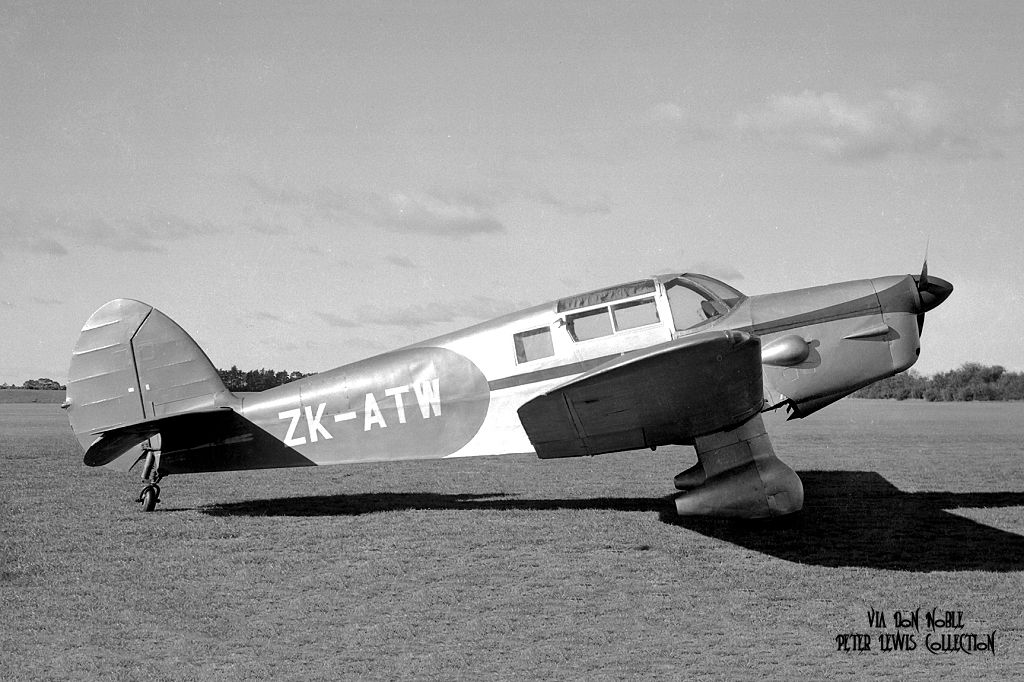  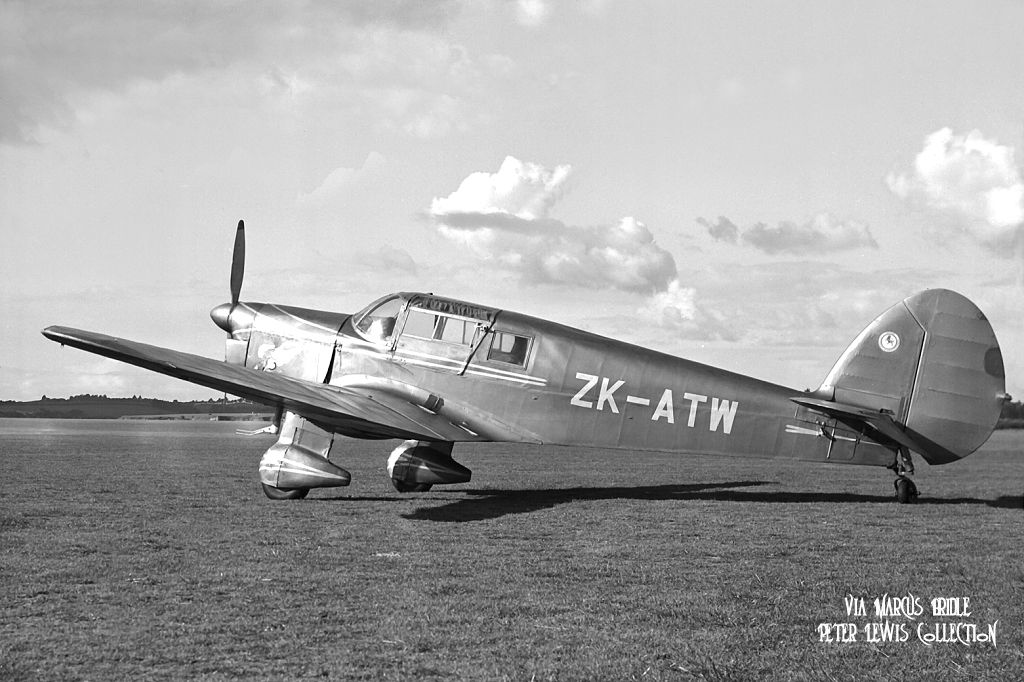 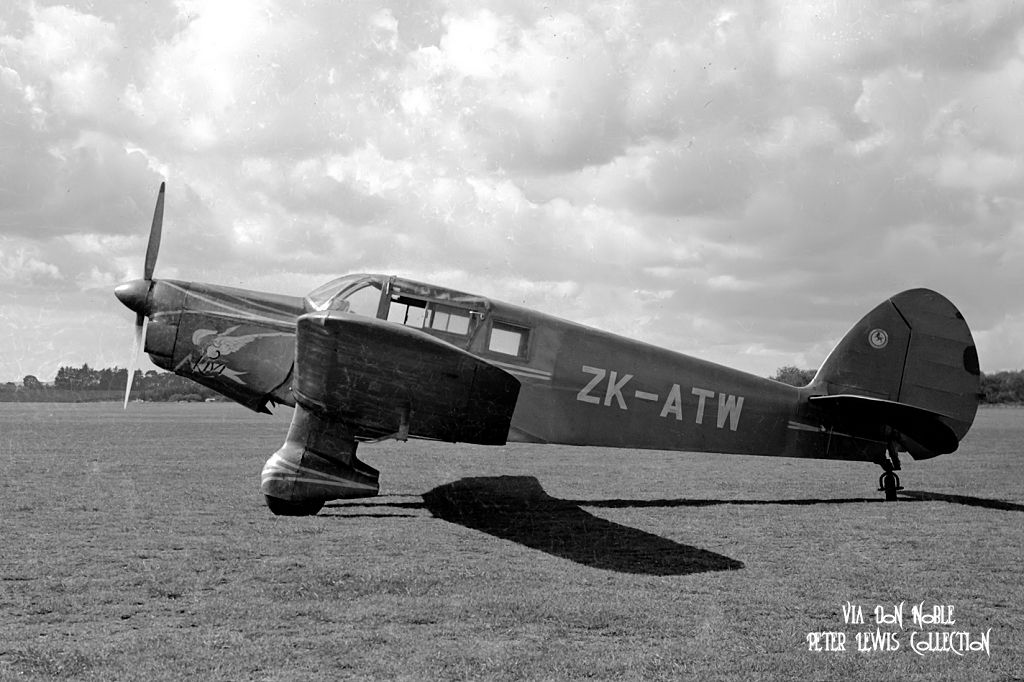 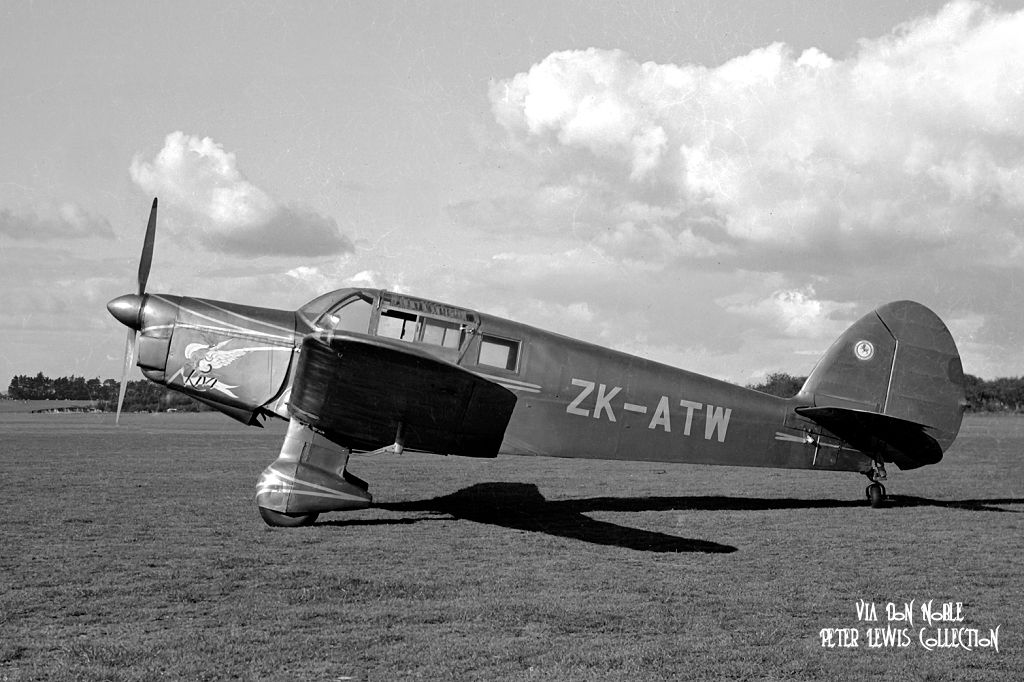 Closeup of the nose art on ZK-ATW Closeup of the nose art on ZK-ATW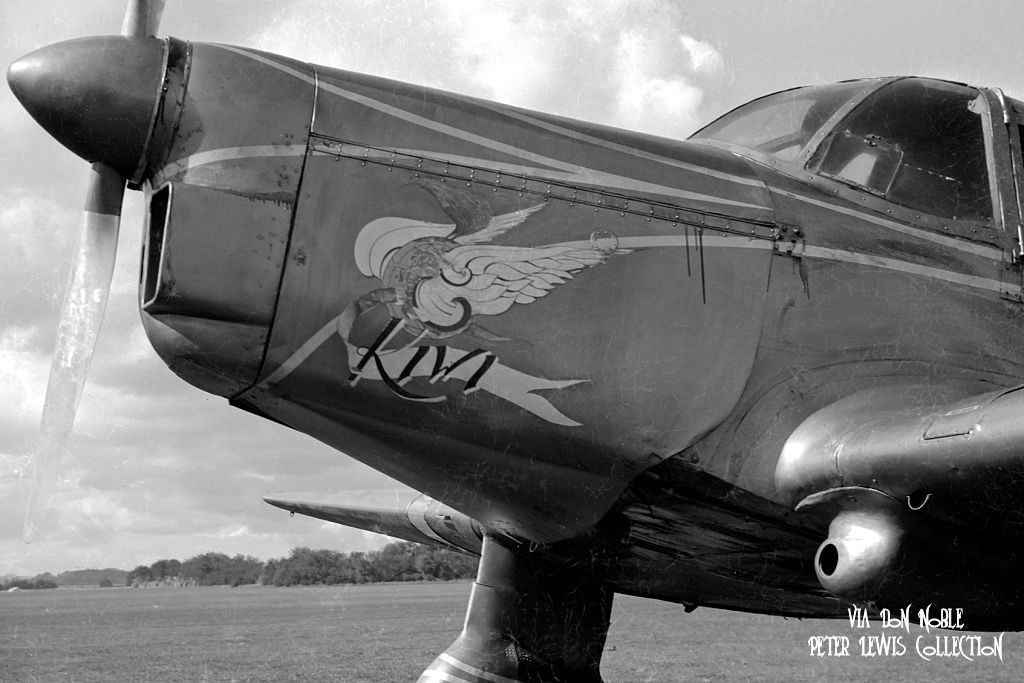 |
|
|
|
Post by Peter Lewis on Sept 18, 2014 20:16:09 GMT 12
Arthur Bradshaw had grown up in the South Island of New Zealand and gained his pilots licence with the Southland Aero Club at Invercargill in 1933. Progressing through to a commercial licence in 1934, he then set up Southland Airways as an aerial charter service utilizing mainly two DH Puss Moths. He joined the RNZAF on the outbreak of war, in 1940, gaining experience flying transport aircraft in the Pacific until transferring to RAF Transport Command in 1945. Leaving military service in January 1947, he initially worked for the Argentinean airline FAMA before becoming a senior DC-6 captain on trans-Atlantic flights with the Belgian airline Sabena. Proctor 5 c/n Ae78 was built in 1946 and became G-AHWW with Skytravel Ltd. of Liverpool on 15Jul1946 carrying the name ‘ Madame Butterfly’. After one year’s use, having flown 303hrs 40mins, its CofA became due, but by then Skytravel was in liquidation. The Proctor therefore sat inactive for some months, passing into the ownership of Bowmaker Ltd. of Bournemouth on 21Jan1948. Seeking the ability to visit sights around Europe within the tight time confines of his scheduled leave breaks, Bradshaw bought G-AHWW through aircraft brokers W S Shackleton Ltd., and took possession of the aircraft in March 1948. After a CofA renewal and a test flight at Blackpool on 6Apr1948 it flew across to Bradshaw’s then home base at Brussels on the 13th. A shift in employment from Sabena to charter company Skyways in late 1948 relocated both Bradshaw and G-AHWW back to the UK, however the European touring continued as time permitted with the aircraft accumulating about another 150hrs. During this period the Proctor was also repainted, the original dark blue and silver being replaced by pale green overall with the registration in white. The name ' Kiwi Wanderer' and a silhouette of a kiwi appeared on each side of the engine cowlings and the New Zealand flag was painted on each side of the fin. By 1950 Arthur Bradshaw was contemplating a return to New Zealand, and thus fitted G-AHWW with a long-range fuel tank and additional radio gear. Accompanied by his wife and young son he departed from Blackbushe on 28May1950. The overnight stops were Naples, Athens, Cyprus, Kuwait, Sharjah, Karachi, New Delhi, Calcutta, Rangoon, Bangkok, Penang, Soerabaya, Bali, and they reached Darwin on 17th June. As detailed in his records, Bradshaw then clashed with the Australian authorities. On reaching Sydney on the 20th he was told that they would not give him permission to depart from Australia across the Tasman Sea to New Zealand. He responded that he was flying a British-registered aircraft, and that the Air Ministry had cleared him to fly from the UK right through to New Zealand. Eventually, a compromise was agreed. Bradshaw could fly the Proctor across the Tasman solo provided his family crossed by commercial airline, with the Australian Government paying their fares. Thus he left Coffs Harbour on the morning of the 27th June and flew to Norfolk Island, mid-Tasman, in 6hrs 20mins. The next day he completed the final leg to New Zealand, landing at Whenuapai, then Auckland’s international airport, after 4hrs 10mins. So G-AHWW became the only Proctor ever to fly the Tasman. Total flight time from London to Auckland was 124hrs 5mins. G-AHWW was then relocated from Whenuapai to Mangere and four days later flew to Hamilton, Ohakea, Wellington, Christchurch and Invercargill. Bradshaw had hoped to restart Southland Airways but soon found that post-war the socio-political environment had changed and that independent operators would have a very difficult time competing against the government-owned airline. He therefore quickly decided to abandon that idea and instead proceeded to set up in business in Nelson as a distributor of aviation and automotive supplies. The Proctor G-AHWW became ZK-AVW on 30Aug1950 and its UK registration was cancelled on 20th September. Over subsequent years ZK-AVW was often used within the business to expedite visits to Bradshaw’s clients, and also on occasional charter flights under the aegis of both the Nelson Aero Club and Nelson-based Northwest Airlines. In 1964 he also bought and restored the DH84 Dragon ZK-AXI, used that on contracted aerial survey flights, and sold it in 1967. ZK-AVW was retained as personal transport until, with the end of his flying career in sight, Bradshaw sold the Proctor on 15Sep72 just a few months short of 25 years of ownership. At that time this Proctor had flown 1339hrs. R J de Montalk & T A Gifford-Moor of Wanganui, became the registered owners of ZK-AVW on 31Oct1972. At this time it was due for a CofA renewal. An engineer was contracted and ZK-AVW was at Wanganui when this work was to be done. However on examination it was found that the wooden structure had become unsafe and the aircraft was grounded. Fortunately John Geary happened to arrive on the scene, bought ZK-AVW for $1000, and transported it to Auckland. Stored at his South Auckland property for many years, it found a new home with Don Subritzky in 2013. The registration of ZK-AVW was cancelled on 25Jan1991. Proctor 5 G-AHWW 'somewhere in England' after the repaint into Bradshaw's colours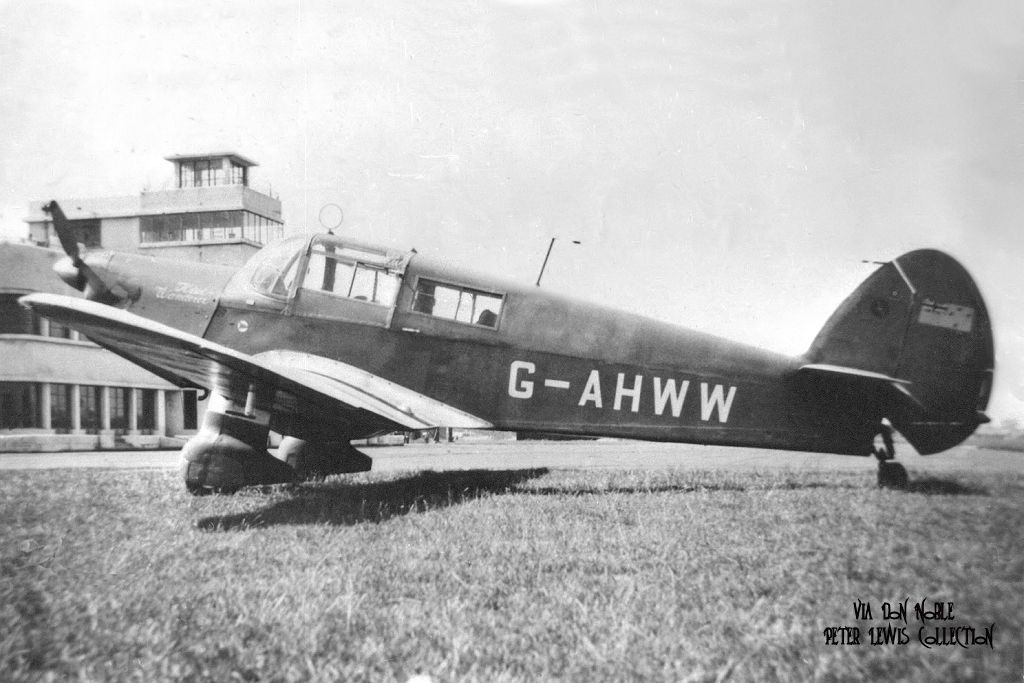 G-AHWW gets the once-over from RNZAF personnel on arrival at Whenuapai 28th June 1950 G-AHWW gets the once-over from RNZAF personnel on arrival at Whenuapai 28th June 1950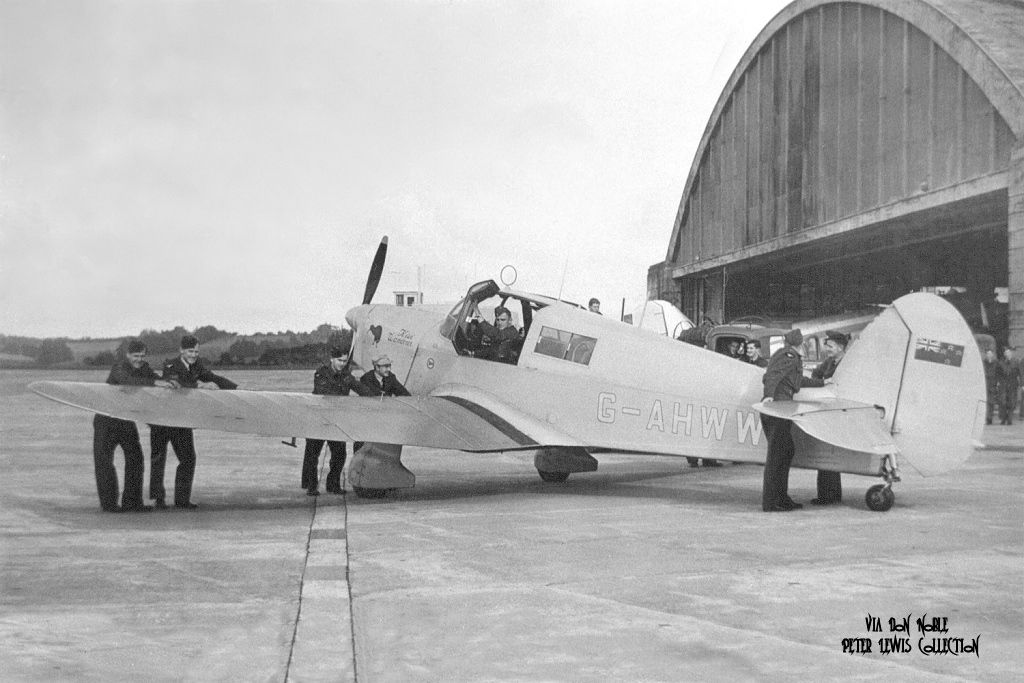 "Kiwi Wanderer" detail on G-AHWW, taken at Mangere June 1950 "Kiwi Wanderer" detail on G-AHWW, taken at Mangere June 1950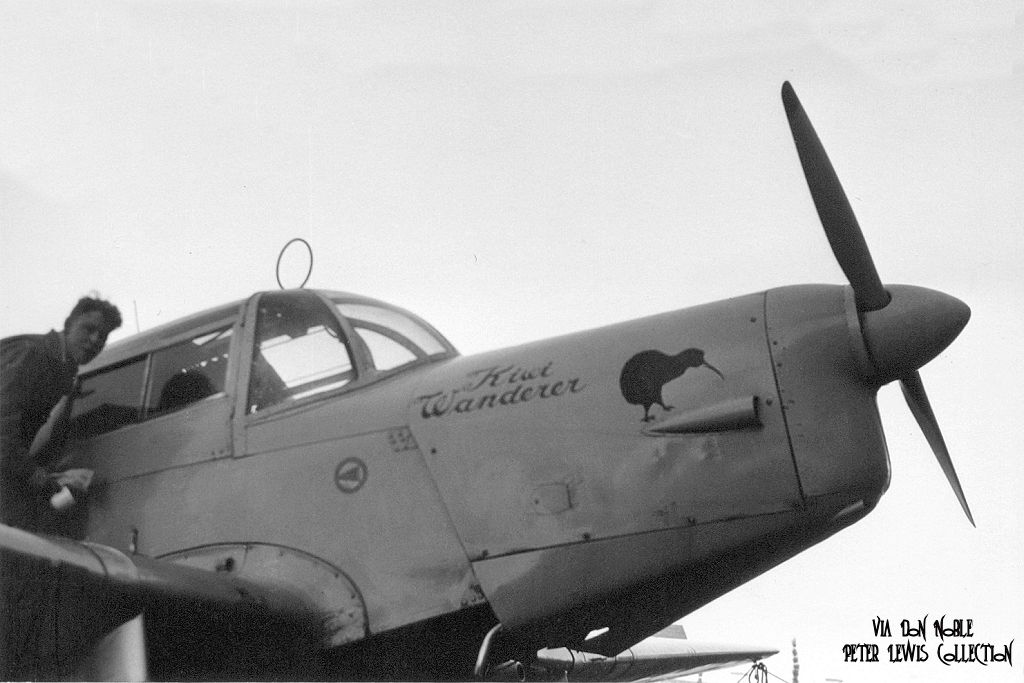 At Mangere late June 1950 At Mangere late June 1950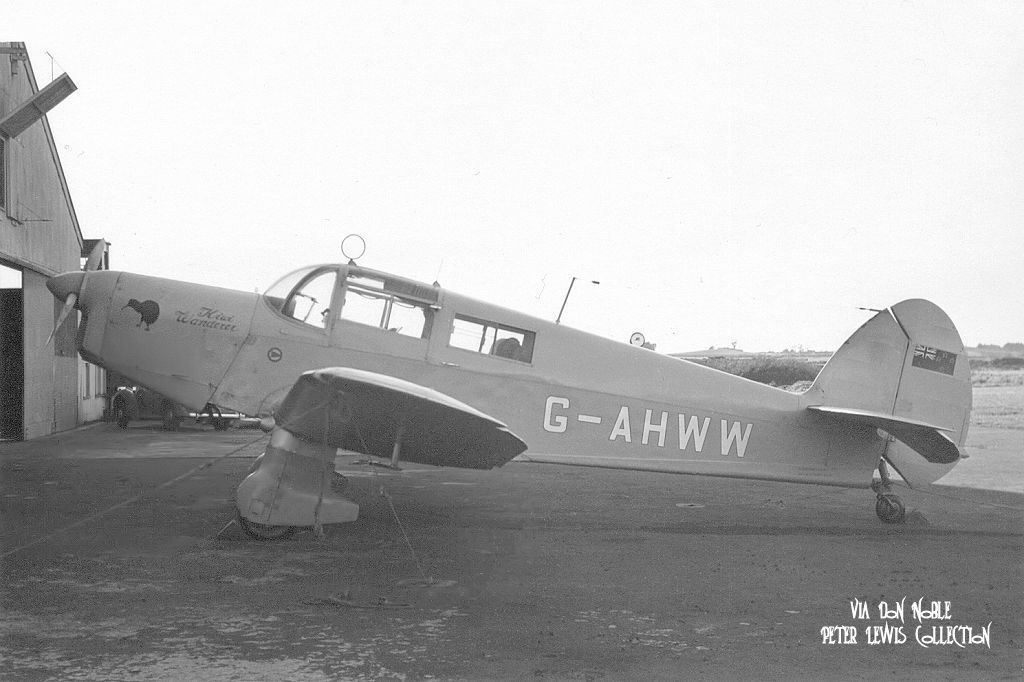 Departing Mangere for Hamilton Departing Mangere for Hamilton G-AHWW at Hamilton early July 1950 G-AHWW at Hamilton early July 1950 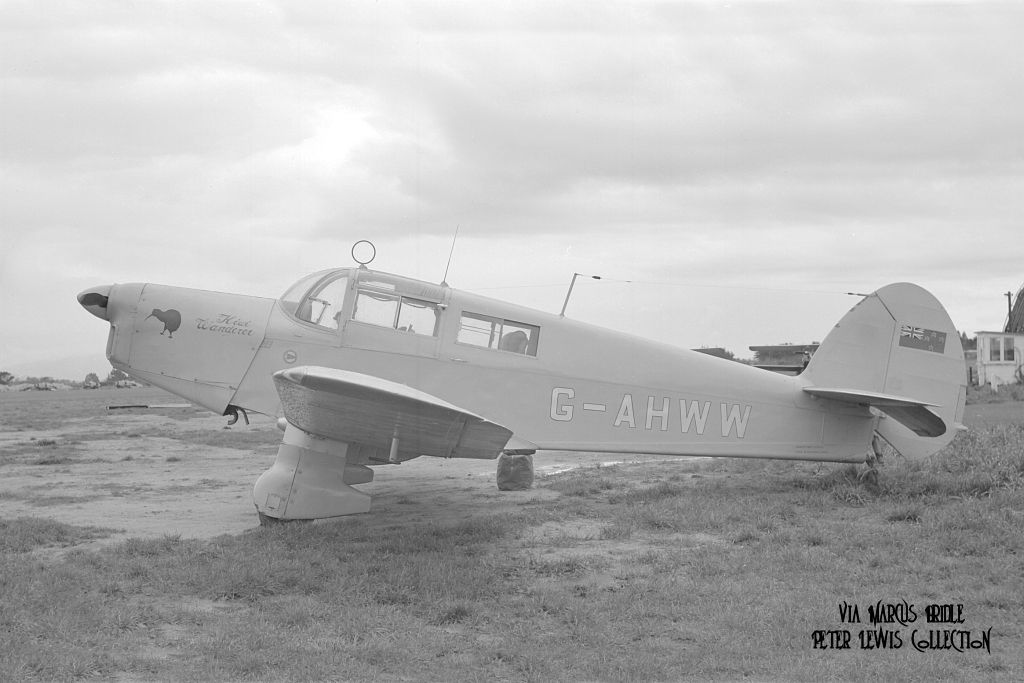 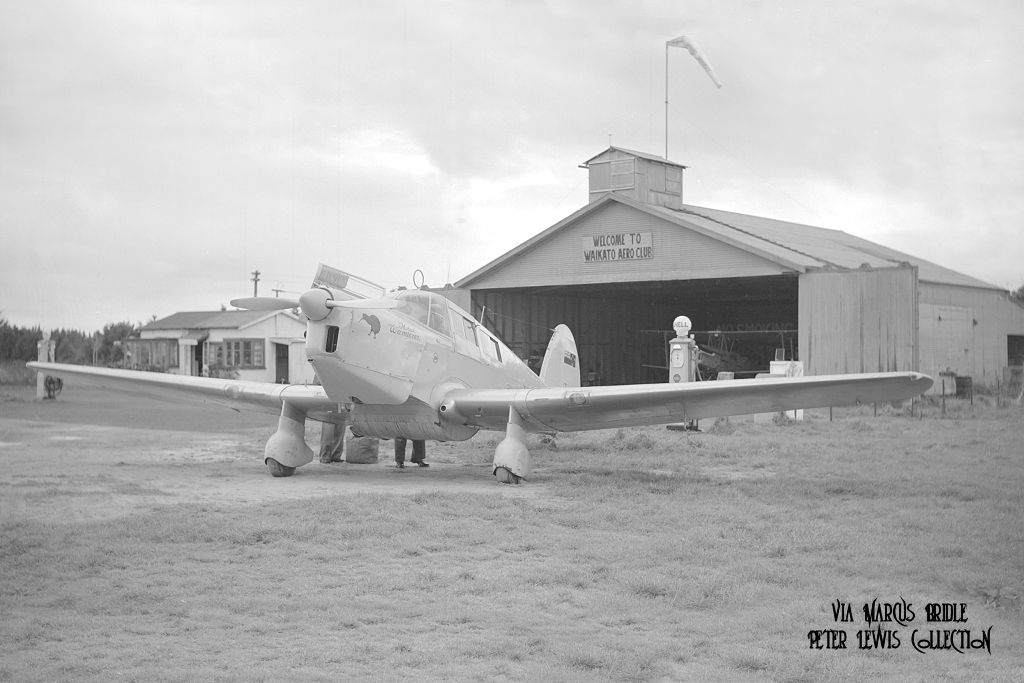 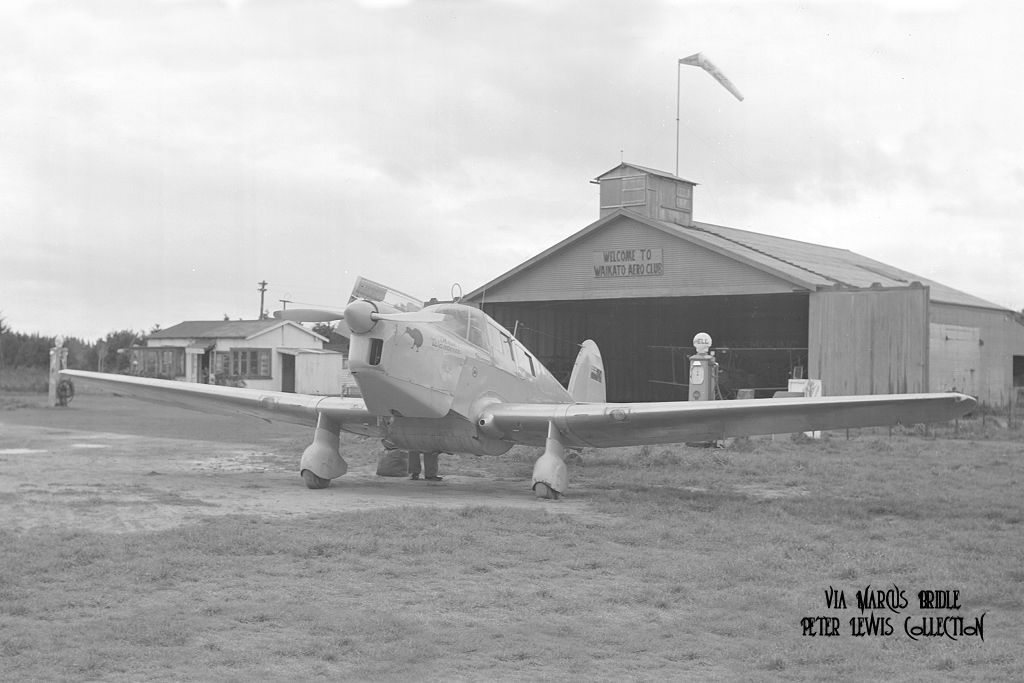 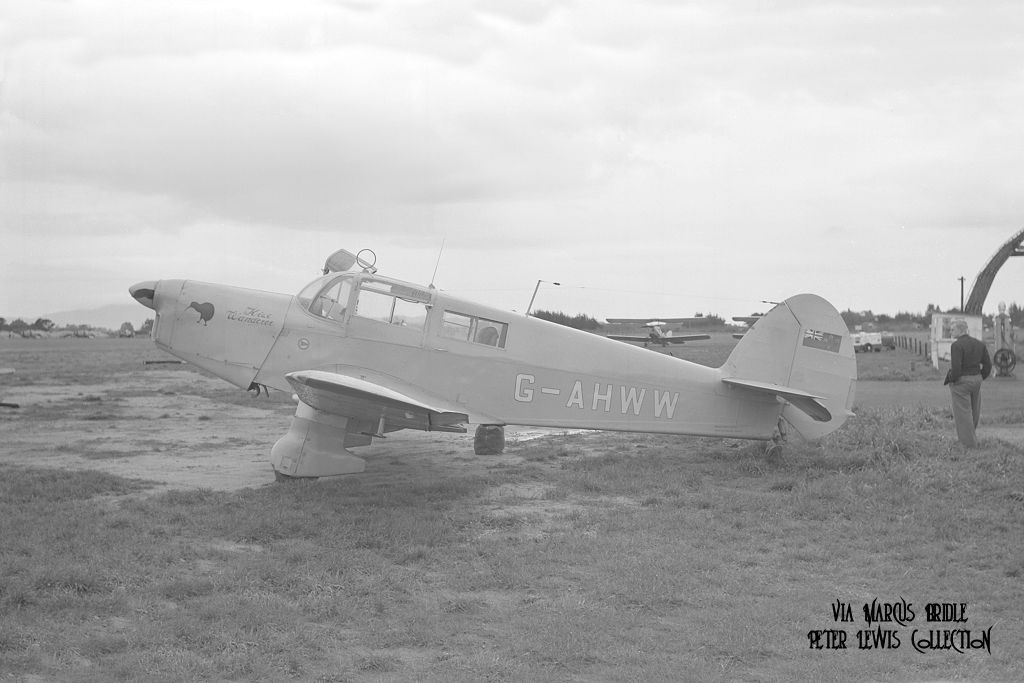 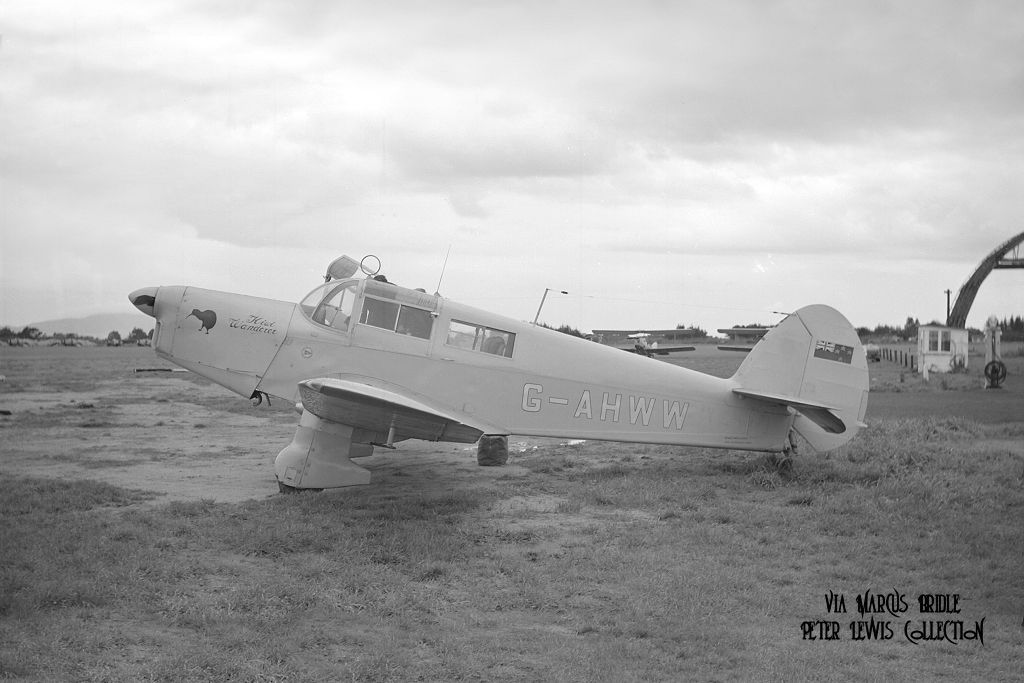 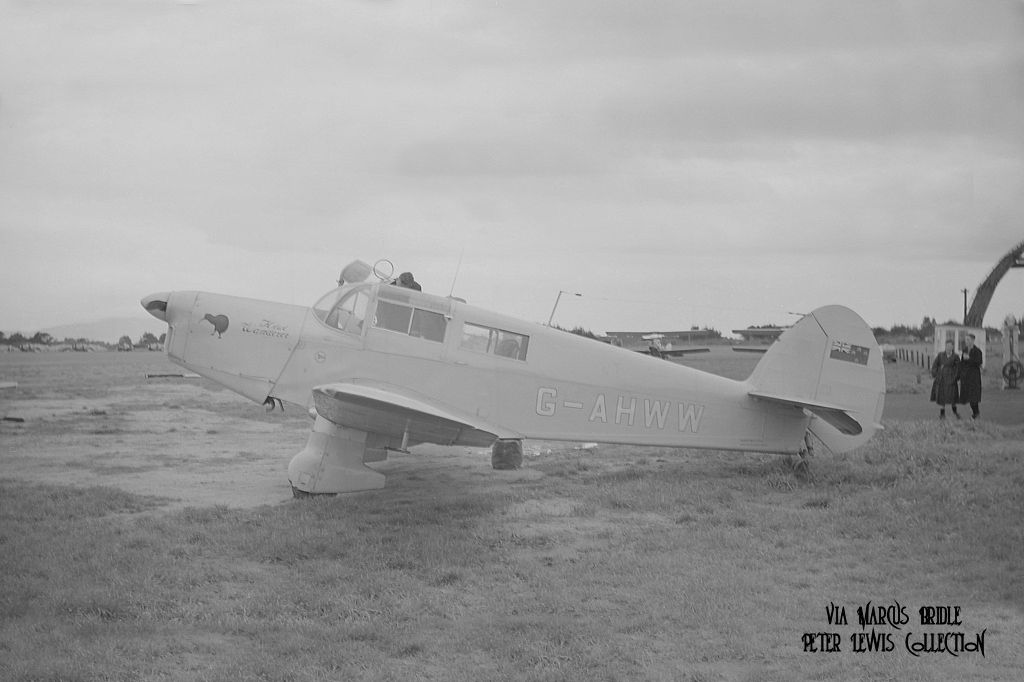 Now repainted as ZK-AVW, Paraparaumu 16Sep1954 Now repainted as ZK-AVW, Paraparaumu 16Sep1954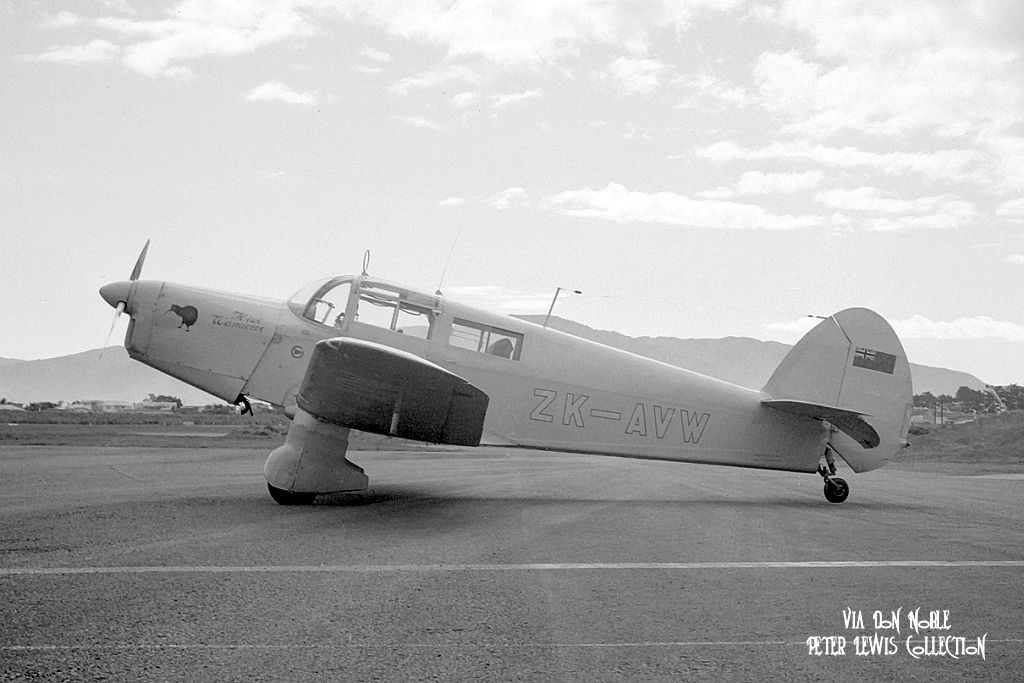 The registration of ZK-AVW, now visiting Mangere at a later date, appears to have changed to a darker colour. The registration of ZK-AVW, now visiting Mangere at a later date, appears to have changed to a darker colour. 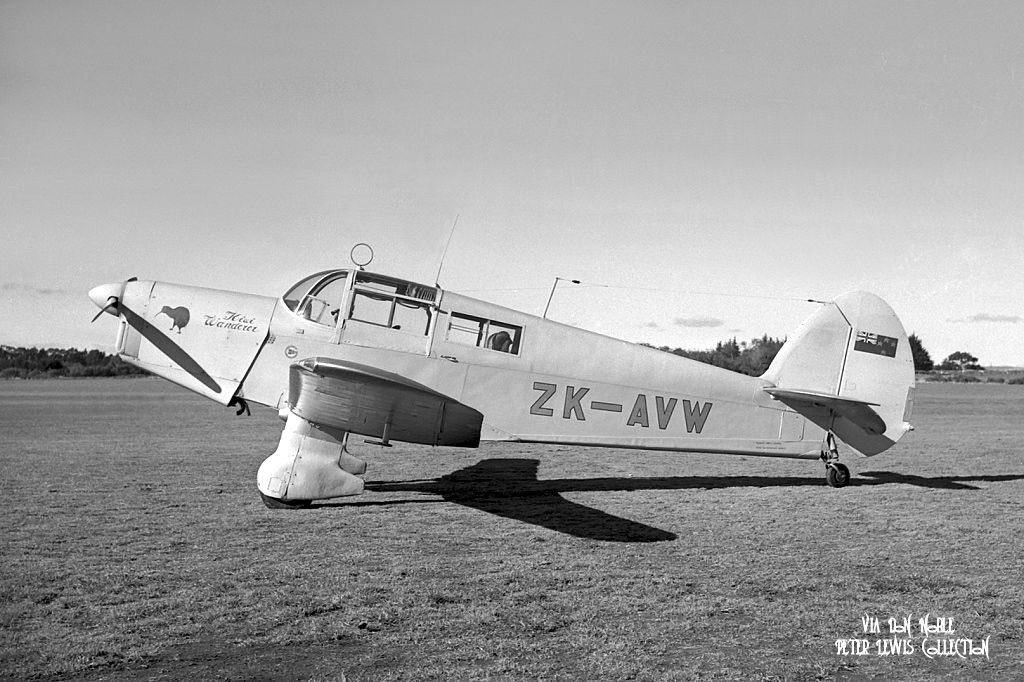 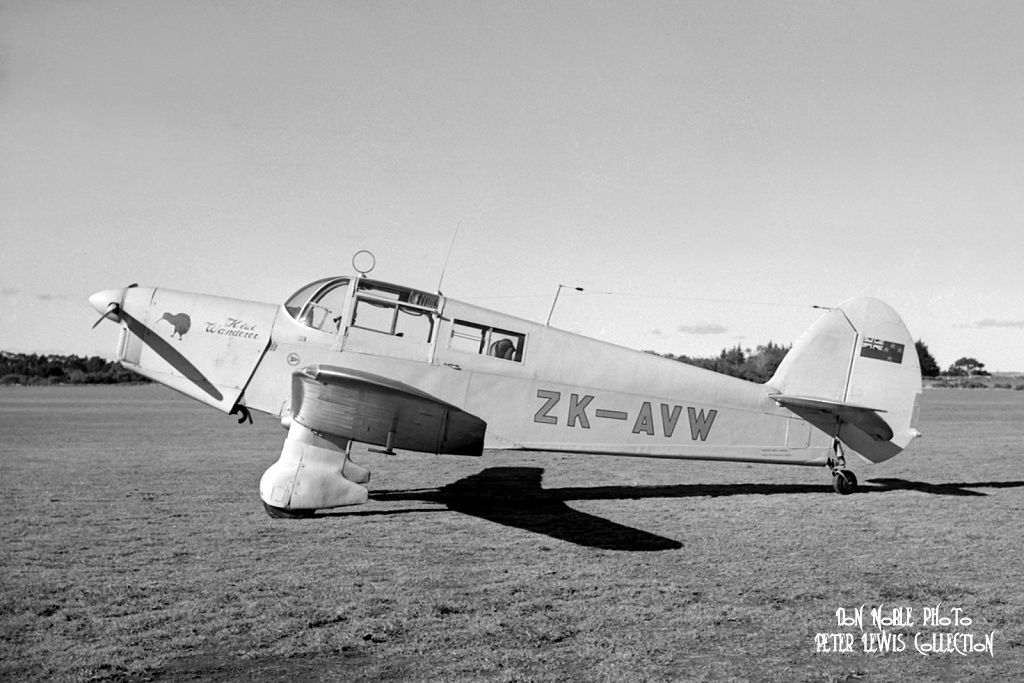 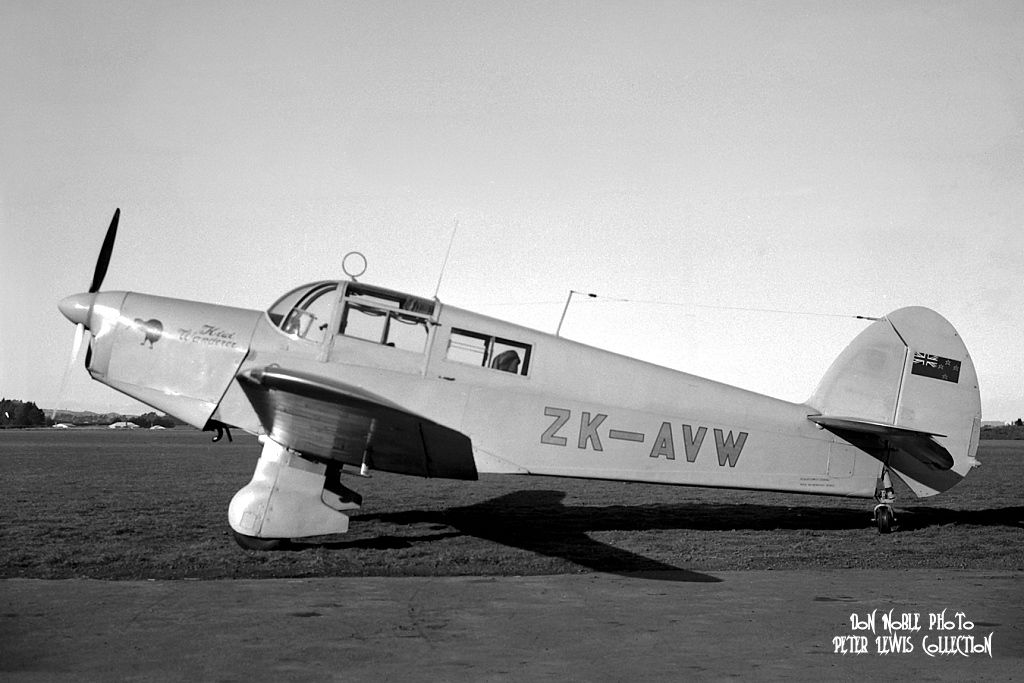 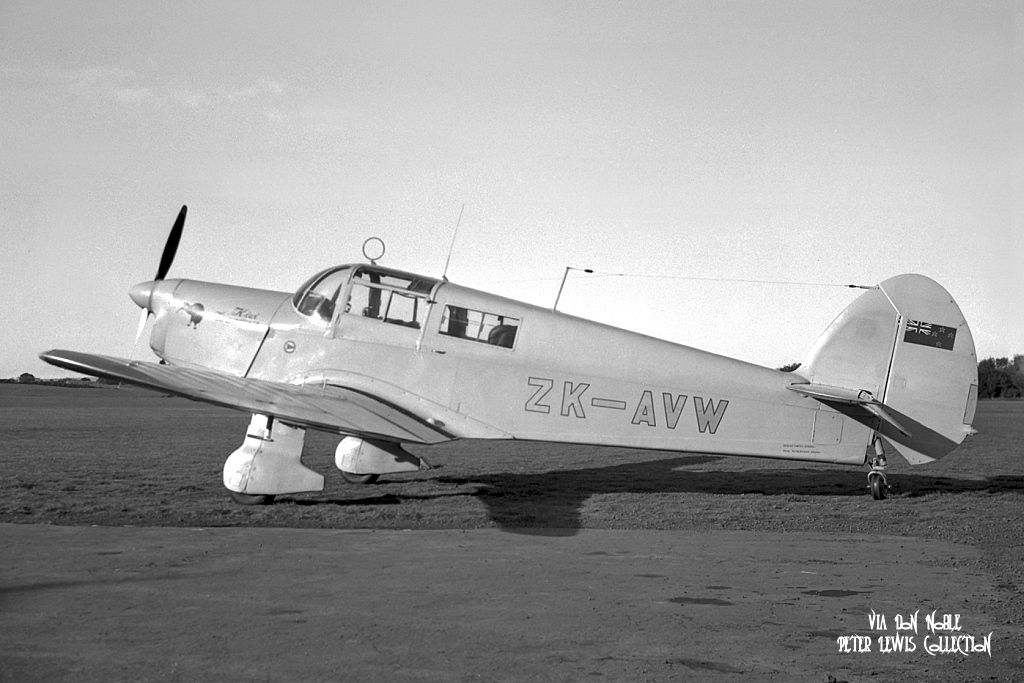 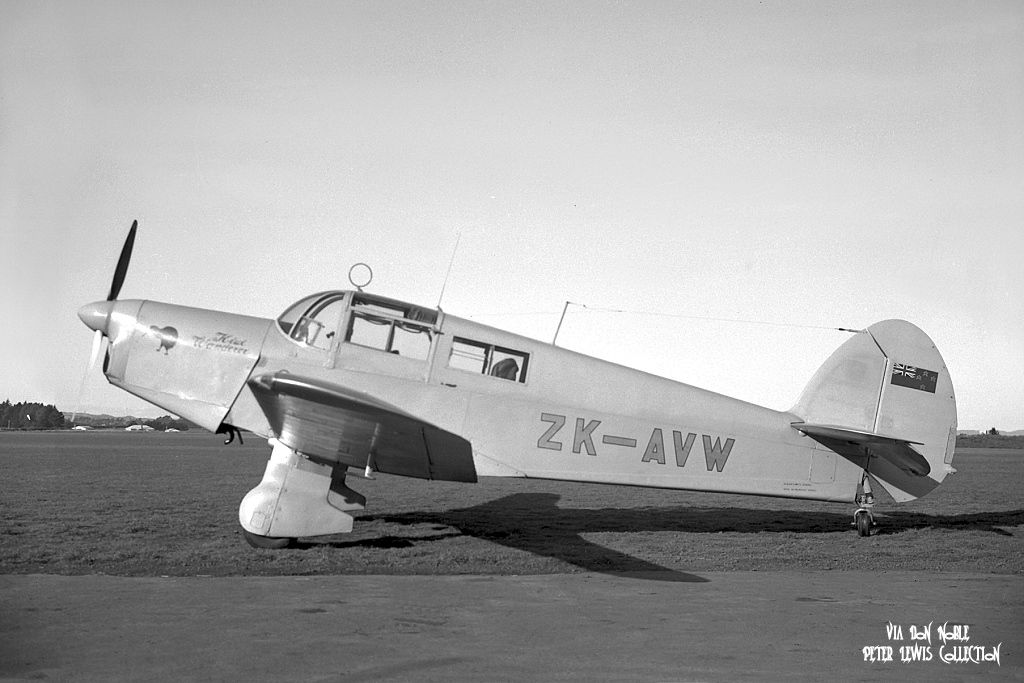 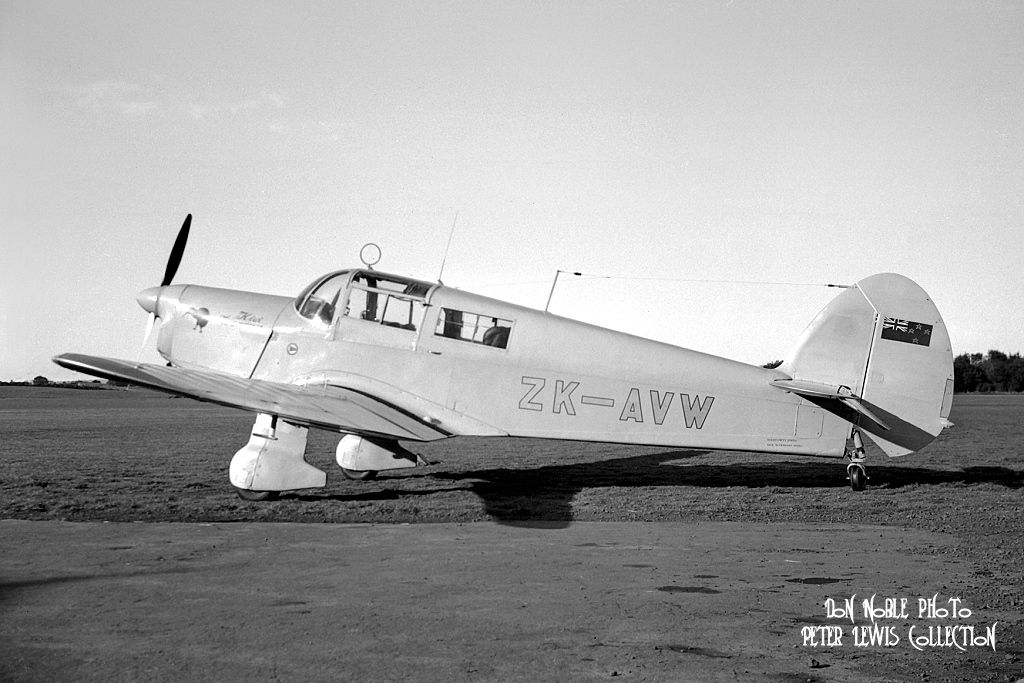 Changed again to a white infill colour Changed again to a white infill colour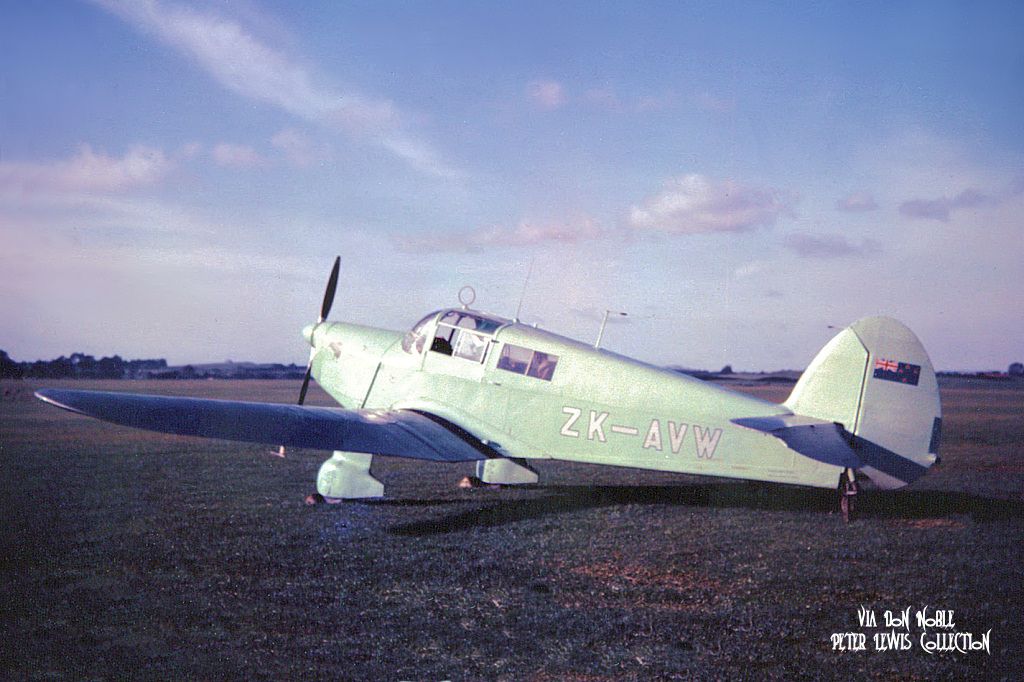 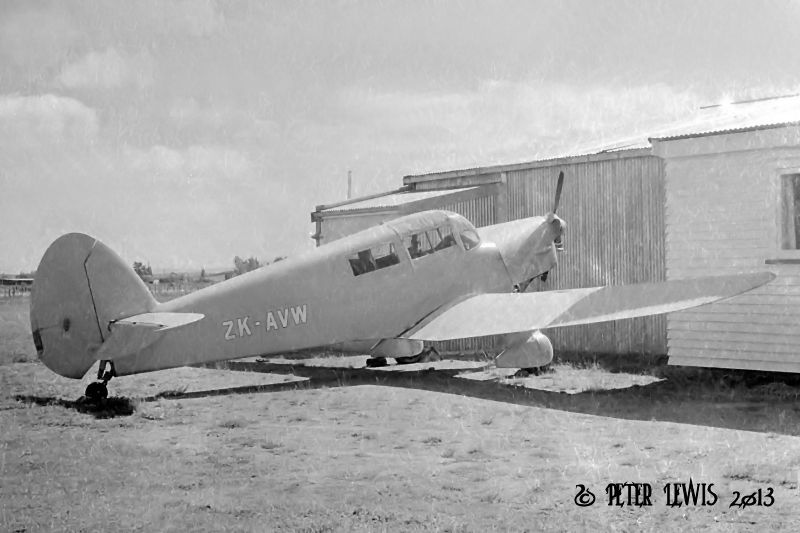 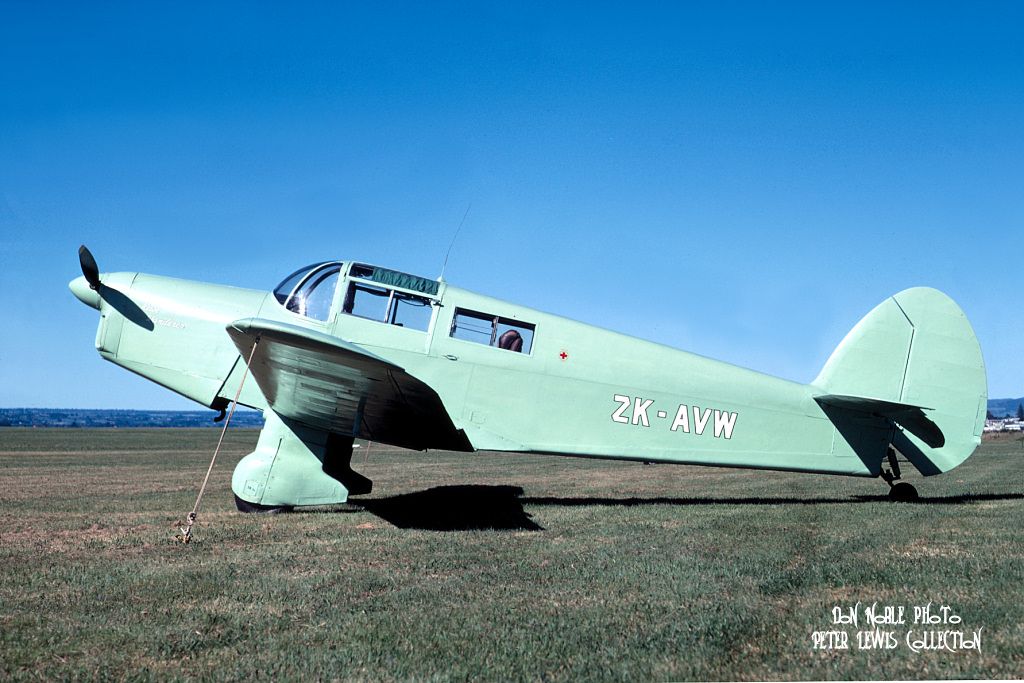 Parked in it's home hangar at Nelson, 19Jan1965. Now with the registration transferred to the tail and the kiwi silhouette removed. Parked in it's home hangar at Nelson, 19Jan1965. Now with the registration transferred to the tail and the kiwi silhouette removed.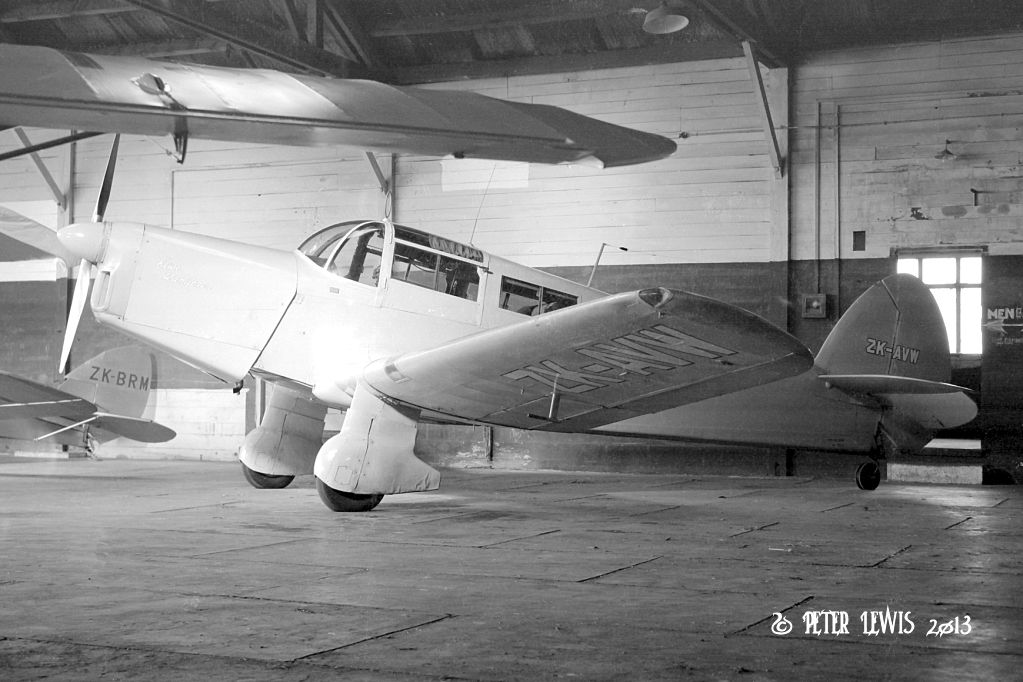 ZK-AVW at Ardmore ZK-AVW at Ardmore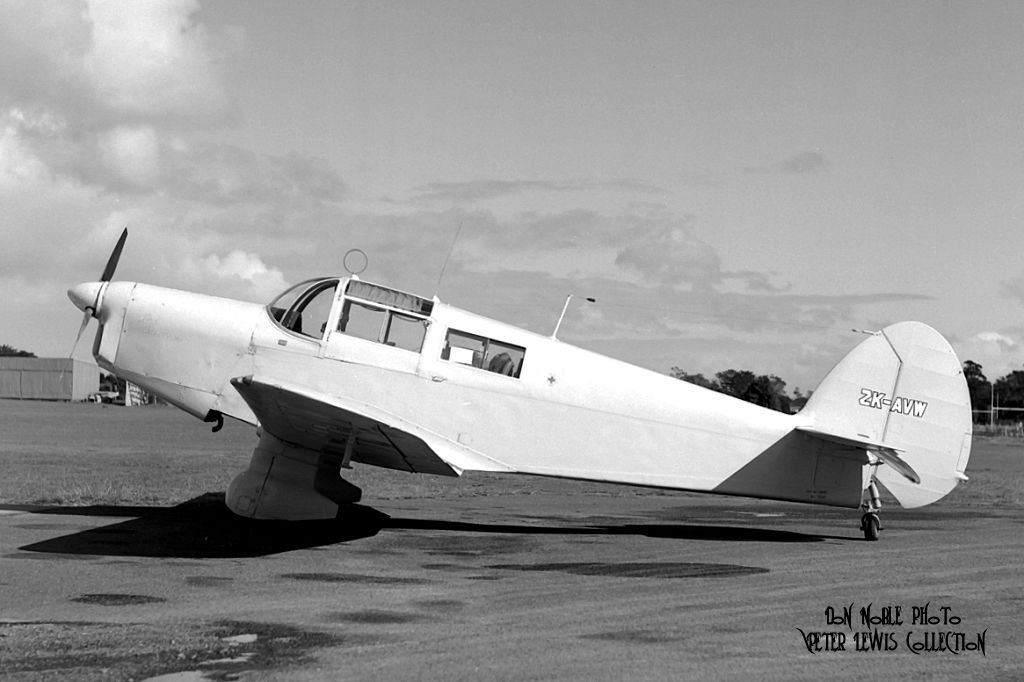 Closeup detail of the later version of the "Kiwi Wanderer" script Closeup detail of the later version of the "Kiwi Wanderer" script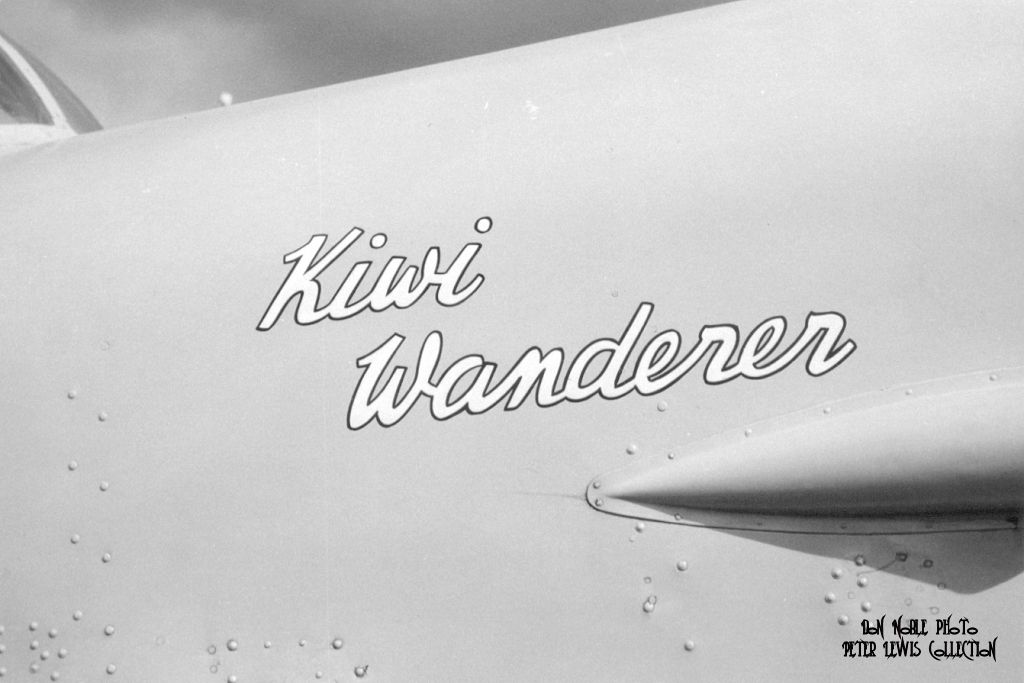 Contrast ZK-AVW at Ardmore 22Apr1967 Contrast ZK-AVW at Ardmore 22Apr1967 . . . 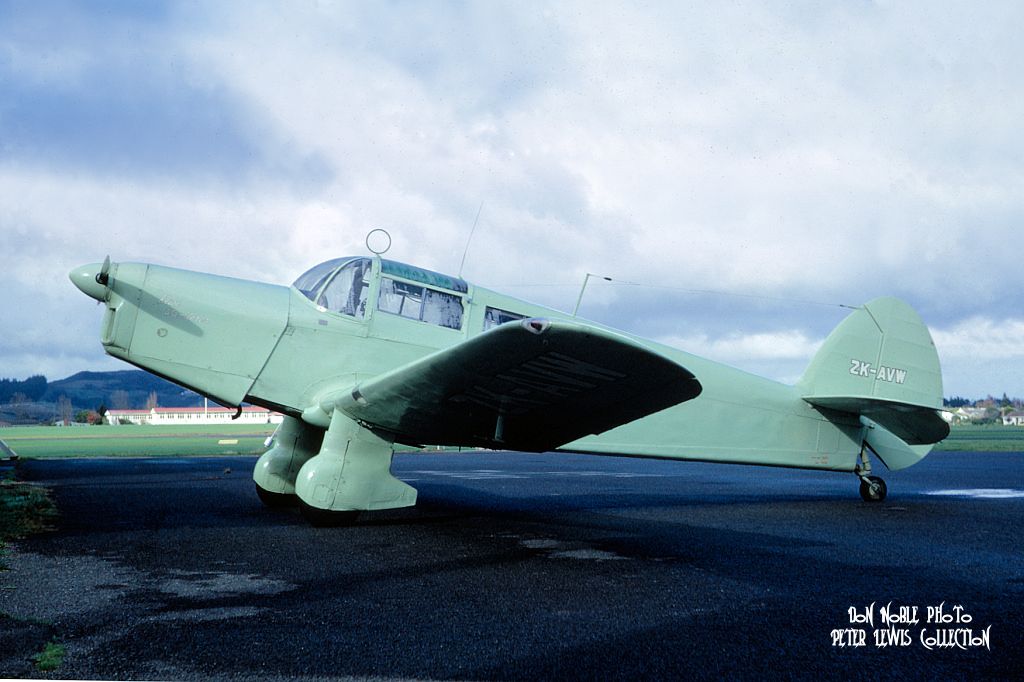 . . . and at Don's shed, Dairy Flat, 17Sep2014 . . . and at Don's shed, Dairy Flat, 17Sep2014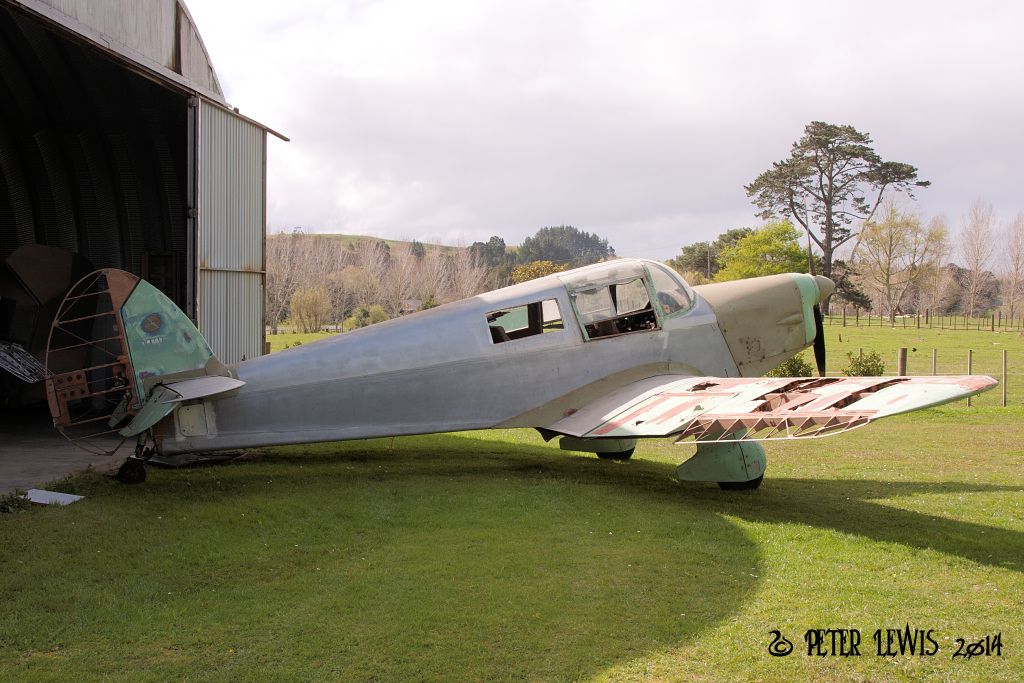 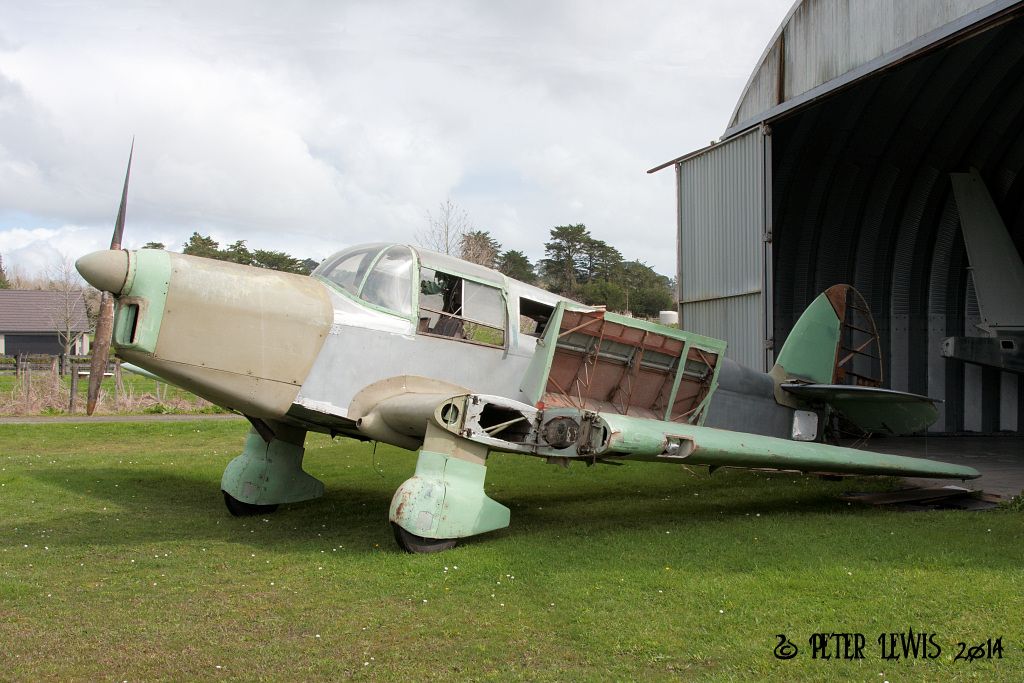 Panel view, 17Sep2014 Panel view, 17Sep2014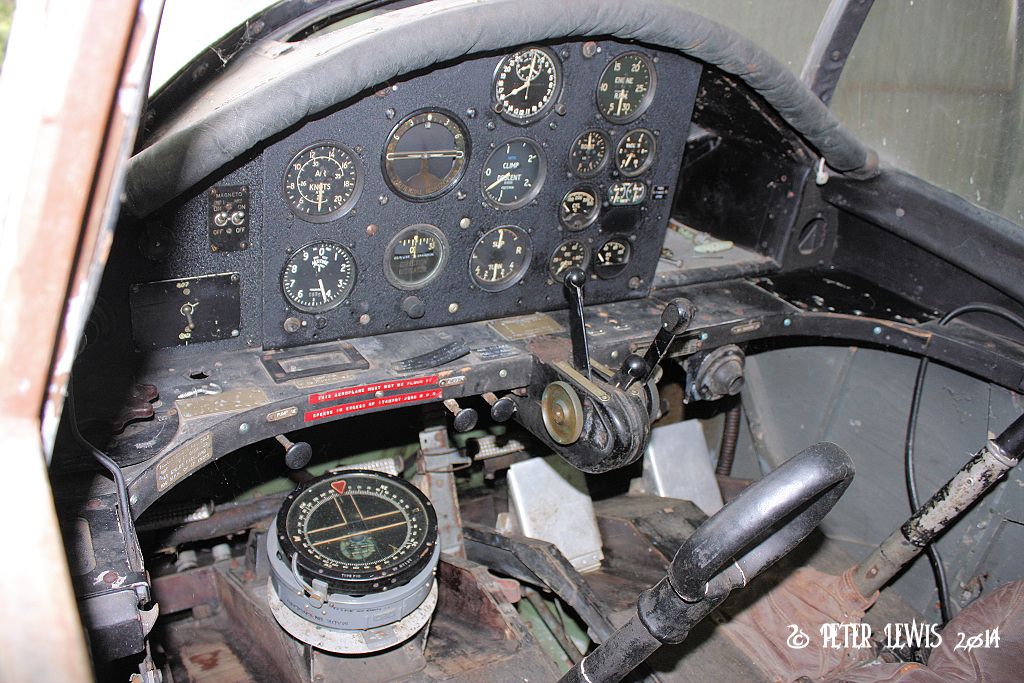 Strangely, although British aircraft post-war adopted the numeric model numbering system, and all references are to the 'Proctor 5', the Percival logo on the fin still refers to the 'Proctor V'. Strangely, although British aircraft post-war adopted the numeric model numbering system, and all references are to the 'Proctor 5', the Percival logo on the fin still refers to the 'Proctor V'.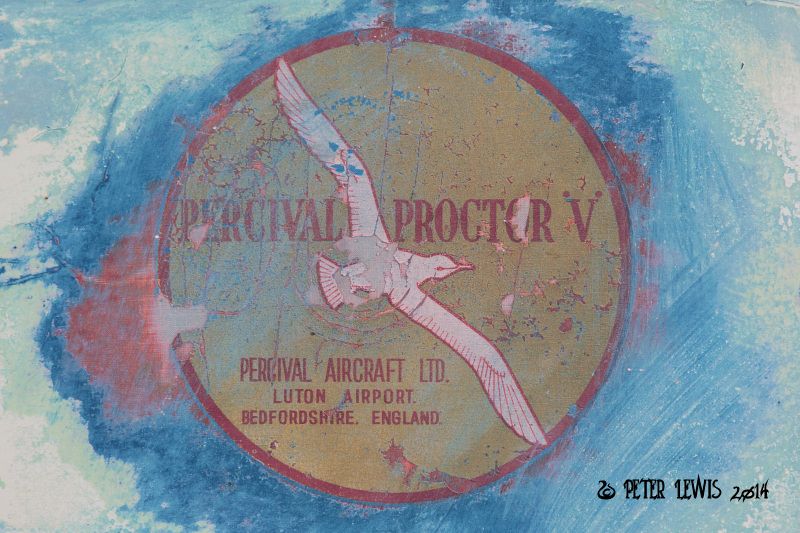 |
|
|
|
Post by Peter Lewis on Sept 21, 2014 22:31:01 GMT 12
Edgar Percival had resigned his position with Percival Aircraft Ltd. in 1940 and sold out his remaining financial interest in the company in September 1944. After living for some years in the USA he again became interested in aircraft design and visited both Australia and New Zealand in 1951 to gather information on the type of aircraft that would meet the demands of aerial work and aerial topdressing operators. Returning to the UK, Percival designed a high-wing single-engined aircraft that could accommodate a one-ton fertilizer hopper or four passengers or a considerable amount of freight loaded through rear clamshell doors. A new company, Edgar Percival Aircraft Ltd. was formed based at Stapleford aerodrome and the first aircraft of the new design emerged as the P.9 G-AOFU, carrying out its maiden flight there on 21Dec55. Retitled the E.P.9 to avoid confusion with earlier Percival designs, a production line was started and it was anticipated that at least 60 aircraft would be built. C/ns ran from 20 upwards, and the third aircraft built was c/n 22, test flown with the makers temporary registration of G-43-1 on 27Aug56. This was actually the second E.P.9 to fly, after the prototype. Built to an order from the Manawatu Aerial Topdressing Company Ltd. of Fielding, it was then shipped to New Zealand and became ZK-BDP on 1Oct1956. The E.P.9 arrival was well timed, as it was able to feature at the world’s first agricultural air show staged at Milson airfield, Palmerston North, in November 1956. It was on static display at that show, but I have been unable to confirm if it actually flew during that event. ZK-BDP then entered line service with MAT from their fielding base, but unfortunately did not survive for very long. It crashed and was destroyed during an early morning positioning flight when it hit a ridge at Rangiwahia near Palmerston North 19Feb58. The pilot David Ballard and his front-seat crewman Harold Carmichael were killed; a second crewman riding in the rear seat was badly injured but survived. From his report “The flight proceeded normally to Apiti Flats where the aircraft altered course and began to head over the hills for Rangiwahia. After about 6 minutes the passenger became aware that the visibility was deteriorating and he noticed the flaps being partially lowered and the airscrew being changed to fine pitch. Moments later the plane entered dense cloud and the flaps were lowered further and the engine noise increased noticeably. Within moments the passenger felt a high G loading which pinned him in his seat, and then a succession of severe impacts. The Percival struck a sloping ridge at about 100 mph, and slid down the other side, ploughing though trees and undergrowth for a distance of 265 feet and breaking up on the way. Fuel from the ruptured starboard fuel tank was ignited and the wreckage began to burn.” Sales of the E.P.9 did not live up to expectations, with engine overheating problems being experienced in Australia and competition from the Fu-24 and Cessna 180 in New Zealand. Only 21 aircraft were completed before Edgar Percival sold the enterprise to another company. E.P.9 ZK-BDP of the Manawatu Aerial Topdressing Company demonstrating at Fielding airfield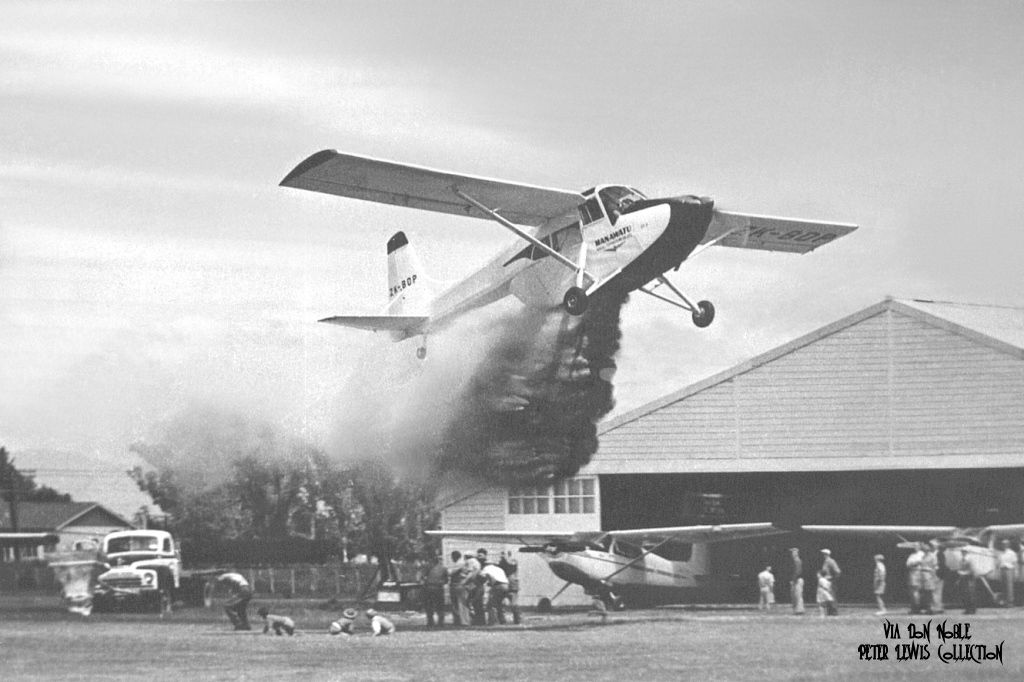 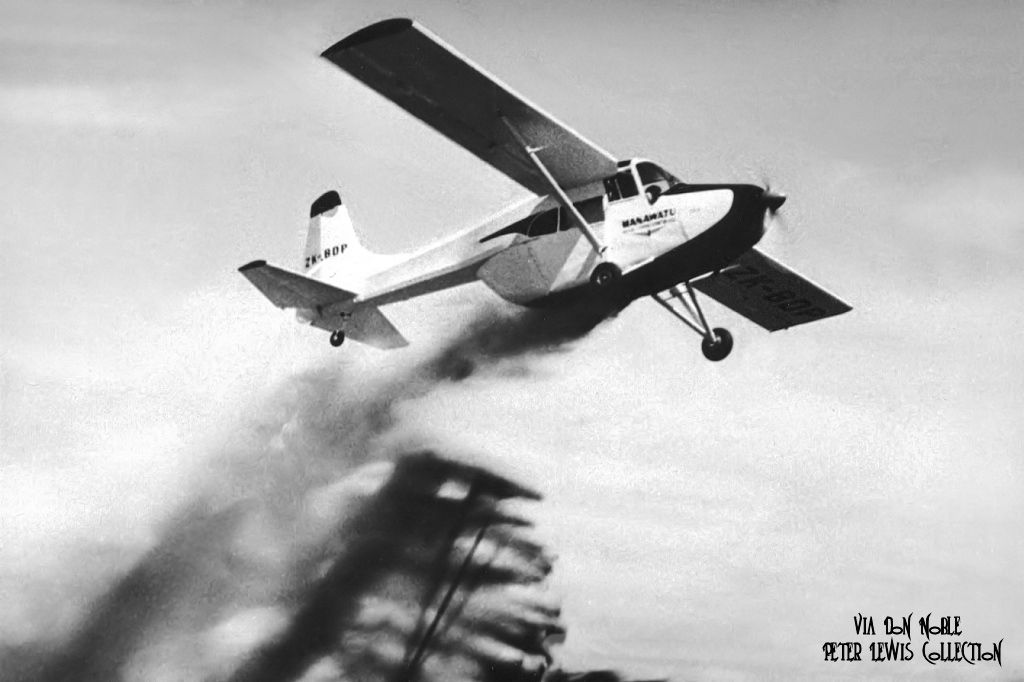 The Edgar Percival E.P.9 on static display at Milson, Palmerston North, 9Nov56. The Edgar Percival E.P.9 on static display at Milson, Palmerston North, 9Nov56.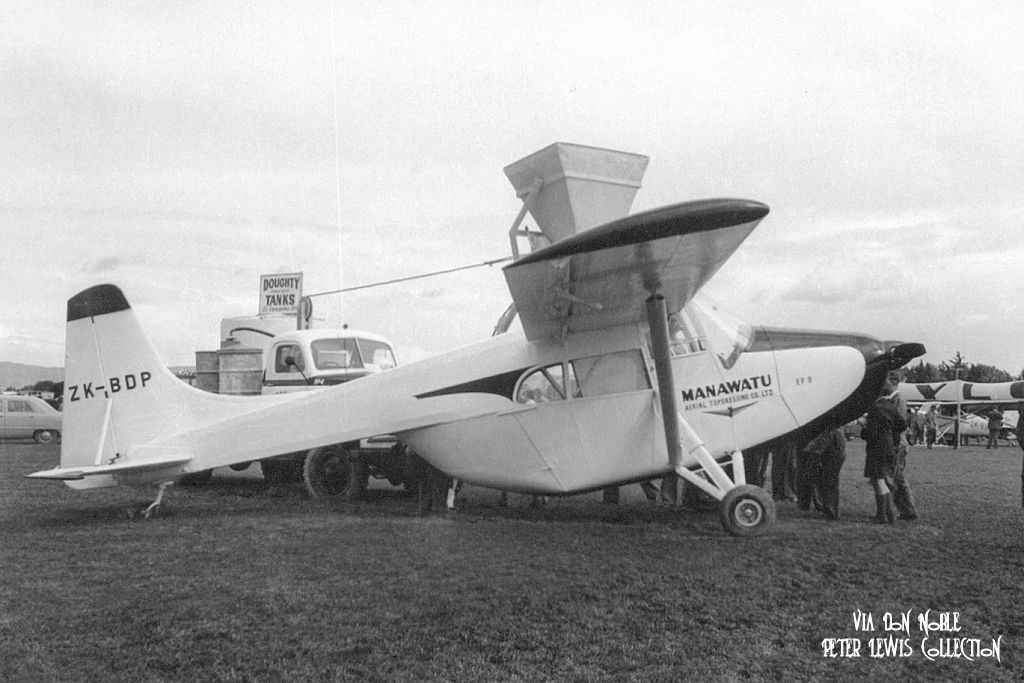 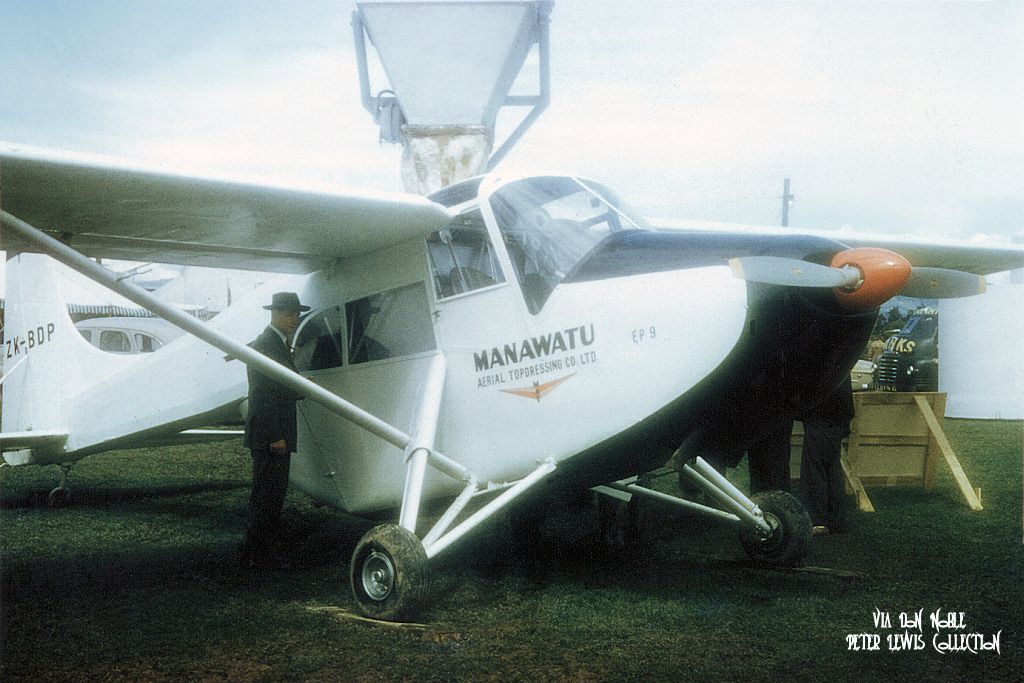 Out on the farm, ZK-BDP earning its living Out on the farm, ZK-BDP earning its living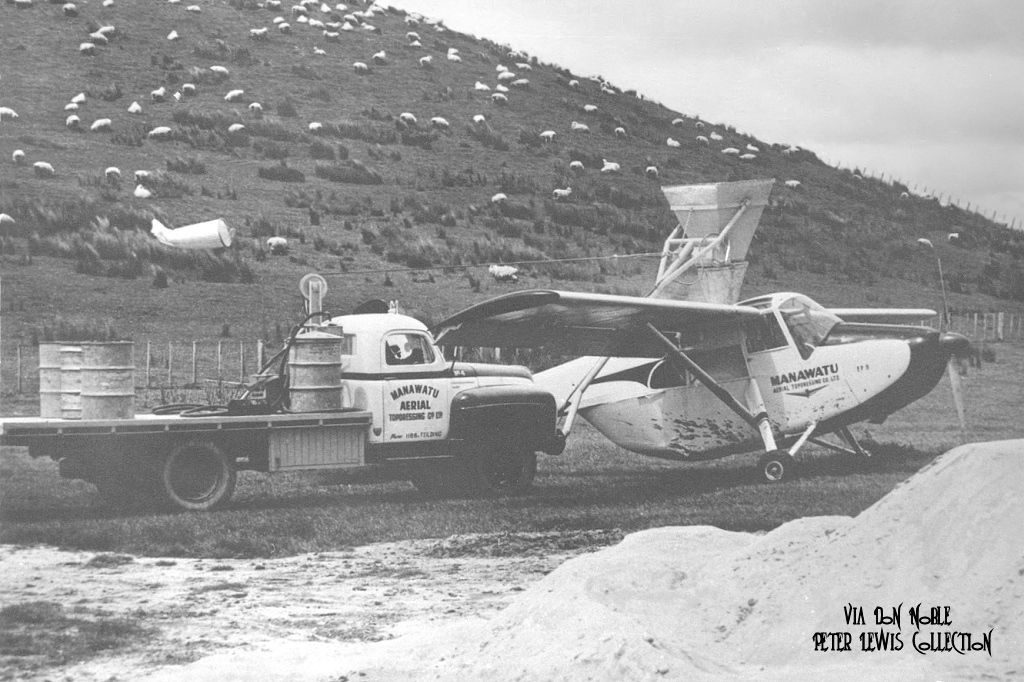  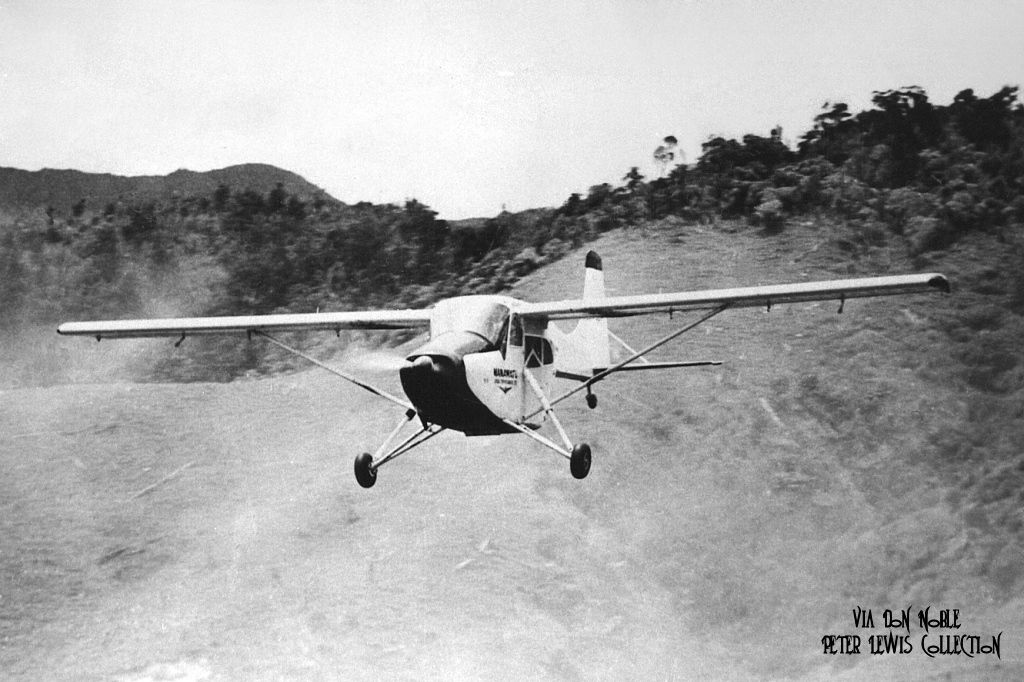 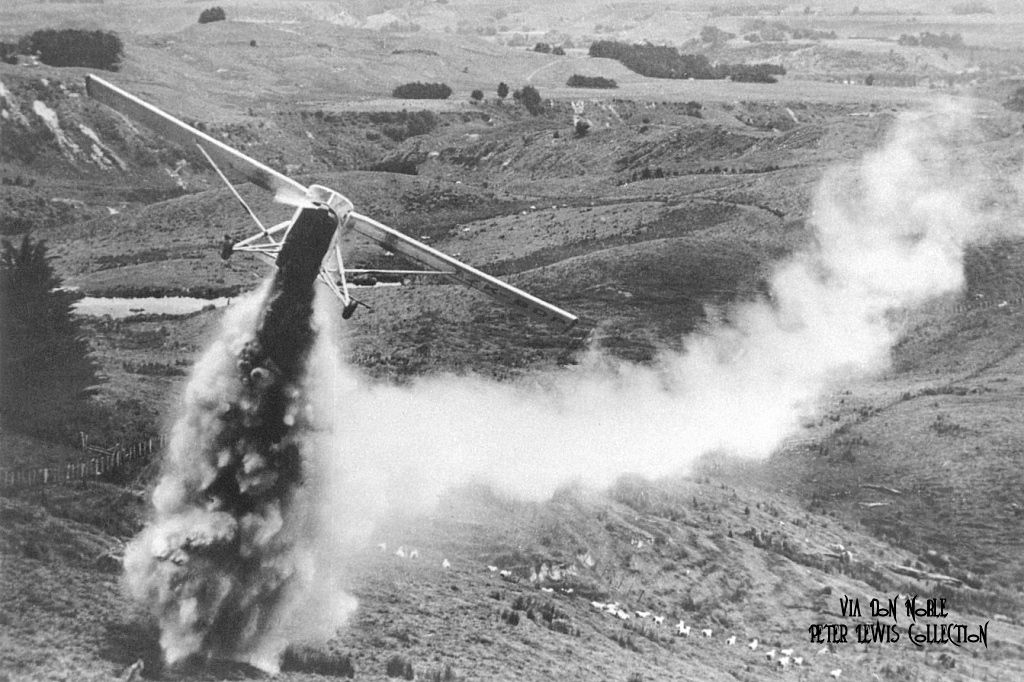 ZK-BDP returning to Fielding home base ZK-BDP returning to Fielding home base  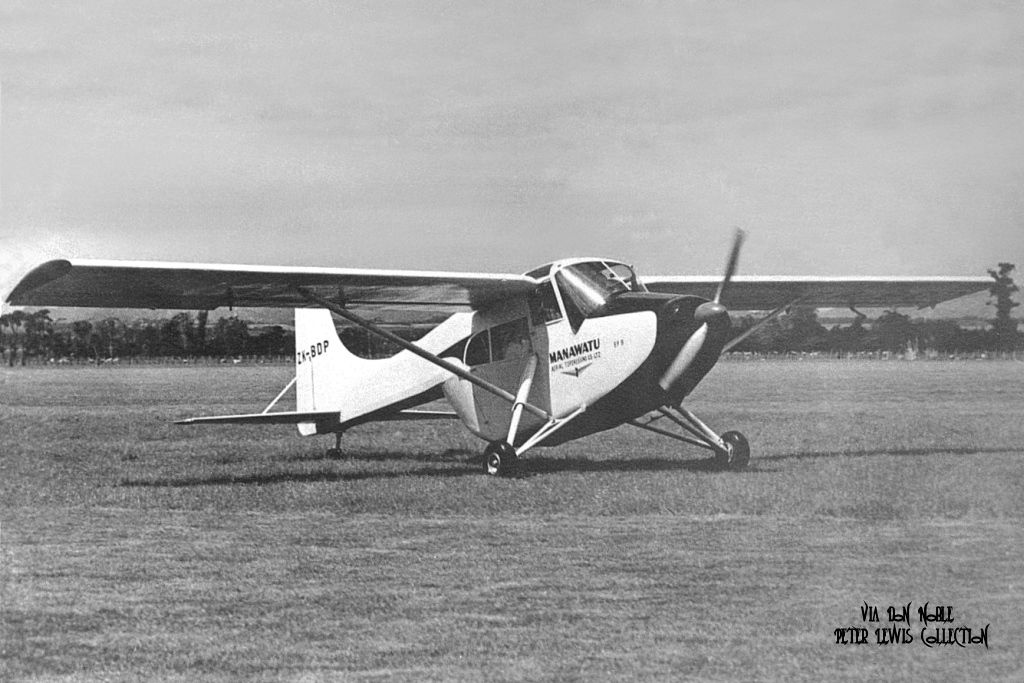 Not just a topdressor, the E.P.9 could also carry underwing drop loads Not just a topdressor, the E.P.9 could also carry underwing drop loads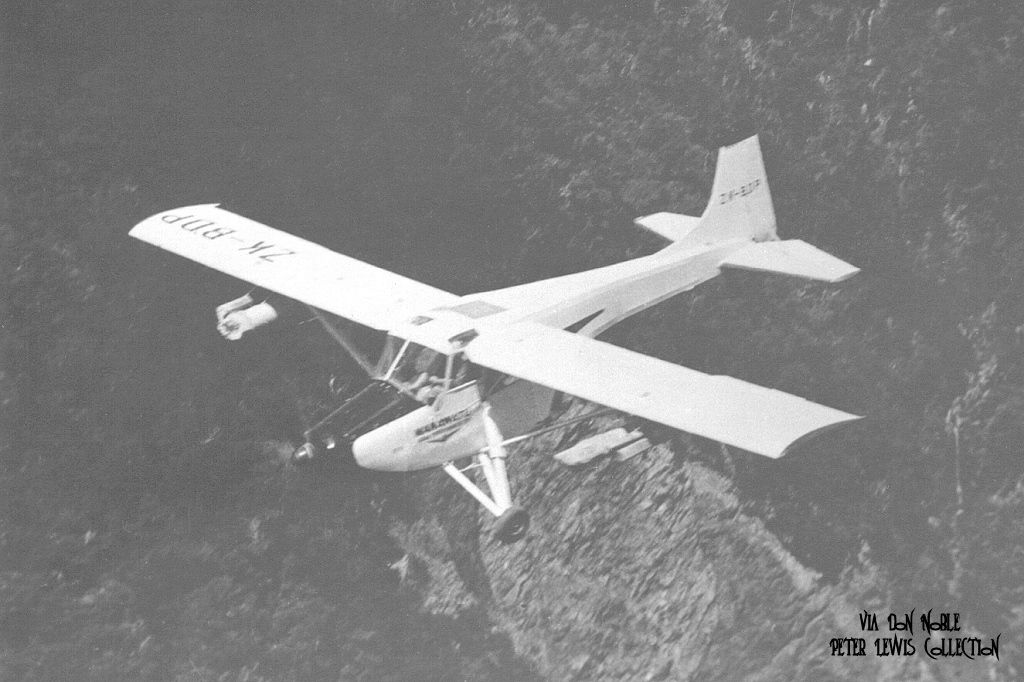 |
|
|
|
Post by Bruce on Sept 22, 2014 8:30:25 GMT 12
Those spectators outside the hangar at Fielding don't look very impressed!
|
|
|
|
Post by davidd on Sept 22, 2014 10:10:49 GMT 12
Bruce,
Perhaps somebody told those spectators that there were lots of sixpences mixed up with the load of superphosphate! Looks like lots of kids were involved in scrabbling in the grass. Only kidding, but why would everybody be looking at the kids on the left? Something seems to be of deep interest to them.
The EP 9 is certainly an, er, INTERESTING looking aeroplane, perhaps it was designed to be practical, but it really does look heavily pregnant. The recollection of the fatal crash by the third man certainly has a most uncomfortable feeling about it, particularly the bit about it getting darker - a bit like the Dash Eight near Palmerston North all those years ago.
David D
|
|
|
|
Post by Bruce on Sept 22, 2014 10:20:38 GMT 12
looks to me more like they are trying to avoid a face full of superphosphate....
|
|
|
|
Post by Dave Homewood on Sept 22, 2014 12:59:18 GMT 12
That is such a stupid place to drop a load of fertiliser, even if the pilot was trying to impress during the demo.
How many times afterwards would aircraft starting, running and taxiing outside that hangar have blown fert everywhere - and into the hangar - in the weeks afterwards?
And also I guess they would have ended up with a patch of thicker, longer grass right there too, right where you wouldn't want it. Plain sillyness.
|
|
|
|
Post by Deleted on Sept 22, 2014 15:20:26 GMT 12
Bizarre ag demo planning aside, Peter this is a wonderful thread. I have a real soft spot for the pre-Proctor V lineup of Percivals and there are some beautiful examples, and stunning photographs, shown here. It's great to see there are several more examples still extant in NZ than I thought. 'AVW especially is a real treat to see.
|
|
|
|
Post by Peter Lewis on Sept 25, 2014 21:19:12 GMT 12
The Percival Prince was a post-war entry by the Percival Aircraft Company into the light transport market. Three of these high-wing twin-engined Prince C Mk.1 aircraft were ordered by the Australian Government for use in servicing the Woomera rocket range and the atomic bomb testing grounds in Australia. The three aircraft were incorporated into the British military order and thus were allotted RAF serials, but were delivered as new to the RAAF in 1952. Two of the three were damaged during their RAAF service, but A90-1 (c/n P50/38 which had been allotted the RAF serial WZ409), stored since December1955, survived to be passed on to the Royal Aero Club of NSW where it became VH-RSX on 15Jan58 as a Prince Mk.3 The intention was that the Prince would replace the club DH84 Dragon in the role of a twin-engine IFR training aircraft. However, the much higher charge-out rate required for VH-RSX meant that it saw little use. Meanwhile Australian Sir Reginald Barnewall had emigrated from Australia to Western Samoa and planned to start a scheduled airline connecting Apia to Pago Pago in American Samoa. After forming Polynesian Airlines Limited in 1959 he found that the aero club had VH-RSX for sale. It had full instrumentation, navaids and radio, no accident history, and was fitted with seating for 10 persons with a toilet and spacious baggage hold. At that time the aircraft had flown 1400hrs and came with a substantial spares holding. The purchase was duly completed, and the Prince became ZK-BMQ under PAL ownership on 17Jun59 with the Australian registration being cancelled on the 26th. The aircraft had been named Princess Maureen after Barnewall’s wife, but this was displayed on the cockpit instrument panel rather than being painted on the outside of the aircraft. ZK-BMQ left Brisbane airport on 7Jul59 and flew via New Caledonia and Fiji to Faleolo airport near Apia, arriving there on the 12th. After engaging in some charter flights over the following months, scheduled services between Apia and Pago Pago commenced on 7Mar60. However, the aircraft came to grief just a few months later. While landing at Faleolo on 3Dec60 inbound from Pago Pago the starboard main wheel tyre had become deflated. Consequentially the aircraft veered off the runway and collided with a deep concrete drain at the side of the airfield. Although there were no injuries, the aircraft was sufficiently damaged to be deemed unrepairable. Stripped of any useful parts, the airframe sat at Faleolo for some time, at least until 1966. The registration ZK-BMQ was cancelled on 7Jun61. Percival Prince ZK-BMQ at Fiji in July 1959 during the delivery flight to Samoa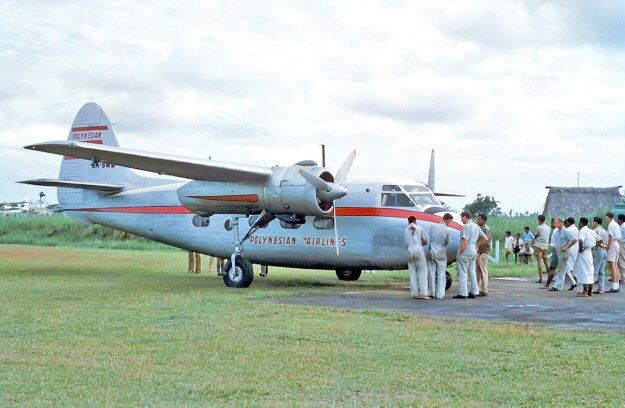 photo from Civil Aviation Historical Society of South Australia via Geoff GoodallZK-BMQ active in Samoa photo from Civil Aviation Historical Society of South Australia via Geoff GoodallZK-BMQ active in Samoa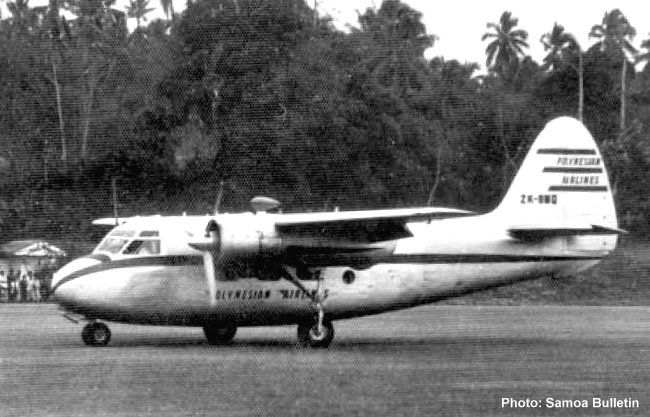 ZK-BMQ derelict at Faleolo ZK-BMQ derelict at Faleolo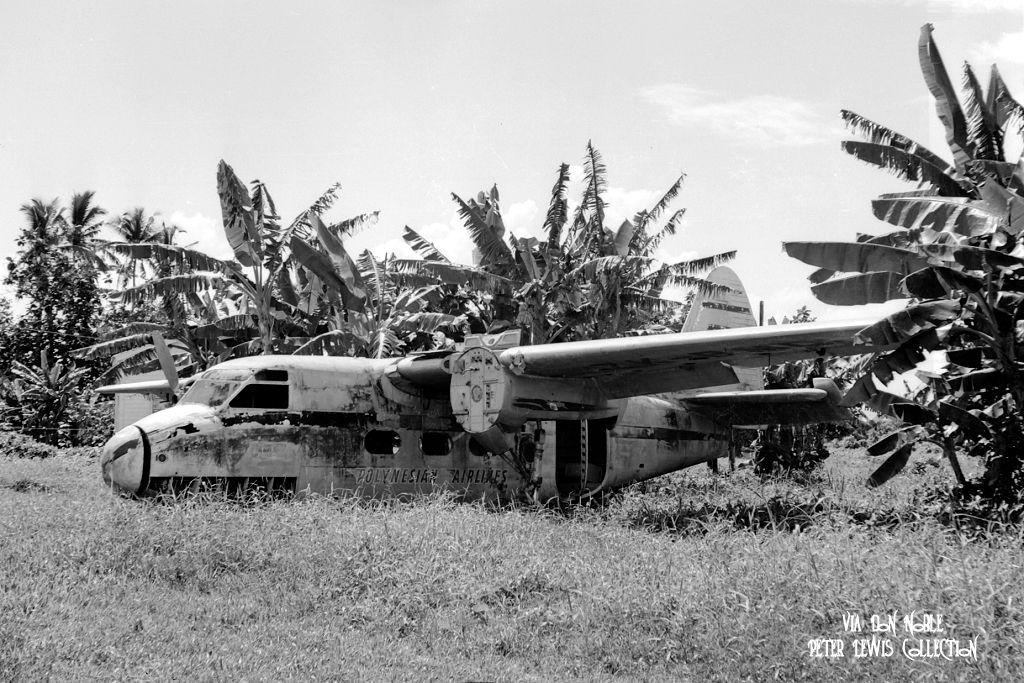 Probably because of its short life, few photos of ZK-BMQ seem to be available. However, I have tracked a reference to a home movie held by the NZ Film Archive that purports to cover " Polynesian Airlines Percival Prince airplane ZK-BMQ taxis on grass runway. Large group of people gather around plane, Captain joins people. Group of three men, two smoking pipes. People climb inside aircraft". I shall be visiting Wellington in late November, and will attempt to arrange to view this item at that time. |
|



